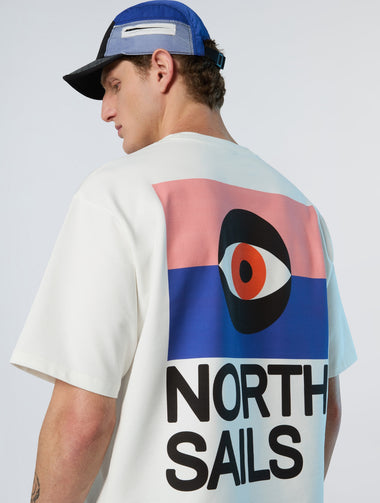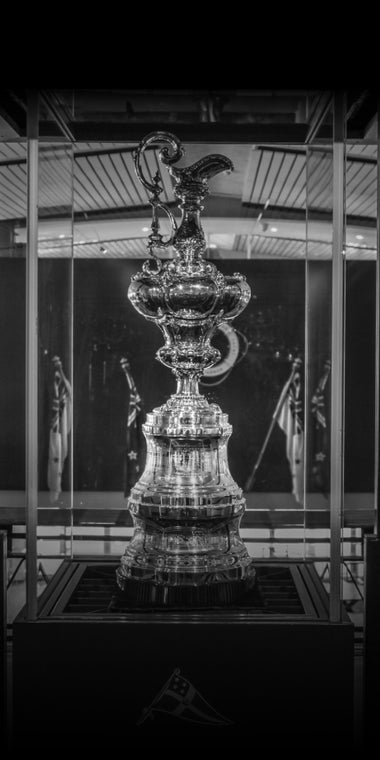NORTH SAILS BLOG
All
Events
Guides
News
People
Podcast
Sustainability
Tech & Innovation
Travel & Adventure
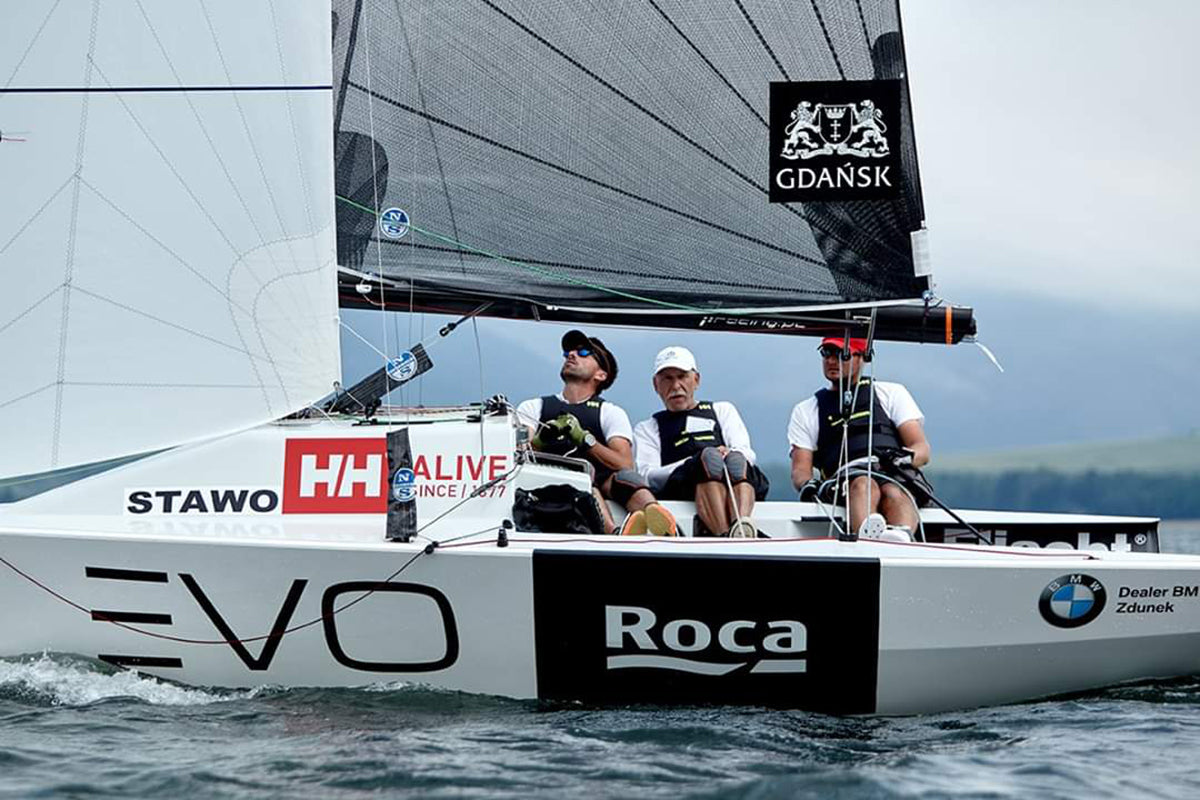
PIOTR TARNACKI WINS MICRO WORLD CHAMPIONSHIP
PIOTR TARNACKI WINS MICRO WORLDS
Eight-Nation Battle In Slovakia In Super Light Conditions
Thirty-six crews from eight nations battled it out at the Worlds in Slovakia, hosted by Marina Liptov. With light wind conditions, the fleet could only complete five out of the fifteen planned races. Scoring 1,4,1,1,1 results POL 77, with Piotr Tarnacki at the helm, secured the Championship title – their 3rd World Champion title in a row, and 9th Micro Class World championship title for Piotr Tarnacki. Superb performance was also shown by second place POL 290 helmed by Marcin Celmerowski with 2,6,2,2,2 places. Special mention too for POL 15, who could only sail with a 2 person crew – Piotr Kowalewski and Rafał Trzciński, winning the Racer Division with a massive 23 point advantage. Maciej Grodzki took the Bronze medal in the Racer division on POL 80.
North-Powered Boats:
1. POL 77 Piotr Tarnacki
2. POL 290 Marcin Celmerowski
4. RUS 174 Arkadiy Kistanov
5.POL 88 Maciej Twarowski
Racer Divison :
1. POL 15 Piotr Kowalewski
3. POL 80 Maciej Grodzki
North Sails powered teams used the new Super Light SS-1-0,5 Spinnaker and improved for 2019 Jib JK-1L with the MK-1 Mainsail.
Learn more about our fast designs for the Micro class.
READ MORE
READ MORE
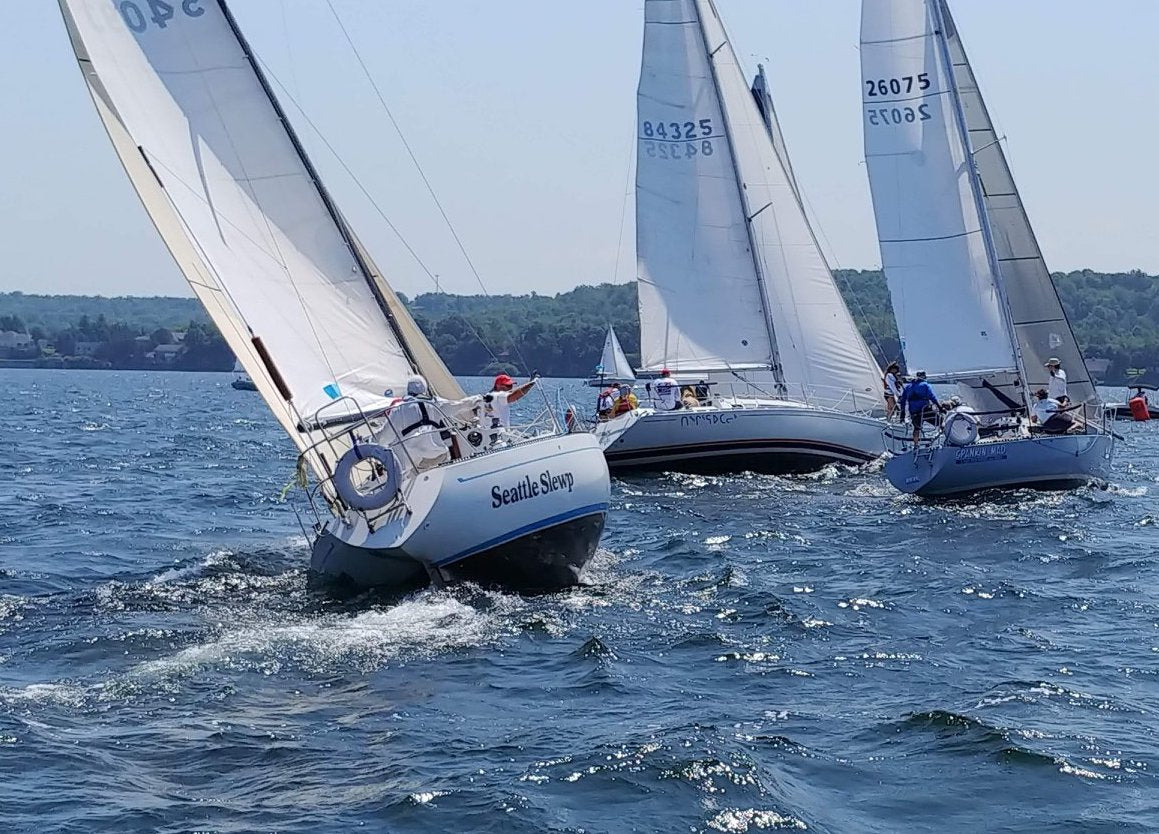
EVENT SPOTLIGHT: EASTERN YACHTING CIRCUIT 2019
EVENT SPOTLIGHT: EASTERN YACHTING CIRCUIT
A July Gem Of A Regatta
At North Sails, we don't forget the importance of supporting the club racers. The Eastern Yachting Circuit is a longstanding, friendly competition between ten Canadian and American clubs in Lake Ontario. EYC epitomizes what club racing is all about. Many of the sailors have lost count on how many EYC regattas they've attended. For some, they are the 2nd and even 3rd generation racing. It's a PHRF regatta with one-design classes, like the Sharks, getting their own start if numbers warrant. What began many years ago as a circuit like the Lake Erie Inter-club Cruise, has settled on one club hosting the regatta each year. Alternating between American and Canadian clubs, the 2019 edition hosted by Henderson Harbour Yacht Club lead by regatta chair Tom Tomlinson, Art Bronstein and their team of volunteers. A lovely understated club nestled in a well-protected cove in Henderson Bay, about 30 minutes southwest of Watertown NY. Henderson Harbour YC was to have hosted in 2017, yet high waters forced the last-minute change in venue to Oswego Yacht Club. It speaks to the camaraderie and spirit between clubs to step up and help each other out for the good of racing.
The record-high waters returned in 2019, but the team at Henderson Harbour persevered. They made allowances and contingency plans so the show would go on. And it did! Everyone attending was from a club that was dealing with the same high-water issues. Enough said.
Despite record-high water levels and the unpredictable weather of the spring season, nearly 30 boats came out to play. Henderson Bay so idyllic but it can be difficult to find lodging for crews and families. The solution for many is to travel with a 'mothership' or bunk boat. Not only does this add convenience but also provides a vibrancy on the docks before and after racing. This PHRF regatta is distinguished by a middle distance race of 20 to 30 miles on Thursday followed by two days of windward/leeward course racing. Small fleets of 5 or 6 boats get their own starts. The opening distance race provided a chance to see the local sailing waters; Association, Stony, Little Gallo and Calf Island to name a few while working out kinks and getting acquainted with new crew members. Old rivals duke it out. Newcomers jump right into the mix. The course racing was in the protected but windy waters of Henderson Bay. Of course, the competitive juices flow, yet it remains friendly. Protests were minimal with infractions settled by a quick circle, or later, a round off adult beverages bought by the offending crew.
A number of North Sails clients found themselves at the top of the fleets, including Art Bronstein's Hambone, a well-trimmed C&C 35 and overall circuit winner, Tom Doran racing an immaculate J-24 Oz. As a sponsor to the regatta, North Sails, understands the importance of 'grassroots' regattas to sustaining our sport. The owners and crew want sails that are well built, fast that last more than a season or three. North Sails delivers every time.
READ MORE
READ MORE
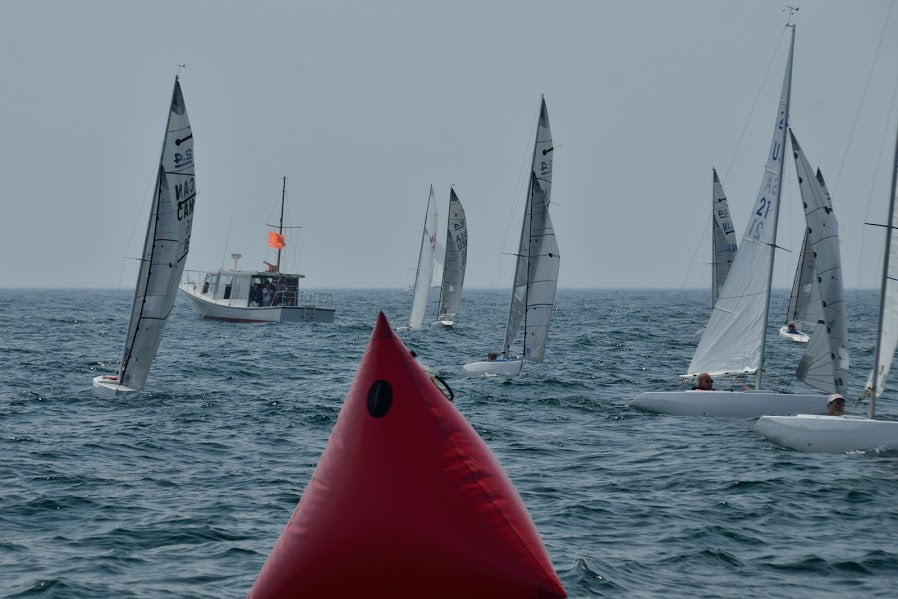
CANAM SERIES HEADS NORTH
CANAM SERIES HEADS NORTH
2.4mR Great Lakes Regatta
This past weekend, the 3rd regatta of the 2.4mR CanAm North Regatta Series was hosted by National Yacht Club. Participants travelled from Florida, Maryland, Connecticut, Wisconsin, Montreal and Ottawa to compete with the local NYC 2.4 fleet. The 15 boat fleet sailed 7 races to complete the regatta. In 3rd place was NYC’s Darrell Suderman, in 2nd place, Dee Smith of Annapolis, and in 1st place, NYC’s Allan Leibel. The 2.4mR Canadian Championship, hosted by NYC on Sept 7/8, will be the fourth and final regatta of the 2.4mR CanAm North Series. Initiated in Port Charlotte FL several years ago, the 2.4mR CanAm Series has been a fantastic venue for Canadian sailors to get competitive racing with minimal logistics over the winter months. This is the first year for the ‘North” version of the CanAm series. North Sails Toronto is proud to support such an interactive and vibrant fleet; congratulations to all participants!
Full results
READ MORE
READ MORE
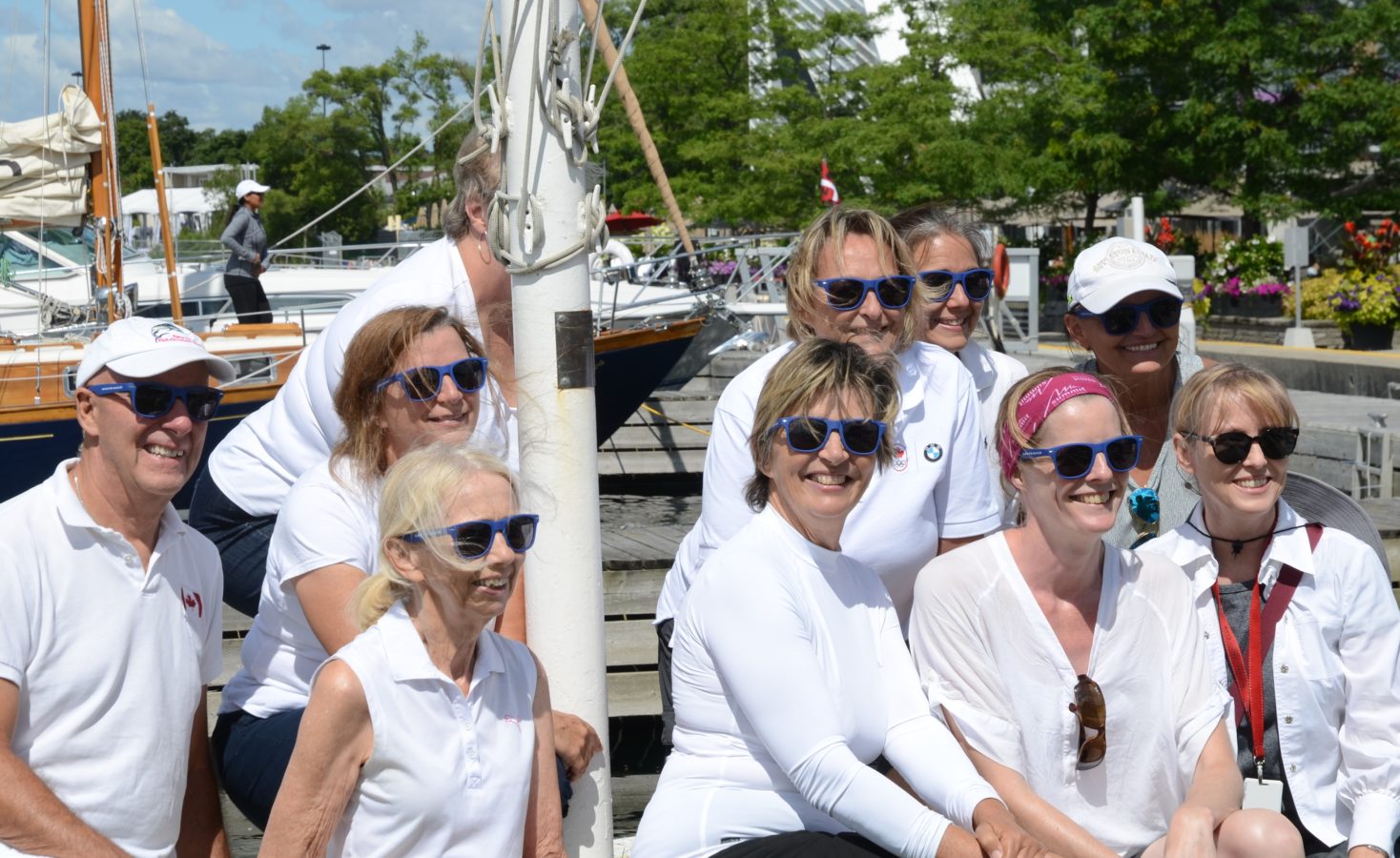
SUPPORTING GIRLS ON THE WATER
SUPPORTING GIRLS ON THE WATER
Broadreach Dazzles with Jilàsi for Girl's Regatta
The Jilàsi for Girls regatta was held on Saturday August 10th at the Boulevard Club in Toronto, Ontario, with the generous support of North Sails. The regatta was in support of The Broad Reach Foundation’s commitment to further girls and women’s leadership in sailing, each boat being led by a female skipper. North Sails provided products that filled goodie bags for each attendee. After an incredibly joyful and rewarding day on the water, participants and attendees celebrated with drinks, dinner, and amicable bidding wars through a silent auction.
North Sails generosity continued with their contribution of a gift basket and copy of the North Sails Story to the silent auction, raising $250 in support! All funds raised from the regatta through support of attendees, the silent auction, and the racers went directly into the Broad Reach Foundation’s programs engaging disadvantaged youth in the development of knowledge, skills and greater social belonging. The Broad Reach Foundation aims to increase responsibility, discipline, and teamwork by engaging youth in the sport, science and experience of sailing on Lake Ontario. Participating youth are from varying backgrounds and registered through community agencies across Toronto. Broad Reach provides youth an opportunity to learn and grow as a team members and leaders out on the water. Broad Reach’s work could not be as impactful without the help of our wonderfully supportive sponsors like North Sails, donors, and most importantly the sailing community.
READ MORE
READ MORE
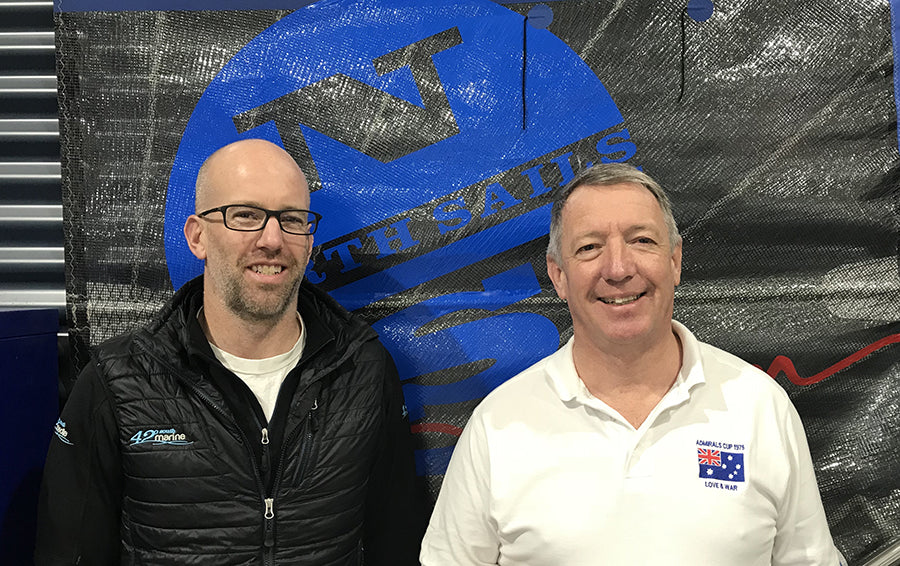
EXCITING ANNOUNCEMENT
EXCITING ANNOUNCEMENT
Saturday, 25 August 2018, was a significant day for prominent Hobart yachtsmen Stephen 'Rowdy' McCullum and Stewart Gray, and for worldwide sail makers, North Sails.
McCullum has joined Gray as principals of 42ºSouth Marine which operates the Hobart loft of North Sales at Cambridge, (above Lewis Marine), combining their vast yachting, sail-making and business experience.
In fact, when it comes to counting up sailing experience and expertise in the marine industry, in particular sail-making, it's hard to go past 'Rowdy' and Stewart.
It's a combination that seems certain to benefit Tasmanian sailing, bringing the latest technology in making sails for types of boats, off-the-beach dinghies, one-design keelboats, ocean racers and cruising yachts.
North Sails continue to be heavily involved in the America's Cup, the Volvo Race and international one-design yacht racing and are noted for ground-breaking design and sail construction technology, including the creation of 3Di™ moulded sails, claimed to be the world's fastest and most durable sails, for racing and cruising.
Both 'Rowdy' and Stewart began their working lives as sail-making apprentices in Hobart and soon became involved in International racing campaigns that took them overseas for further design and sail-making projects, as well as expanding their sailing careers, mostly in maxis and America's Cup contenders.
"As a sailmaker I later worked with Grant Simmer on America's Cup campaigns and with the late Graeme 'Frizzle' Freeman sailing on Windward Passage II," 'Rowdy' said on the eve of their commercial partnership coming into force yesterday, "The Windward Passage campaign took 'Frizzle' and myself to Europe and the USA to work with the Italian America's Cup challenge before returning to Tasmania to join Bob Clifford with the maxi ketch Tasmania which took line honours in the 50th Sydney Hobart," Rowdy added.
McCullum, who is vice commodore of the Royal Yacht Club of Tasmania, has competed as a key crew member including watch captain and sailing master, in 22 Sydney Hobarts Stewart Gray returned to Hobart six years ago after being involved as a professional yachtsman and sailmaker in two America's Cup campaigns and three Volvo Ocean Races. He also won two World Championships in Maxis and TP52's.
"And like Rowdy, I did my apprenticeship as a sailmaker, but with Ian Ross at Hood Sails in Sandy Bay," he said. Back in Tasmania, I've owned my own business, 42ºSouth Marine, for the past six years, setting up the loft as a North Sails agency where we supply racing or cruising sails for anything from Optimists to maxi yachts. However, a big part of our business is making sail covers, canvas's and powerboat clears," Gray added.
"By joining forces and combining our sailing and sail-making expertise, we plan to develop the business in line with the expansion of the sport of yachting, both in cruising and racing keelboats and in dinghy classes in Tasmania," McCullum said. "We will be in a greater position to not only supply a quality product, but to give an even greater level of advice and customer services to all areas of the marine industry," said Gray, expressing great confidence in the new partnership.
North Sails, through its Worldwide resources and expertise can provide yacht owners with everything from cross cut dacron sails built from our in-house milled dacrons, through to 3Di™ sails.
"3Di™ is the only sail like it on the market, it is stronger, lighter and more resistant to environmental factors than laminate string sails and we couldn't be more excited to bring it to the local market", emphasised Gray and McCullum.
Written by Peter Campbell
READ MORE
READ MORE
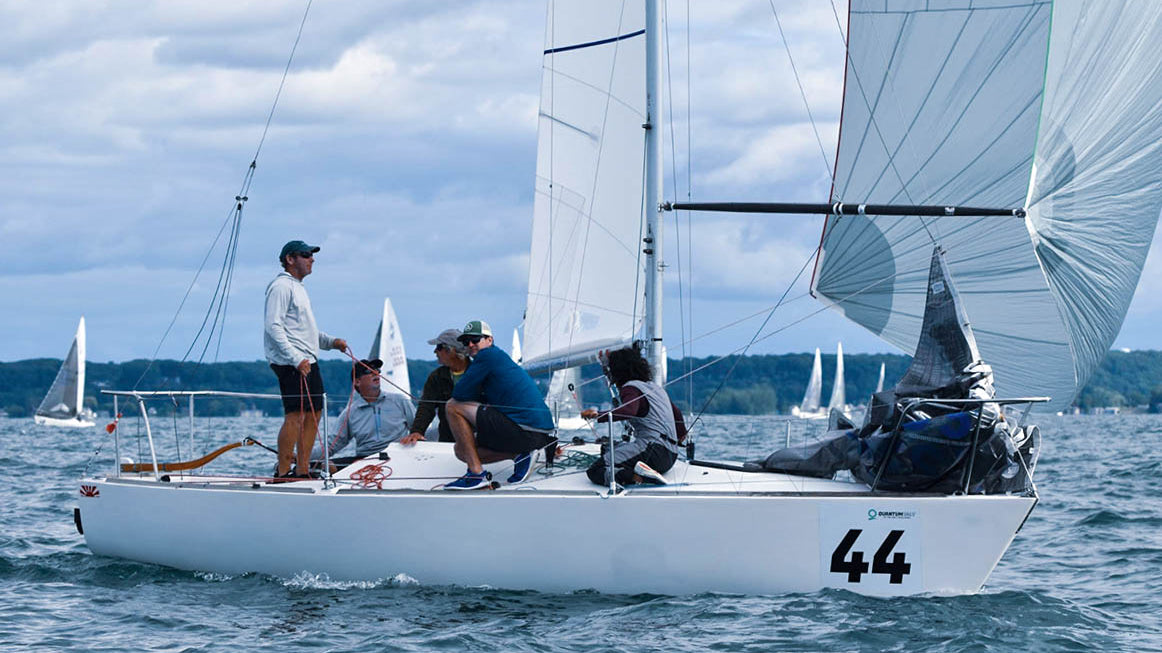
PODIUM SWEEP AT J/24 NATIONALS
PODIUM SWEEP AT J/24 NATIONALS
Will Welles’ Buckaroo Saddles-Up To Snatch The 2019 Title
© Chris Howell
Rochester Yacht Club hosted the J/24 Nationals on the beautiful waters of Lake Ontario, with 48-boats in attendance. North Sails clients had the upper hand on the competition, bringing their best game to the race course to take the fleet by storm with a full podium sweep. Congratulations to North Sails Will Bomar on team Bangor Packet for taking third overall, 2018 National Champion Robby Brown and team Angel Of Harlem for their second place finish, and first overall, now five-time National Champion, North Sails Will Welles and his power-house team of Chris and Monica Morgan, Jeff Linton, and Erik Rexford on Buckaroo.
The weekend kicked off on Thursday with an official practice race with winds out of the WNW at 15 knots and 2-3 foot seas, which was a great way to warm up. The practice race however was completely different conditions than what competitors would experience for racing on Friday and Saturday. On the final day, a strong thermal filled in later in the morning from the East at around 15 knots. Staying in phase became even more valuable since there was pressure across the course. 2019 National Champion Will Welles shared some of his insights on how his team, from start to finish, put together a championship-winning regatta.
“Having a good team that works well together is the key!”
“First of all, it was great to be back in the boat with this team, we have a lot of fun on and off the water. I’ve been pretty lucky to sail on a few great teams like this one. Having a good team that works well together is the key! We focused on getting off the line and being able to sail in good lanes from the start so that we could place the boat in the pressure both upwind and downwind. Keeping the boat at maximum speed was very important. The first two days were pretty light with short steep chop so pinching upwind was not an option and the downwinds were even harder, if you sailed to low for too long and hit the back of a wave you just stopped. We found the key for optimum downwind speed was to focus on the biggest lanes we could to keep the bow up a touch more than normal and keep our speed on and the boat stable. We worked really hard to just stay in the pressure the best we could, our tactician Jeff Linton did a really good job at that!”
Extremely tight racing in the top 10, with Will Welles (bow 44) finishing 1st Place, John Mollicone (bow 52) finishing 5th Place, and Robby Brown (Bow 22) finishing 2nd overall. © Chris Howell
North Sails Mike Ingham on Nautalytics placed seventh overall, and provided his take on local knowledge prior to the regatta, which gave perspective as to what sailors could expect with the challenging conditions. Although there was a concept for ‘typical’ shift trends, Rochester, also known as ‘left-chester’ was still very unpredictable, and often presented irregular patterns that were not always easy to read.
© Chris Howell
Day one and two were similar, with trending wind directions from the NNW to ENE, with roughly 5-7 knots giving the left side of the race course the upper hand the majority of the time. The right side did pay off every now and then, but it depended on when you went right and ideally, you could do it and stay in phase to connect back with the left. The top women’s team, Sea Bags Sailing Team with skipper Erica Beck Spencer had a great regatta result, finishing 13th overall. “The biggest part of each race for us was the start,” said tactician Hillary Noble. “We had to get off the line, and we had to be at full speed. Prior to the gun, we would practice our approaches to the line. Knowing how long it would take to get up to full speed , allowed us to figure out what time we should make our final approach. A few times there was a righty at the start, which made it very tempting to work the right side of the course, but we found it safer to play the middle towards the bottom then connect to the left side.” The Sea Bags Women’s Sailing Team purchased new sails just prior to the event, and expressed how much of a difference it made in their overall boat speed.
“Our sails were so fast. There were times where it felt like we were shot out of a cannon!” – Jessica Harris, bowman
© Chris Howell
North Sails Paul Abdullah trimmed for John Mollicone and North expert Tim Healy was the tactician on team Helly Hansen, who placed 5th overall. “It was a great weekend for Helly Hansen,” said Paul. “The conditions were extremely difficult on Friday and Saturday, but we were able to post consistent scores due to having good communication and boat speed. Trimming the genoa was non-stop upwind, and being sure to ease the sheet to keep the boat accelerating through the chop was very important. We wouldn’t try to point the boat upwind until we had good flow over the keel so the foils could work. Downwind was even more difficult, so we pretty much sailed with the pole forward to maintain any sense of boat speed.”
Skipper of Bangor Packet, North Sails Will Bomar had some great takeaways to share. “The biggest key to a good result was keeping the boat moving by having the crew weight low, keeping the tales on the genoa streaming, and not chasing every lift, which was normally just increases in pressure. Not using the tiller to steer was also great to maintain speed. We used our body weight to steer the boat and manage our transitions. On Sunday when the thermal built to 15 knots, rig tune was the key to having a good result. Being able to keep the boat flat while sailing up wind in the pressure worked well for us.”
North Sails Austin Powers also had some great takeaways from the regatta, serving as tactician for Will Bomar on Bangor Packet. “The key to sailing in the light and lumpy conditions were to find bigger lanes. The bigger lanes were especially important to leeward to give Will the room to steer through the waves, and maintain speed. Rochester lived up to the billing for most of the event with the left side generally winning out, but Sunday saw a much squarer course with boats coming off of both the left and the right with success. After debriefing with the team we thought that our boat speed came from constant weight adjustment as the breeze came in and out. Upwind the crew focused on weight placement shifting from “dogs in the house” to full hiking and everything in between.”
Bangor Packet, skippered by North Sails Will Bomar, raced to third place overall © Chris Howell
North Sails Ryan Lashaway on Rumming on Empty was also fighting to get off the starting line and break free of the traffic. He commented; “Getting to the top of the fleet required clean breeze, especially on the first upwind leg. The large fleet made it critical not to get caught in traffic in the middle of the course. You had to get to an edge and go fast. In choppy, light conditions the boat was sailing it’s fastest when we had clean breeze and the freedom to change gears as the boat needed it.”
“We sailed with a full new set of North’s and felt we had speed in both choppy and flat conditions. Couldn’t be happier with how the boat and sails performed.”
The top three teams at Nationals were powered by the Fathead Mainsail, and FR-2 spinnaker. First and second place finishers used the DX-7TT genoa, and 3rd place used the SD/TH genoa.
Interested in Championship-winning sails? Check out our products and contact your local North expert today.
Congratulations to North Sails clients for finishing 1,2,3,5,7,11,13,14,15 at the 2019 US Nationals in Rochester! #NSVictoryList
Full Results
READ MORE
READ MORE
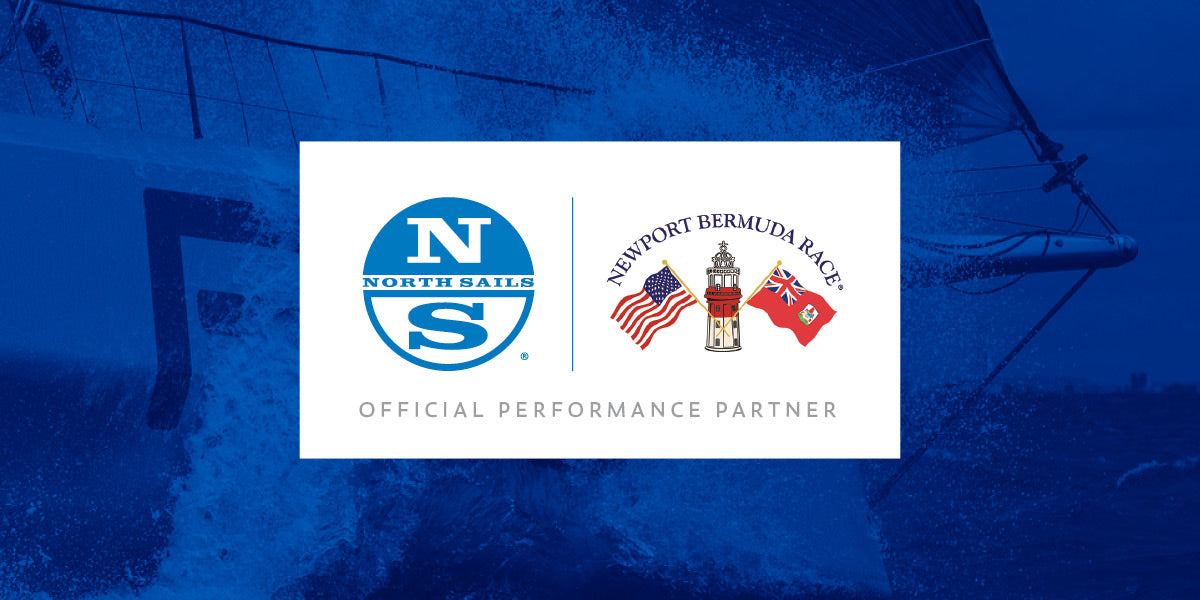
NORTH SAILS PERFORMANCE SEMINAR IN PORTSMOUTH
NORTH SAILS PERFORMANCE SEMINAR
Reserve Your Space Today | Portsmouth 10.25.19 | 1800-2000
As the Official Performance Partner, North Sails is hosting three seminars with ocean-racing expert Peter Isler, Race Meteorologist Chris Bedford, and local North Sails Experts to help prepare you for the Newport Bermuda Race. The North Performance Seminars focus on optimizing your sail inventories based on weather, navigation, racing strategies and beyond.
Seminars are open to all competitors of the 2020 race. We look forward to seeing you at your local seminar soon in our Portsmouth loft.
READ MORE
READ MORE
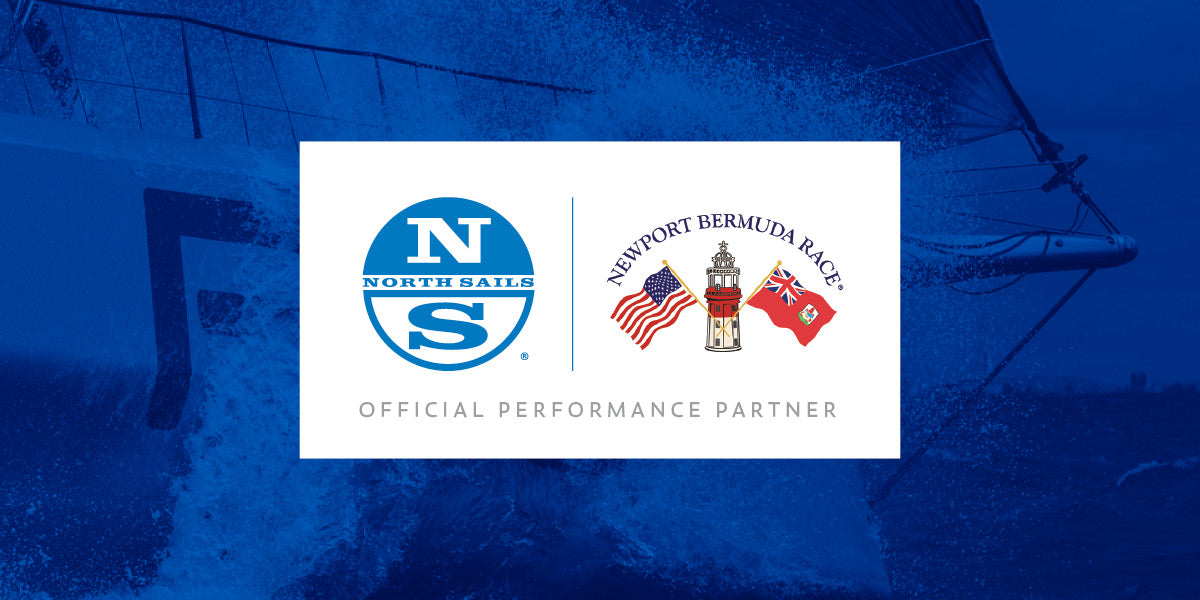
NORTH SAILS PERFORMANCE SEMINAR IN MILFORD
NORTH SAILS PERFORMANCE SEMINAR
Reserve Your Space Today | Milford 10.26.19 | 1030-1230
As the Official Performance Partner, North Sails is hosting three seminars with ocean-racing expert Peter Isler, Race Meteorologist Chris Bedford, and local North Sails Experts to help prepare you for the Newport Bermuda Race. The North Performance Seminars focus on optimizing your sail inventories based on weather, navigation, racing strategies and beyond.
Seminars are open to all competitors of the 2020 race. We look forward to seeing you at your local seminar in our Milford loft.
READ MORE
READ MORE

INTERNATIONAL MOTH SPEED GUIDE
Moth Dinghy expert Rob Greenhalgh introduces this extraordinary singlehanded foiling dinghy and describes the keys to sailing one fast.
Who sails the foiling Moth Dinghy?
The Moth class is for everyone—it’s so exciting, you don’t need to race it. Club sailors can get a huge buzz out of foiling, going fast around the bay, and learning to foil jibe and tack. They might enjoy it so much they never need to join a race. At the other end of the spectrum, there are sailors who have been in Moth Class for a decade or more and love the challenge of racing this exciting, complex craft.
Viewed from stern or bow, the foiling moth is a high-speed machine, clearly unlike other sailboats.
What kind of sailors enjoy this challenge?
Moths are development boats, not a strict one-design class, and that’s daunting for some. The technical and evolutionary side of Moth sailing requires a good understanding of how everything works—how the foils interact with the rig setup and how to balance both aspects. Over the last five years, there have been massive speed advancements, which will continue. To be at the top of the game, you have to enjoy the technical side. But you can buy equipment off the shelf and, if you practice and sail well, soon be up to pace. Though more technically oriented sailors often gain an edge for a while, there are also lots of people who will make changes that don’t help them, so it evens out.
How physical is the sailing?
When you are first getting into it, Moth sailing seems physically hard, but once you’ve done it a while, it’s not too bad. On a windy day with a lot of capsizing, it gets pretty tiring. But it’s a light boat, and the loads are not high. Anyone can do it if you can move quickly at times. There are plenty of Moth sailors in their 60s.
New boats or used, which are better?
My advice for the first-time or second-time buyer is to look for a good second-hand boat that you know will fly. This saves you a lot of effort, because even experienced Moth sailors need a few months to work up a new boat. Sure, it’s always a worry that you might not be getting good enough kit with a used boat, but in my experience, any modern Moth can be made fast. If you want to buy new, a standard boat from either of the two main builders—Exocet by Maguire Boats, or Mach 2 by MacDougall McConaghy—will quick enough for top 5. You can also have a look at the new Bieker Moth by LSF Composites.
The Moth is a development class. What’s happening lately?
At the top end of the class, mast lengths are getting shorter to lower the rig’s center of effort and improve performance. A shorter luff length results in a longer boom length. Rigs have progressively become lower over the last five years, and mast lengths have reduced from 5270mm or 5300mm to the current standard of 5100mm.
The Vi-8 DS 3Di (on top) and Vi-8 LA 3DI feature the same sail area. The LA has more power in lighter winds to foil more quickly; the DS has less drag at high speeds.
What sails do you recommend?
North offers four different sails that meet the Moth sail-area limit of 8.25 square meters. (For more detail, read Four New 3Di Sails for Moth Sailors.) The choice of sails relates to your weight, expected wind speed, and another ongoing development in the class—deck-sweeping sails. Because of the class sail-area limitation, in 14 knots of wind we are always trying to shed horsepower and reduce aero-drag. The deck-sweeper sail is better at that, cleaning up areas of drag around the front of the mast, the boom, and the deck area.
North’s Vi-8 DS 3Di sail is a decksweeper-style sail that reduces aerodrag. If you weigh less than 75kg, you can use the deck-sweeper the whole time. If you’re heavier, like me, in breeze less than 10 knots you’ll need the all-purpose sail’s extra horsepower to get up and foil. The deck-sweeper sail has less horsepower because its center of effort is lower and its shape is not quite as good in those low areas around the mast, boom and deck.
8LA-3Di provides extra power to get on foil.
Which sails do you use?
I use the North Vi 8LA 3Di and Vi-8 DS 3Di, as both fit my mast length of 5100mm. They can be used on both the Mach2 and Exocet.
The decksweeper (Vi-8 DS 3Di) creates an endplate and lowers aero-drag. It is slightly faster once foiling.
How does foil choice affect sail choice?
Moths have two foils, a larger foil for lighter winds and a smaller foil for stronger, and that’s a choice you have to make on the beach. In my case, if I expect to be on my foils all day, I’ll choose the smaller foil and the deck-sweeper sail. If the winds are lighter or less reliable, I will often choose the big foil and the LA sail. And if I expect light air to start but a building breeze all day, I’ll likely choose the big foil with the deck-sweeper sail.
Tuning the Moth Dinghy
What are the keys to tuning a Moth?
Generally speaking, you should set up your boat to carry as much rake as possible. How much is that? You’ll know it’s too much if you can’t get under the boom in tacks and jibes. This is not something you do underway, and if the boom is making boat handling more difficult, make the rig more upright until that smooths out.
What other key adjustments do you make before launching a Moth?
Batten tension is one. For Batten 1 (the top batten) down to Batten 5, just take the creases out of the batten pockets—don’t over-tighten them. For Batten 6, remove the crease and then add two more turns by twisting the batten key two full revolutions in a clockwise direction. For Batten 7, take the creases out and add three turns. The outhaul is also non-adjustable underway. Rig the boat ashore with the outhaul loose. Pull on max vang and max cunningham, and then pull the outhaul tight. This will give you a good all round setting.
What other settings can you recommend?
Here some of the numbers from my boat, but don’t worry if your measurements are different. Comparing measurements boat to boat may not matter at all. The important thing is to start recording them and experimenting.
Front Prodder 340 (adjustable +/-50mm)
Side Arm 410mm
Deflection 220mm
Shroud Base 1500mm
Mast Length 5100mm (excluding plastic plugs top and bottom)
Back of mast to clew ring 2340mm
From mast length to shroud base, it's important to record all of your boat and rig measurements. You will change them over time.
How do you set up your foils, actuator wand, and gearing?
This could be the subject for an entire article, but here is an introduction. A Moth has main foils on the daggerboard and a wand in the bow that automatically adjusts the angle of the foils as you fly higher and lower. The rate at which your foils respond depends on how you set the gearing in the bow between your wand and the foils, and this is something you’ll adjust depending on your expectations for wind speed and wave conditions—the rougher it is, the more sensitive you want your gearing to be.
Sailing in rougher water requires faster gearing between your actuator and main foils. Foil gearing is a critical control for waves; make sure it can be adjusted for rough waters. To get through waves you need faster gearing. You’ll also change foil size depending on the wind forecast. I have two sets of main foils and use the smaller one on windier days. However, if the wind is light for the first race and predicted to build, I’ll go with the larger foil because the speed penalty of not being able to fly with other boats can trumps all other considerations.
Upwind Moth Sailing
What is most important when sailing upwind?
On any point of sail, the vang and cunningham are powerful controls, and need constant adjustment for different conditions. The goal is to generate power for low-riding and to get up on the foils, and then flatten the sail as the wind builds. One of the challenges of the Moth is it has a maximum 8.25 square meters of sail area, and upwind in most conditions, that’s more sail than you need. Downwind, you have the opposite problem; your speed reduces the apparent wind so much, you’re always starved for power.
What is low-riding mode and how do you sail fast in light winds?
In general you don’t race in winds when you can’t foil, but it may happen that the wind lightens up substantially during a race. Sailing in low-riding mode is an art in itself, something like balancing in a canoe because the hull is so narrow. I always recommend practicing sailing that way.
What does it take to fly a Moth?
To get on the foil, you’ll need a little windward heel to start. If you have marginal flying conditions, shift your weight just slightly farther aft to get more angle on the main foil. Your goal is to get to critical speed to get lift on the foil. Your rig can create vertical lift, so try to tip it over on top of you, but not too far. It’s a bit of a fine line.
Heel the Moth to windward to keep the boat more stable and reduce leeway.
Why do you tip the Moth to windward when flying?
We sail with the rig always tipped to windward because it keeps the boat more stable and reduces leeway on the main foil. Use very subtle steering and trimming of the main.
How do you trim the Moth sailing upwind?
Correct trim is the absolute key to good boatspeed. It’s very easy to over-sheet and stall the front of the mainsail. Always have the inside tell tales lifting. A common mistake is sailing under-powered and over-trimmed. As the wind increases, flatten the main by tightening vang and cunningham to accommodate the higher apparent wind speeds.
How do you adjust sail trim for gusty winds?
You need your rig set-up to be user friendly. That means having enough vang and cunningham to straighten the sail. If twisted, the center of effort can move up and down the sail. It takes a certain level of confidence to get to the point where you can let go of the mainsheet to tighten the kicker and cunningham.
Downwind Moth Sailing
What is the key to good Moth speed downwind?
Downwind we need a massive gear change as apparent wind speed reduces when you round the weather mark. Upwind, at speeds of 15 to 20 knots, you’ll be sailing in very high apparent wind speeds and fully depowering. Downwind, apparent wind speed is much lower. After bearing away, let the cunningham off completely, over-ease the vang and then ease the cunningham again. The over-eased vang really allows the cunningham to ease up the mast. I then bring some vang back on too avoid too much twist. People sometimes sail too twisted downwind, which makes the sail flat and less stable. I also pull on a tiny bit of cunningham to clean any creases, and as the wind builds, I bring on both controls slightly.
Sailing downwind, be sure to maintain a big entry angle in the lower part of the sail and avoid over-trimming.
What is your focus when trimming downwind?
I focus closely on my lower tell tales, keeping them flying 100 percent and making sure I ease enough to keep the sail ‘hooked up’ with airflow attached. I look for a nice big entry angle on the bottom part of the sail and clean up any horizontal creases by subtly tightening the cunningham. From there, it’s a matter of very subtle trim and steering. If in doubt, ease the sheet and be sure you have good flow going around the front of the sail. If you run into a light patch, just head up to keep the flow going on the main. If needed, power up the main even more. Get the gearing really slow on your foils to minimize drag. The boat will go faster and apparent wind will increase, moving the wind forward and letting you trim harder. Especially when it’s a bit lighter downwind, be sure to pre-empt a drop in apparent wind by easing main and bringing the bow up!
Moth Tacking, Jibing And Gear Changing
How do you foil jibe a Moth?
In all maneuvers, focus on where your body has to end up and getting your hand and foot positions correct. When jibing, think of the foils like they are an airplane; banking its wings is the only way it can turn. You need to tip the boat to leeward as you go into your jibe. As soon as the foils are banked, carve into the jibe with the rudder; the more heel you have, the harder you have to turn. Then move across the boat. Going into the jibe, I put my hand as far along the tiller extension as possible when I pass it across to the new side of the boat, and my body naturally follows. Lead your body with your arm and you’ll come out with the tiller behind your back where you want it and can do the hand transfer. Practice steering behind your back and quickly changing hands out of the jibe. Also, focus on trimming the main nicely out of the jibe so the sail ‘hooks up’ and you get power quickly. Jibing in light air can be hard but once you’ve got it, you can jibe just as easily in 10 knots or 20 knots. Sailing the boat downwind in all wind speeds is quite different. When it is windier, you tip the boat to windward more, move aft slightly, and don’t power up the sail as much. If you can’t foil jibe, it’s probably not windy enough to race. Keep in mind that it’s easier to jibe than tack. Sometimes when sailing upwind, we’ll jibe rather than tack to ensure we can stay on the foil.
When foil tacking or jibing, you need to flatten the boat. For jibing, bank into the turn to leeward. You’ll turn the boat more aggressively when your body is ready to move across to the new wing.
How do you foil tack a Moth?
When tacking you have to move quickly, bringing the boat relatively flat once head to wind. Start luffing slowly, taking the edge off your speed; make sure the boat is flat when head to wind. As my body moves across the middle to the new wing, I’ll increase the rate of turn, steering quite aggressively through the eye of wind, but my body has to be ready to cross the boat and receive the power on the new tack. You need to come out tipped to windward. Here’s how I break it down:
Ten seconds before tacking, consider slowing the boat slightly and sailing slightly higher.
Plan for a slow luff head to wind, followed by a faster turn rate once confident that crew weight can be positioned correctly.
Heel to windward before the tack but flatten the boat once head to wind. Move your weight inboard. It is important here to sheet the mainsheet on centerline so that it is not over the leeward wing when you pass underneath.
As you move across the middle of the boat, pass the tiller extension around the back and into a position halfway along the leeward wing.
When you are confident you can move to the new side, increase the rate of turn, landing on a wider than close-hauled course.
There are a lot of G-forces during this period, so expected to get ejected a few times!
Don’t try to piece the whole tack together immediately. Practice the first phase of luffing head to wind, getting your weight to center, and switching the tiller extension across.
Remember to ease mainsheet out of the tack and have your hands positioned so that the sheet can be eased quickly. The sheet is more important than the tiller on exit.
I set my mast rake to allow 70 to 75cm between the boom and the deck where I cross the boat. Tacking is important, so make sure you have room under the boom! For tacking practice, I recommend having the rig more upright.
Don’t adjust any control lines right before or after tacks, unless it is very light and foiling is marginal.
Name 5 key gear changes in a Moth
To foil early in light air, power up by having the vang and cunningham as loose as possible. However, it is easy to over-deepen the front of the sail, requiring further bear-away to get good flow on the sail. Don’t overdo it.
Downwind always requires a deeper sail shape than upwind, regardless of wind speed.
Once foiling, immediately pull on vang to stabilize the sail and cunningham to clean the creases. Even though the wind is light, we are quickly doing 14/15kts. The AWS is high so we need to change sail shape to achieve good speeds.
As the breeze builds, constantly increase vang and cunningham loads to achieve the desired sail shapes. Max vang should be achieved in 15 knots and max cunningham in 18 knots.
The Moth gets overpowered quickly, and from 18 knots upwards a softer tip or different sail is required. North’s LA and DS designs have a slight variation in the luff rounds to cover the range, with the DS being aimed at 14 knots true wind speed. For lighter sailors, a softer-tip allows the mast to bend earlier and depower the sail.
How do you start a race in a Moth?
Starts are a bit chaotic. Even for long-time racers, a Moth start will be a new experience. People get up on their foils with about 25 seconds to go and do a big turn-up at about 3 seconds, crossing the lining at 20 knots. A key thing when you’re on your foils is to have the ability to slow down while maintaining control. You need to practice that. Getting to the pin too soon is dodgy, especially with boats starting on port tack.
Why do so many Moths start on port tack?
Moths travel at 15 to 18 knots upwind, so tacking is a very costly part of an upwind leg. Reducing the number of tacks during a beat is very efficient, although this depends somewhat on how well you tack and how confident you are in making your tacks.
How many ways can you capsize a Moth?
You will capsize a Moth every possible way when learning. But I can sail for days now without capsizing, unless it is windy and choppy. The key to recovering quickly is to get on the daggerboard and do a dry capsize, climbing back over the wing. Sometimes that’s hard to do, especially when you pitchpole and find yourself 20 meters out in front of that boat.
What is the most common boat-handling mistake in a Moth?
Capsizing! Foil tacking, in particular, is very difficult. A common mistake is trying to foil tack when it’s breezy. Drag is so high that as you go through head to wind, everything slows down and it’s easy to capsize. You may be better off planning to do a touch-and-go tack.
READ MORE
READ MORE
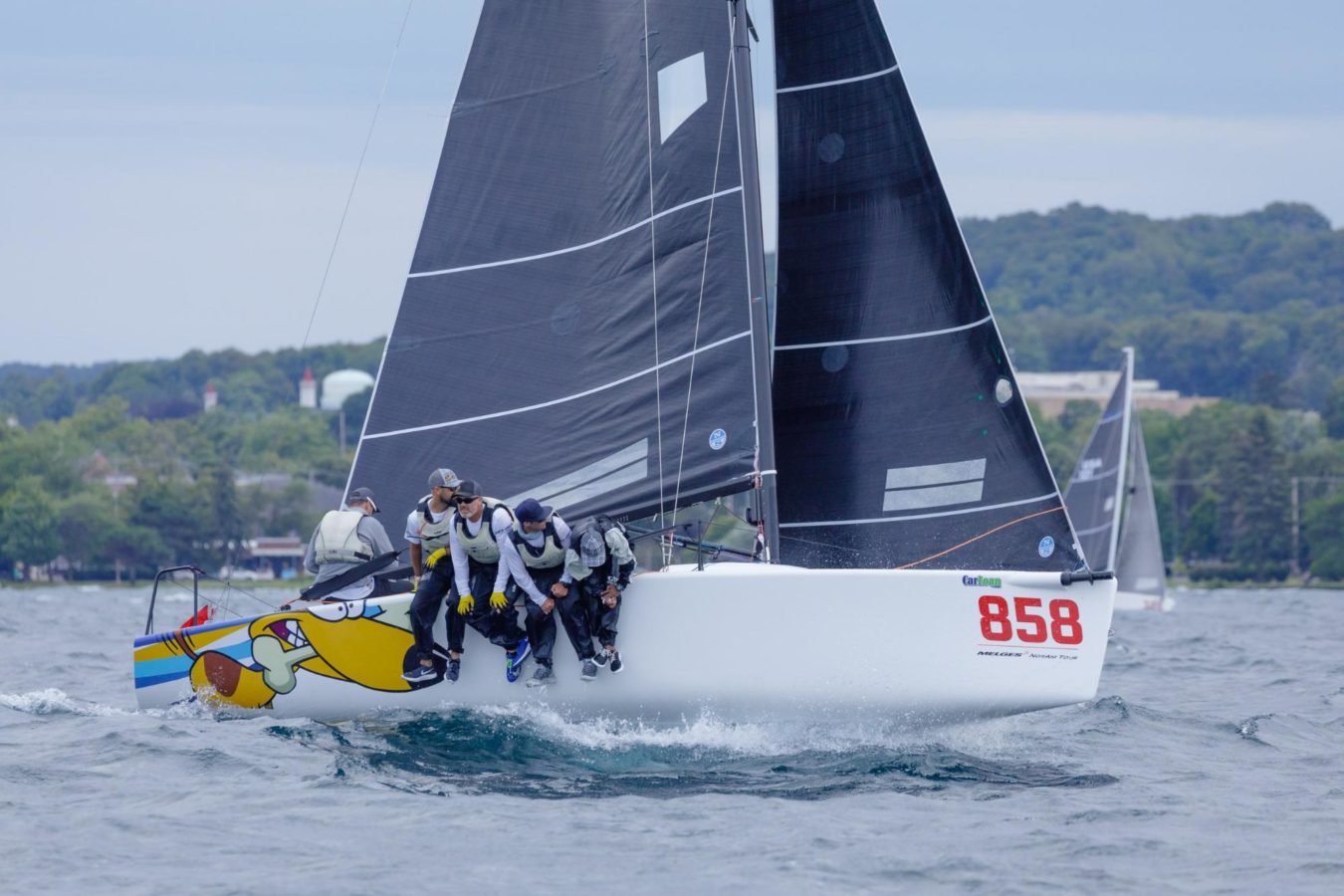
LUCKY DOG WINS MELGES 24 NORTH AMERICANS
CLIENTS WIN MELGES 24 NORTH AMERICANS
3Di Raises the Stakes in the 41-Boat Fleet
© IM4CA/©Bill Crawford,Harbor Pictures Company.
North clients took two podium spots in the Open Division at the 2019 Melges 24 North American Championship in Traverse City, Michigan. Travis Weisleder’s Lucky Dog/Gill Race Team scored only one race out of the top 4 to win the regatta by one point. Kevin Welch’s Mikey finished third.
In the Corinthian division, clients swept the podium. Fraser McMillan’s Sunnyvale won the division by 14 points and took 5th overall. In second place was Mike Dow’s Flying Toaster, and rounding out the podium was Marty Jensen’s Zig Zag.
After light air the first two days, the breeze came on stronger for the last day but continued to be quite shifty. North Sails expert John Bowden, onboard Lucky Dog, has been sailing with Travis for six years, but only one team member had sailed in Traverse City before. “We focused on sailing our own race,” he explains, adding that a great boat, great sails, and a great team proved more important that local knowledge. “Travis does a good job of surrounding himself with talented sailors, and makes sure the boat and sails will never be an excuse for failure. It all led to a great result in the end.”
© IM4CA/©Bill Crawford,Harbor Pictures Company
The team keeps the North tuning guide handy, but they also pay attention to the feel of boat and helm. “If you’re overpowered, you’re probably not tight enough.” He also explains that their 3Di sails don’t stretch like paneled sails do, so they have to be trimmed a little bit tighter. “Other than that, everything else is the same.”
The team used an Mi-1 and the new Ji-2, developed with North designers Mike Marshall and Per Andersen. “We really love them,” John says. “We were very happy with the AP-3 and J-7 paneled sails. They were certainly the standard for Melges 24’s. But there is always room for improvement. When we had the opportunity to switch to 3Di and help with the development process, we jumped at the chance. It’s nice to see all of the top teams running the 3Di sails. We have all been extremely happy with them.”
© Bill Crawford, Harbor Pictures Company
READ MORE
READ MORE
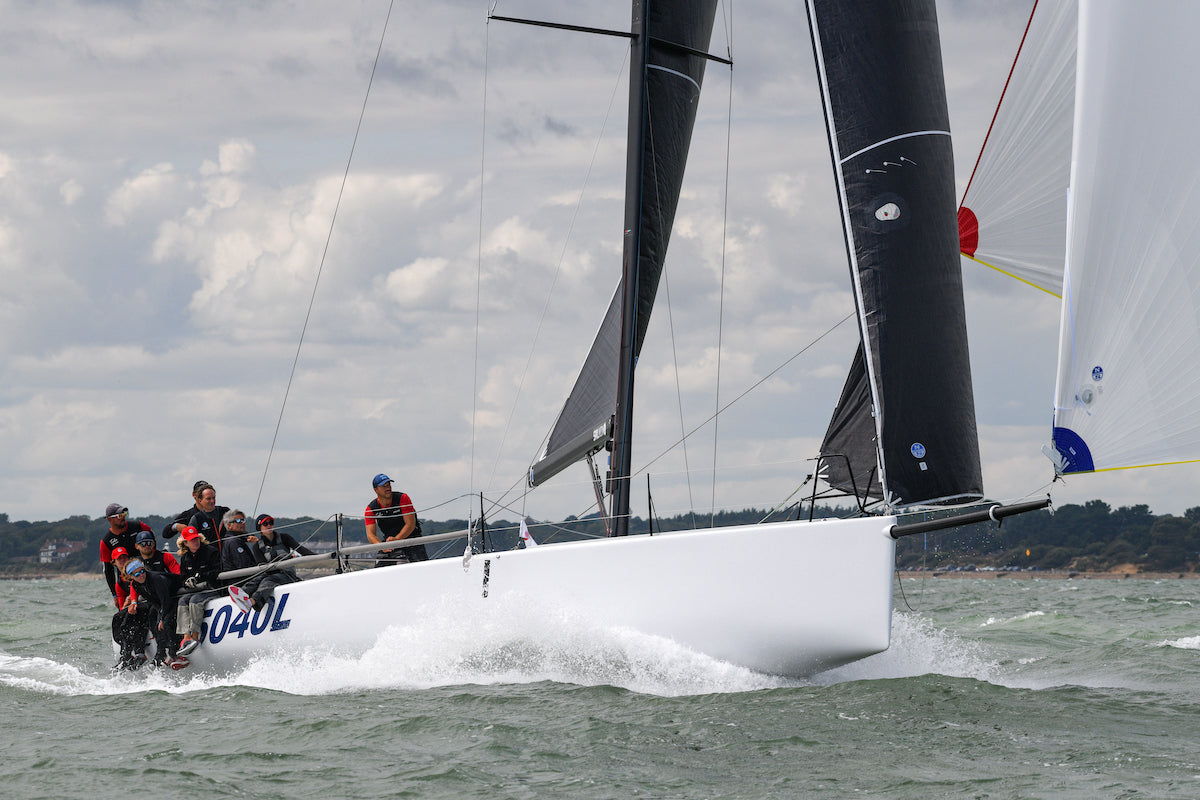
MELGES IC37 EXCELS AT COWES WEEK
MELGES IC37 EXCELS AT COWES WEEK
The First IC37 in Europe Debuts With a Win
📸 North Sails / James Tomlinson
After making one design waves in North America with a full summer of events, the first IC37 delivered to Europe won IRC class 1 at Cowes Week with conviction— Kanreki finished first in four of six races.
Such impressive IRC results from a boat originally drawn as a one design concept are a nice by-product of the tight collaboration between North Sails/Southern Spars, Melges, and boat designer Mark Mills.
North Sails expert Pete Redmond was onboard for Cowes Week and experienced firsthand how this fun, modern 37-foot race boat performed under IRC. “The IC37 had the advantage of planing speeds, especially in breeze where boat lengths can be gained quickly,” Pete explained. He was also impressed by the IRC-adapted sail inventory. “The sails fit perfectly out of the bag. “We used the standard one-design tuning and our IRC inventory included a slighter smaller mainsail, full-sized jibs that were purpose-built for Cowes Week, and a North Helix Code Sail, which we easily flew off the bowsprit with no modifications needed. Finishing off the inventory we had two A sails for lighter and heavier breezes.”
📸 North Sails / James Tomlinson
IRC is very popular in the UK. Pete feels the IC37 is a great contender, as it is suited for a wide range of sailing styles. “The boat is set up very simply, and everything runs well. Anyone will be able to get this boat around the corners, and switching between modes isn’t hard either.”
Kanreki’s crew, a mix of family and friends, was able to get the boat up to speed quickly, even though they hadn’t actually sailed the boat together before the first race. “They found racing the IC37 to be a lot of fun,” Pete added, “and that’s the only reason they wanted to sail Cowes Week – to have fun.”
Sam Pearson, class leader of the IC37 for the UK, was also impressed by Kanreki’s performance and optimistic about the future. “Although it was never our intention to focus on IRC when launching this new one design circuit, we knew we had to keep it in the back of our minds. If we wanted to see one design flourish, the design had to appeal to a broader audience. With these wins straight off the bat, the IC37 is 100% the weapon of choice to re-energize big boat one design racing in the UK.”
📸 North Sails / James Tomlinson
READ MORE
READ MORE
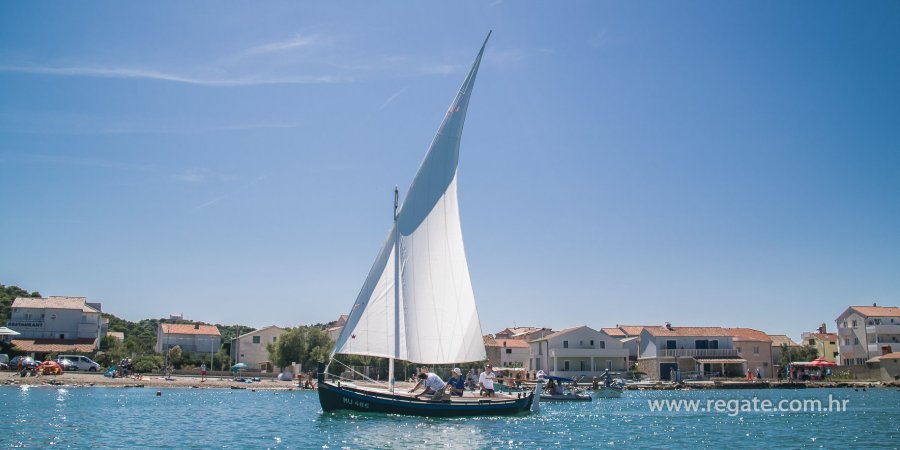
JOŠ JEDAN TRIJUMF SIROTICE
Još jedan trijumf Sirotice
U Betini, kolijevci drvene brodogradnje otoka Murtera, u nedjelju 18. kolovoza odjedrena je 17. regata za dušu i tilo. Riječ je o posljednjoj regati ciklusa regata latinskog idra pred veliko finale koje će se odjedriti u susjednom Murteru za mjesec dana.
I ove godine se okupila slična flota kao i lani, ukupno preko 30 leutgajeta i kaića. NAravno, gajete su i na ovoj regati dominirale po broju, ali kako se kasnije pokazalo za vrijeme jedrenja nisu se ni ostali modeli tek tako predavali!
Vremenski uvjeti u Betini su bili idealni. Lijep sunčan dan uz lagani maestral koji je puhao s oko desetak čvorova, omogučili su dosta brzu regatu bez stresnih situacija praćenih s lomom opreme i paranjem jedara kao što je to bio slučaj prošle godine.
Start je bio postavljen "na lancanu", premda su brodovi bili vezani za rivu, ali to je taj princip. Regatno polje je bilo identično lanjskom, a to konkretno znači da je prva bova bila postavljena u kanalu na oko pola puta prema Tisnom, zatim se morao obići otočić Sustipanac, potom druga bova koja je bila postavljena ispred rta Gradina (na ulazu u Murtersku luku) i za kraj je ostavljen sprint prema Betini.
Vjerojatno najzanimljiviji dio regate je ovaj put bio sam start, odnosno predstartna procedura.
Regatni odbor je odredio da će biti dan pripremni signal, zatim upozorenje na jednu minutu do starta i zatim start. Međutim, nekoliko gajeta postavljenih s lijeve strane startne linije je signal minute do starta shvatila kao signal za start i krenulo s povlačenjem po konopu od sidra.
10-20 sekundi su svi ostali gledali što se dešava i hoće li im kolege shvatiti da su malo požurili, ali kako već u takvim situacijama bude lančano su krenuli i svi ostali za njima.
U principu ovo je najvažniji dio regate jer ako je sidro uhvatilo dovoljno jako da se po njemu može povlačiti svom snagom i da kad ga se prođe da ga se bez problema može izvaditi, onda se može osvojiti dosta dobra pozicija za nastavak jedrenja.
Početna gužva koja je nastala u prvih stotinjak metar regate ubrzo se počela rijediti i najbrži se izdvajati ispred ostatka flote. Već od samog starta najuspješnija u tome je bila ekipa Sirotice. Već na prvoj bovi su bili na čelu cijele flote, a kasnije su tu razliku samo povećavali.
Za kompletnu rutu im je trebalo točno dva sata jedrenja, a poredak ostalih najboljih po grupama je slijedeći:
GAJETE:
1. Damir Čorkalo – MU 485 – Murter – SIROTICA
2. Hrvoje Jadrešić – MU 520 – Betina – CVITA
3. Ante Davor Turčinov – MU 887 – Murter – ILKA
KAIĆI:
1. Ivan Čobanov – MU 906 – Betina – MARINKA
2. Ivan Crljenko – MU 790 – Betina – Bez imena
3. Šime Šoić – MU 186 – Murter – MARIJA
LEUTI:
1. Grgo Jerat – MU 111 – Murter – JARUH
2. Dieter Schelinger – MU 84 – Murter – ORLIĆ
3. Tonko Skračić – MU 85 – Betina – GUŠTE
Foto galeriju s ove regate možete pronaći na ovom linku. Dok video izvještaj možete pogledati u video galeriji za 2019. godinu.
READ MORE
READ MORE
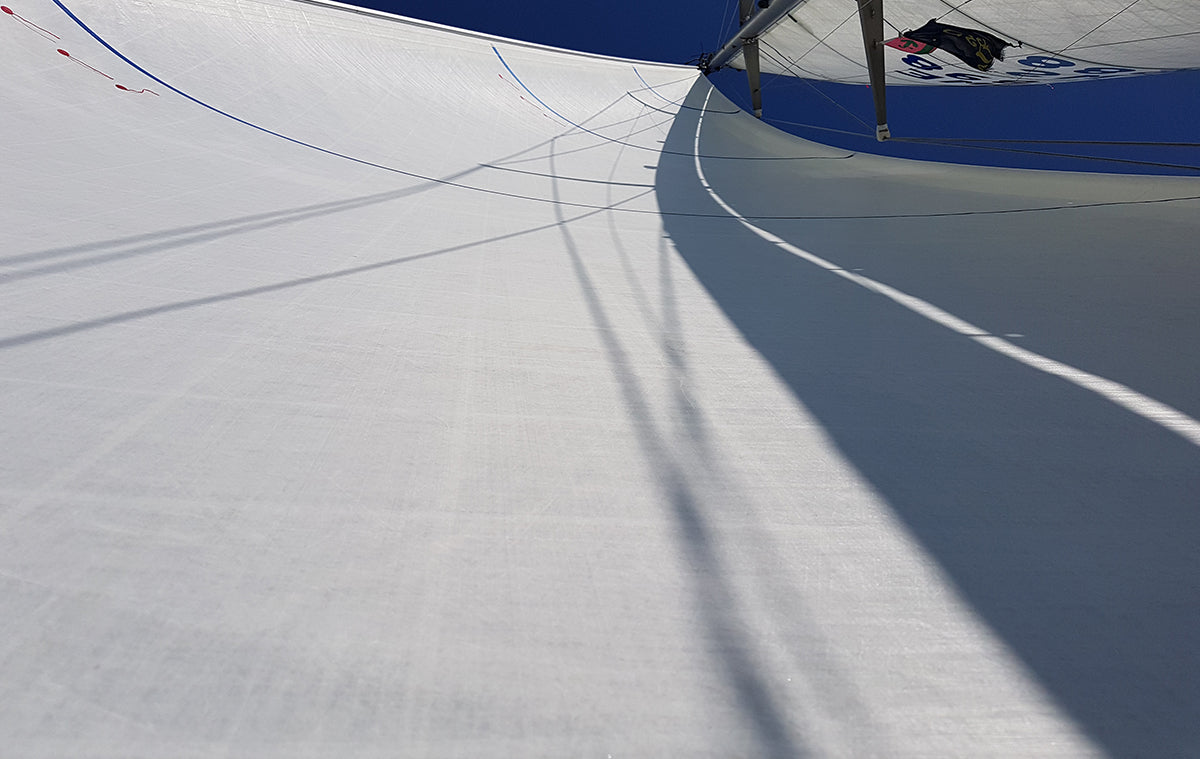
NORDAC: FORMSTABILITETEN ÄR NOG DET SOM IMPONERAR MEST
"FORMSTABILITETEN ÄR NOG DET SOM IMPONERAR MEST"
Patrik Helgegren om sina tre år gamla 3Di NORDAC-segel
NORDAC-segel
3Di NORDAC är ett bakat kompositsegel speciellt utvecklat för cruisingbåtar upp till cirka 40 fot. Det byggs på exakt samma sätt som världens mest avancerade kappseglingssegel, men det är baserat på polyester istället för på kevlar eller kolfiber. Resultatet blir ett segel med samma slitstyrka och livslängd som ett traditionellt dacronsegel, men med avsevärt bättre prestanda.
3Di NORDAC lanserades 1 juni 2017 och en av de allra första i Sverige att hoppa på tåget var Patrik Helgegren i Göteborg. Han och hans familj seglar en Nord 120, en bastant fyrtiofots långfärdsbåt ritad av Olle Enderlein.
Familjen Helgegrens Nordac-garderob består av storsegel och rullgenua, och båda dessa segel är uppe i ur och skur under hela säsongen. Frågan man ställer sig är: Hur de står sig idag, efter nästan tre hela säsonger? Vi låter frågan gå till Patrik:
"Formstabiliteten är nog det som imponerar mest. Jag kan inte se att formen har förändrats ett dugg på tre säsonger. Att de skulle vara slitstarka hade jag räknat med. Det är ju ändå en sorts dacronsegel."
Nyfiken på våra revolutionerande cruisingsegel? Besök oss på båtmässan så berättar vi mer!
Läs mer om 3Di NORDAC
READ MORE
READ MORE
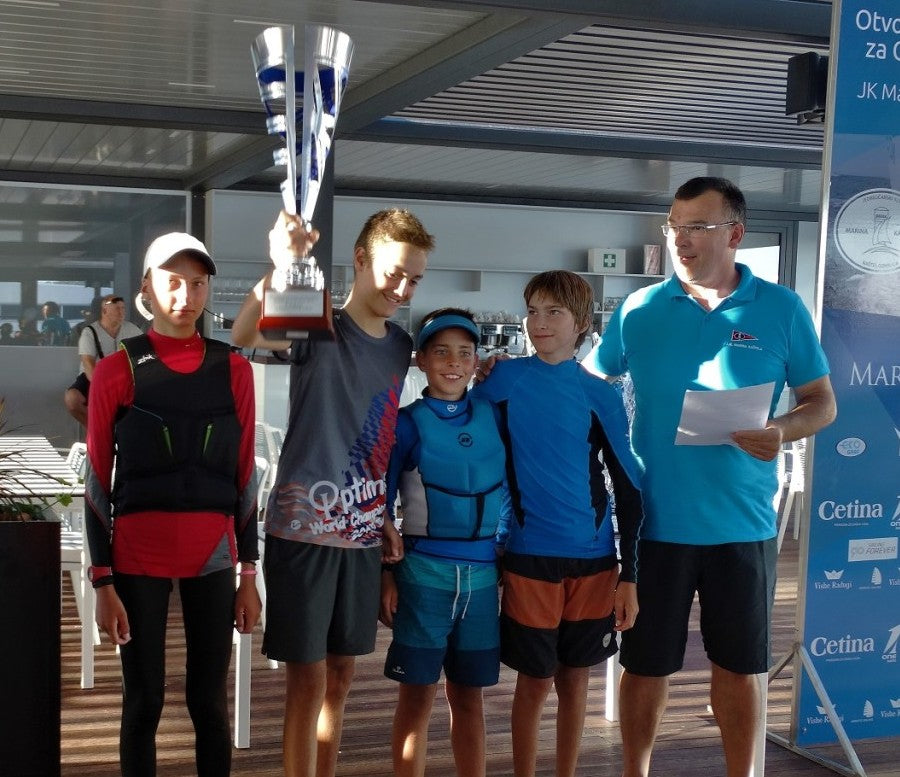
OTVORENO PH U EKIPNOM JEDRENJU ZA KLASU OPTIMIST
Otvoreno PH u ekipnom jedrenju za klasu Optimist
Foto: JK Marina Kaštela
Izvrsna jedrenja u proljetnom dijelu sezone i vrhunski plasmani jedriličara iz puležanskog JK Uljanik plovidbe nastavila su se i na ovogodišnjem Prvenstvu Hrvatske u ekipnom jedrenju za klasu Optimist.
Jedriličarski klub Marina Kaštela je u svom novom impozantnom jedriličarskom domu ugostio 15 ekipa iz Hrvatske i susjedne nam Crne Gore, a jedrilo se za vikend 16-18. kolovoza.
Unatoč popriličnom broju ekipa odziv klubova nije bio u jednakom broju, već su neki klubovi imali po nekoliko ekipa, a jedna ekipa je bila sastavljena i od jedriličara iz četiri različita kluba.
Najbrojniji su bili članovi JK Uljanik plovidba koji su na natjecanju imali čak tri svoje ekipe! Idući najbroniji klub je bio JK Split s dvije ekipe, a po jedan tim su poslali iz riječkog Galeba, Sv. Nikola iz Zagreba, splitski JK Mornar, još jedan klub iz Pule - JK Vega, zatim JK Briva iz Biograda, zadarski Uskok i JK Spinut iz Splita.
Međunarodni karakter natjecanju dale su ekipe JK Juga i ekipa Brius, a u taj otvoreni dio natjecanja svoj obol je dala i ekipa imena Pilići, a u kojoj su jedrili članovi JK Jugo, Zente, Omiša i Labuda.
Program regate je predvidio jedrenje jednog Round Robina, sustava jedrenja svih ekipa jednih protiv drugih, kao i u dvobojskom jedrenju, a nakon toga najbolji su se susreli u polufinalu i finalu. Zahvaljujući izvrsnim vremenskim uvjetima tih dana program je realiziran sa 100 postotnim učinkom. Konkretno, da bi se odjedrio potpuni Round Robin za 15 ekipa potrebno je završiti čak 105 plovova! U petak je Regatni odbor kompletirao 56 jedrenja, dok su u subotu još i preostalih 49.
Što se tiče nedjelje tada su odjedreno još 19 plovova da bi se dobili ovogodišnji prvaci Hrvatske, a evo što je o regati izjavio predstavnik domaćina:
Sve u svemu imali smo sreće s vjetrom. Odjedren je puni Round Robin, odnosno dva prvenstva - zatvoreno i otvoreno PH, koja su se bodova odvojena. Pobjedu je odnijela jedna od ekipa Uljanik plovdbe čiji trener je Dario Kliba. Ta skupina je bila daleko ispred svih ostalih tako da su potpuno zasluženo odnijeli pobjedu, kako u otvorenom, tako i u zatvorenom dijelu prvenstva. Svaki dan je puhao maestral od 10-14 čvorova. Izašli bi na more oko podne, uvjeti za regatavanje bi se uspostavili oko 13 sati, a jedrilo bi se do 18-19. Polje je svaki dan bilo postavljeno ispred Slatina na otoku Čiovu i pozicija je bila stvarno dobra jer nije bilo valova, dok je vjetar bio konstantan i stabilan.
Armano Zekan, JK Marina Kaštela
Sustav ekipnog jedrenja je u principu flotna regata jer se na regatnom polju istovremeno nalazi 8 optimista. Za plasman u pojedinom matchu uzimaju se rezultati svih sudionika i prevagu odnosi konačna suma svih članova ekipe.
Ovo je dosta zanimljiv element jer dozvoljava različite kombinacije poretka u cilju, tako da natjecatelji osim jedriličarskih vještina moraju pokazati i određenu dozu kombinatorike.
Uglavnom, u Round Robinu je apsolutnu dominaciju u svim tim elementima pokazala ekipa Uljanik plovidbe 3. Oni su pobijedili u svih 14 matcheva. Najbliži su im bili sugrađani iz Vege. Oni su završili kao drugoplasirani s 12 pobjeda, a s jednom pobjedom manje treće mjesto zauzima miješana ekipa Pilića. S obzirom na karaktere otvorenog i zatvorenog PH u završne stadije natjecanja ušle su još ekipe Uljanika 2 i Mornara koje su imale jednak broj bodova, ali je Uljanik 2 imao bolji ishod u međusobnom matchu.
Konkretan raspored, odnosno međusobne rezultate možete pronaći na ovom linku za zatvoreno PH, dok su na ovom linku rezultati za otvoreni dio regate.
I polufinala i finala su se jedrila na tri pobjede s tim da su prvo odrađeni kompletni setovi za zatvoreni dio regate. U polufinalu su jedni protiv drugih jedrili Vega i Uljanik 2, a konačni rezultat je 3:1 za Vegu. Drugi polufinalni par je bio Uljanik 3 i Mornar, a ovdje je glatka pobjeda Uljanika 3 s 3:0.
U finale su otišli Uljanik 3 i Vega, a konačni rezultat je 3:0 za Uljanik 3 koji tako postaje ekipni prvak Hrvatske za 2019. godinu. S drugim mjestom se moraju zadovoljiti članovi JK Vega, dok je u malom finalu pobjeda također otišla u ruke članova JK Vega.
Nakon ove serije regata odjedren je i završni set otvorenog dijela PH. Ovaj put nije bilo polufinala i finala, već su se jedrile tri flighta sa po dva matcha svatko protiv svakog. Uljanik 3 je u sva tri odjedrena matcha bolji i tako se ovjenčao s dvostrukom krunom!
Pobjednička ekipa je bila u sastavu Buba Pulek, Mija Močinić, Tristan Tol i Edi Jurman.
A kako su bili posloženi ostali sudionici završnice možete pronaći u finalnim rezultatima, dok foto galeriju s regate možete pronaći na web stranicama regate.
Iduća velika regata kojoj je domaćin JK Marina Kaštela je Prvenstvo Hrvatske za neolimpijske klase, a jedrit će se od 13-15. rujna.
READ MORE
READ MORE
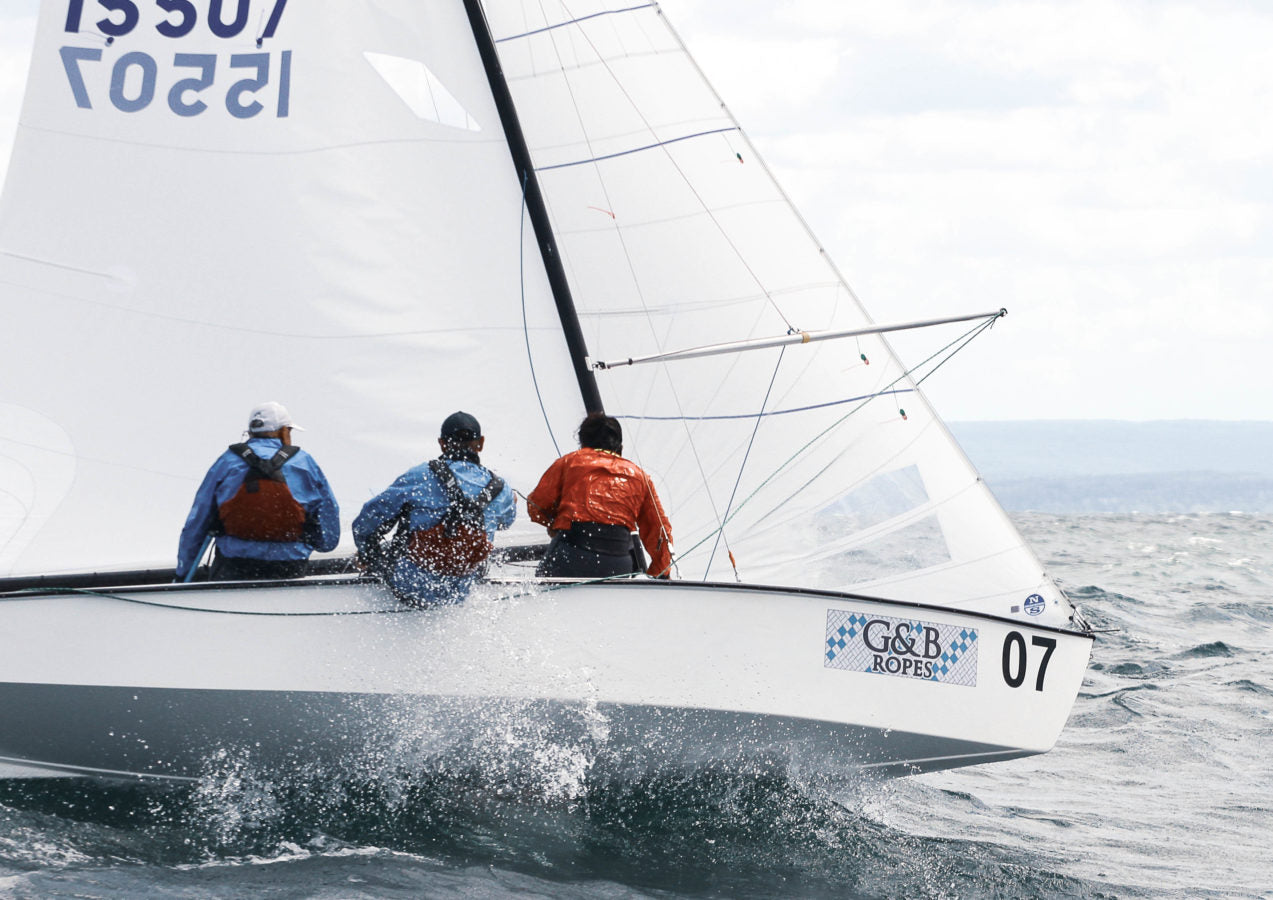
LIGHTNING LEGEND WINS 6TH NORTH AMERICAN TITLE
LIGHTNING LEGEND WINS 6th NORTH AMERICAN TITLE
Ched Proctor Bests a 72-Boat Fleet
2019 Lightning NA champions Ched Proctor, Chris Morgan, and Monica Morgan 📸 Art Petrosemolo nauticalphotography.us
According to the dictionary, “legend” is a person or thing that inspires. According to sailors, it describes a sailor who has performed and contributed to the point of being incomparable. After winning his sixth Lightning North American Championship last week, Ched Proctor has cemented his place as a “legend” under both definitions. With teammates Monica Morgan and Sam Blouin, he bested a fleet of 72 boats at the Buffalo Canoe Club in Crystal Beach, ONT, a week after winning the Masters North Americans with Chris and Monica Morgan.
Ched won his first North Americans in 1993, when he was in his 40s. Since then he’s won two International Masters Championships, 2 Canadian Opens, 7 Southern Circuits, and 4 Midwinters—along with dozens of wins in other one design classes.
Womens, Masters, Juniors NAs
The 11 day gathering brought teams from around the country. First up was the Women’s, Masters, and Junior Championships. On day one, a strong westerly sidelined all the fleets, so many teams headed to Niagara Falls. Day two’s fresh breeze allowed each fleet to get in two races. Day three saw lighter breezes but still in the mid-teens; Masters and Women’s teams each got in two races, while the Juniors snuck in a third before the deadline.
Women’s NAs champions: Deborah Probst, Monica Jones, and daughter Allie Jones 📸 Art Petrosemolo nauticalphotography.us
10 Women’s teams came from as far away as South Carolina and Florida. Regatta Chair Debbie Probst, with Monica and Allie Jones, bested Boat Grant recipient Christine Maloney with crew Grace Woodcock and Anna Flaherty by two points. Joy MacDonald grabbed the final podium spot with Kathryn Maloney and her sister Julieanne, a clean sweep for the BCC teams.
Doug Wake and his team (Noah Bartlett and Lars Osell) found the heavy air to their liking and won 4 of the 5 races to dominate the fleet. Parker Coluntuano/Jackie Morrison/Ben Markert had a solid last day and moved up from 6th to 2nd. Locals Robbie Robinson and brothers Gunnar and Garrett Grenauer finished third.
Meanwhile, Ched the legend won three of the four Masters races, beating 5-time World Champion Tito Gonzales, who was sailing with son Alberto and Rodrigo Zuazola, by six points. Tom Allen, the ILCA MVP, put together his NAs winning team from 1989 (!) of John Humphrey and Bill Pictor, and he used their “maturity” to finish just one point behind Tito’s team.
Juniors NAs champions Douglas Wake, Noah Bartelt, and Lars Osell 📸 Art Petrosemolo nauticalphotography.us
North American Championships
The NAs started with four qualifying races over two days to determine the 34 boat Championship Division. The qualifying races are often called the toughest regatta of the year, as your chances to be the North American Champion rest upon sailing well enough to “make the cut.” After the final race Tuesday, the line was drawn right below John Birkett and his team from Ecuador, with 25 points earning them the Tom Fallon Trophy as “the last one in.”
An easterly breeze dominated the first day of the championship series. The locals said this was the most unpredictable and challenging breeze direction, and they were certainly right!! The three race winners were Adam MacDonald, David Starck and Tim Scanlon, and most teams had scores that looked like they belonged on a Bingo card. David Starck took the overall lead with a 2,1,18, while Ched and team opened the series with a 15, 11, 3.
The next morning’s breezes mimicking the previous day and it was another tricky day to be consistent. Jim Barnash won the first race of the day. Bob Martin, after a 25 the previous day, hit the consistency button with a 4,4,5,4 to bring his team into the hunt. Overnight leader David Starck opened the day with another 2nd, but a 15 in the second race allowed Ched’s more consistent 3,1 to take over the lead.
Friday dawned as predicted: a beautiful sunny day with not a whisper of wind. Once the RC cancelled racing for the day, Ched, Monica and Sam were the 2019 North American Champions. Regatta Chair David Starck, with Jody Lutz and Dylan Farrell, finished 5 points back. Bob Martin, with Steve Hunt and Diego Escobar, won the “regatta of the final 4 races,” but without a discard they had to settle for 3rd overall.
Presidents Cup
The Presidents Cup became the “Allen Family Cup” this year as Jim Allen, with daughter Abby and sister Jane, bested older brother Tom Allen IV, with his daughter Shelby and Jim’s son Tyler. Third was Sjoerd-Jan Vanderhorst with his wife Kathy and Laurie Dieball guiding him around the course.
Lightning experts Skip Dieball and Brian Hayes running morning tips
READ MORE
READ MORE
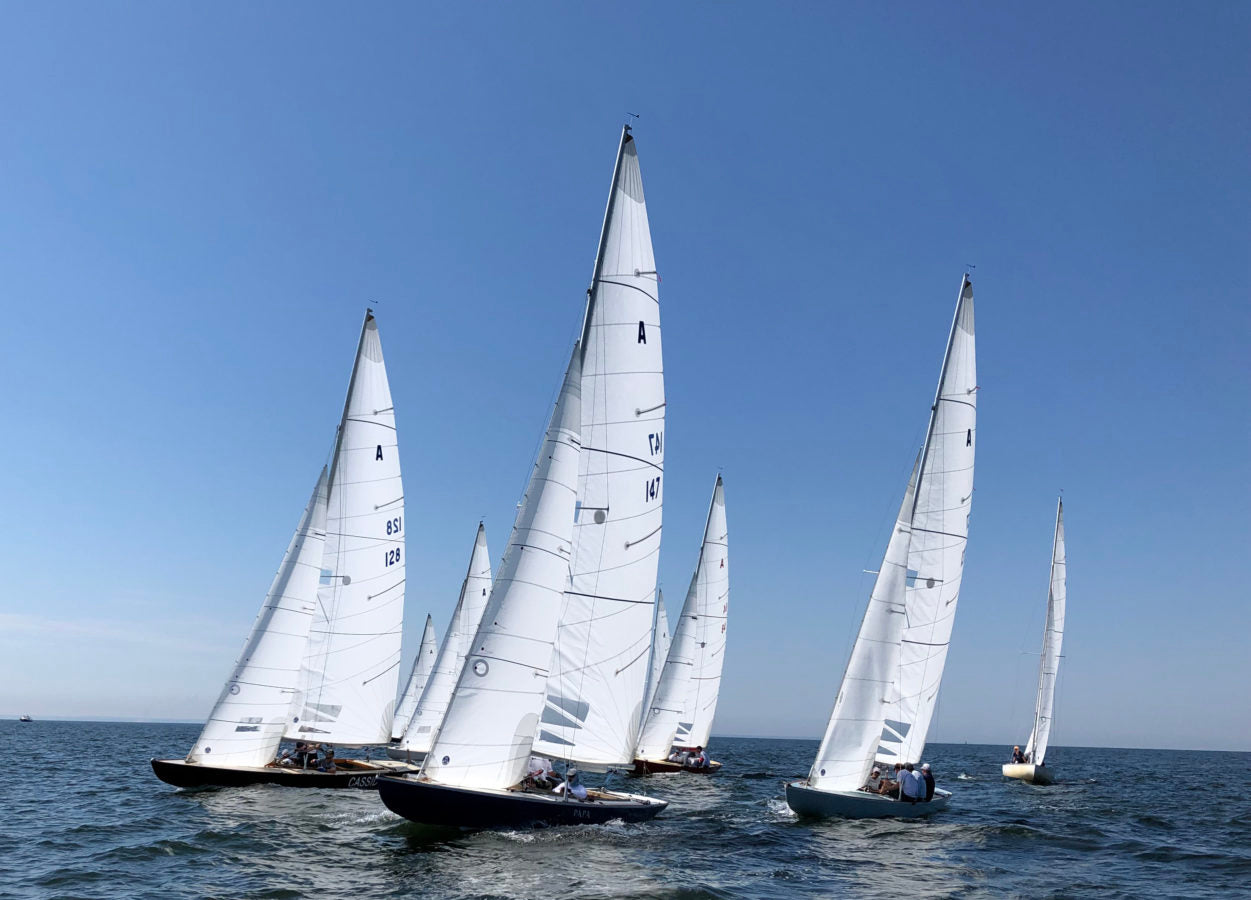
ATLANTIC NATIONALS TAKEAWAYS
ATLANTIC NATIONALS TAKEAWAYS
Experts Tim Healy and Rodrigo Meireles Share Key Tips
📸 Cedar Point Yacht Club
The 2019 Atlantic Nationals took place at Cedar Point Yacht Club in Connecticut with twenty-seven teams attending the three day regatta. 6-12 knots from east to southeast with moderate to heavy chop made for intense competition in these classic boats, followed by great hospitality ashore.
After the first day of racing, North Sails expert Tim Healy led a debrief with Dave Peck, Bill Healy, Steve Benjamin and Morgan Trubovich on the panel (representing skippers, trimmers and tacticians). The crowd had a lot of good questions and sailors found the panel very helpful.
David Peck from Niantic, CT won the regatta convincingly, posting only seven points after six races and a drop. Steven Benjamin finished second with 14 points and Rodrigo Meireles finished third with 19 points. We are happy to report that the top twenty teams used North Sails.
The top five boats all used the FRC mainsail, AP Jib and V-2 spinnaker.
Tim and Rodrigo’s Takeaways
JIB SETUP
Set the height of the jib so that the foot overlaps on the deck by 1″ max. In light air, move it down as low as ⅛”. This will prove a good deck seal to trap the wind from going under the sail, which will maximize its power.
Never let the upper jib leech tell tale stall. Find max trim by trimming so it just stalls, then easing just enough so it is flowing 100% of the time.
CHECK PREBEND
At the base setting for your rig, it should be about 1.75-2″ for speed in a range of conditions. (The fastest boats at CPYC use 2.5-2.75”, as they sail mostly in 5-8 knots.)
DOWNWIND TIP
Work hard to separate the spinnaker from the mainsail. The main is so big that it easily shadows the spinnaker. Be careful not to pull the guy back too far or set pole too low. You can even try easing the halyard up to 6″.
HEEL ANGLE
Try to keep the upwind heel angle as constant as possible. Crew weight adjustment is key.
Full results
📸 Cedar Point Yacht Club
Rodrigo Meireles and team Elan sailing fast. 📸 Cedar Point Yacht Club
READ MORE
READ MORE

COUNTDOWN TO ROLEX TP52 WORLDS
COUNTDOWN TO ROLEX TP52 WORLDS
North Sails Designer Mickey Ickert’s Insight on the Next Big Event
📸 52 Super Series / Martinez Studio
The 2019 52 Super Series has been one of the most competitive to date. At T-minus one week to the Worlds, there are just 17 points separating first from fifth after three of five events, and not one team is clearly running away with the big prize right now. Nine of the eleven boats competing are powered by North sails, including Azzurra who is currently at the top of the leaderboard. We’re excited to see how this final event unfolds.
Mickey Ickert is a veteran North Sails designer who specializes in Grand Prix sail design with a specific focus on TP52 development. We sat down with Mickey to get his take on who’s who, how the fleet is sailing, and where we should place our bets next week.
What are your crystal ball predictions for the Worlds?
Palma is very well known and was the location of the first pre-season event. The familiarity with Palma will require teams to focus on subtle differences and fine-tuning. The fleet is so close this year that any of the top five boats could win the 2019 Worlds. The one wildcard could be Sled, who had an impressive pre-season showing at Palma Vela in May.
How do you see the North sails stacking up for the expected conditions in Palma?
Speed is king for getting off the start line to the first shift, and our 2019 3Di structures are proving to have an edge. Typical Palma conditions will call for using the light main with the light-medium jib. We’ve been focusing on pushing the sail weight down to maximize the advantages of 3Di against string sails, and maximizing the crossovers between the light and AP mains. Jib-wise, the new Raw 890 light-medium jib should excel through all the puffs and lulls.
📸 52 Super Series / Martinez Studio
People, product and practice are all factors that play into a successful season. What do you see as the game changers in 2019?
People are a real game-changer this level of sailing. Provezza’s new afterguard gelled well and sailed the most pre-season, giving them confidence. Bronenosec is winning races with the addition of Sîme Fantela as the strategist. My observation is the younger sailors in the fleet are pushing the boats harder, racing is more dynamic, reaction times are faster, and sail changes are happening more quickly.
Product-wise, I am expecting the newly developed 3Di Raw 890 has given our teams more sail card options through the Worlds and then heading into the final event of the season. So far it’s hitting our design targets; better shape-holding, and cleaner aesthetics.
What’s 2020 going to be like?
The new venues have already been announced and we know South Africa will be more breeze. We’ll fully review that plan at our global design meeting in November, but for now, all eyes are focused on the 2019 Worlds—and after that, the final Super Series event in Porto Cervo.
📸 52 Super Series / Martinez Studio
READ MORE
READ MORE
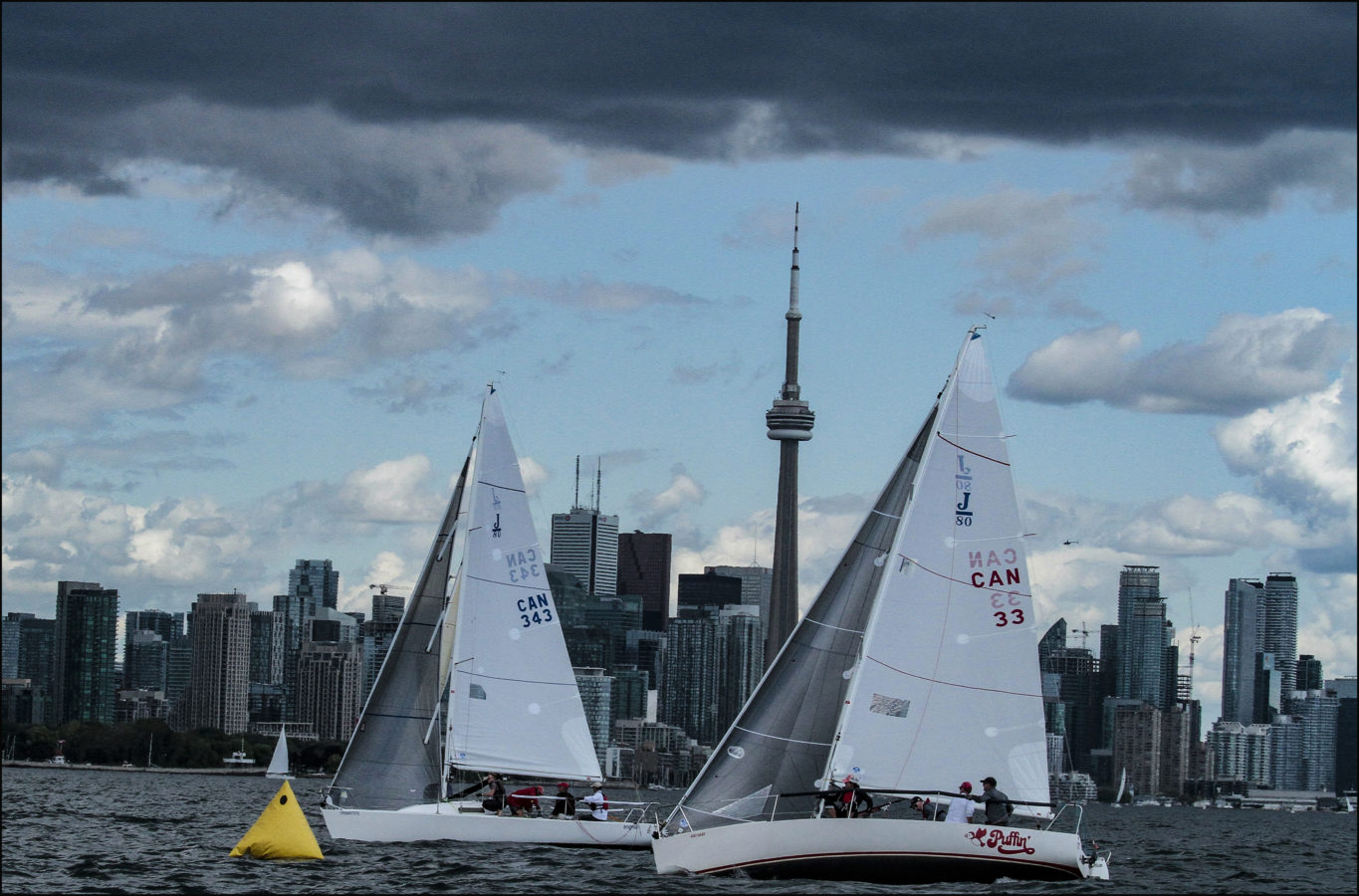
EVENT SPOTLIGHT: NATIONAL YACHT CLUB OPEN
EVENT SPOTLIGHT: NATIONAL YACHT CLUB OPEN
Big Breeze Shakes Up NYC Open
The 4th annual NYC Open Regatta took place on one of the most beautiful summer days we’ve had this year and featured great sailing winds ranging from a short AP in the morning until to winds filled to strong shifty and gusty conditions challenging the most experienced of skippers! Thanks to North Sails for providing the skippers and the Race Officers with a needed accurate Weather Forecasting via SailFlow. The RO’s and volunteers managed to get four races off despite ever-changing conditions. The post-race Garden Party sponsored Beau’s proved to be a wonderful afternoon venue with great entertainment from Jenny Braund and band. Almost 100 participants joined in on the dinner and it did not disappoint. NYC’s F&B team presented an amazing Tandoori BBQ chicken and all the fixings. Compliments to NYC’s F&B abound for the awesome meal as well as the Beau’s Five for $20 draft! The party went on till dark with live entertainment and then shifted to members playlists continuing until the wee hours… With a 12% increase in participation of boats over last, this year’s regatta hosted 58 boats in seven competitive divisions. The majority of boats were One Design as we observe a continued shift towards smaller crews and tighter fleets. We also saw an uptick in participation in the NYC membership returning to numbers seen several years back, maybe due to the Humber Bay Challenge that we put out between EYC and us. The Rigging Shoppe generously contributed gift cards to the appreciative 1st, 2nd and 3rd place winners.
Congratulations to all our winners:
Mandate J 105 RCYC Terry McLaughlin/ Rod Wilmer
Zingara Beneteau First 36.7 NYC Richard Reid
Surprise Melges 24 NYC Dan Berezin
Lifted J80 NYC Christopher Hobbs
Wild deuces VX One RCYC Paul Currie
Three's Company J 22 NYC Paul Davignon
Warington Kirby 23 QCYC John Woolsey
For the overall regatta results, visit www.lorc.org On Sunday, many raced in the first race of the AHMEN/PHRF Fall Series, hosted by NYC and raced for the Argosy Rose Bowl. For overall results, please visit www.ahmen.ca Thank you to our participants, volunteers as well as to the Rigging Shoppe, North Sails and Beau’s and to all sponsors who helped to make the LORC series a success! Lawrence Alexander Vice Commodore – Fleet National Yacht Club – Toronto
READ MORE
READ MORE

SPINNAKER SNUFFER INSTALLATION GUIDE
SPINNAKER SNUFFER INSTALLATION GUIDE
Making Your Downwinds More Easy and Enjoyable
© Amory Ross
North Sails cruising spinnakers and Gennakers™ equipped with Snuffer Plus™ spinnaker snuffers make downwind sailing faster and more enjoyable, while saving much of the aggravation normally associated with off-the-wind sailing. When used properly, a cruising spinnaker can add miles to your daily runs. Cruising spinnakers can be quite simple to deploy, even with a short-handed crew.
Step 1: Attach the clew and foot
On a dry, clean, open area), secure the head of the sail to a post and run the leech and luff making sure that it is free of any twists or tangles.
Step 2: Laying out the Snuffer Plus™
In the same way that the spinnaker was straightened, attach the “head”of the Snuffer Plus™ to a solid point and pull the sleeve out making sure it isn’t twisted. Use the colored stripe on the sleeve as a guide.
Step 3: Prepare the Snuffer Plus
Once the spinnaker and the snuffer have been laid out straight, use the internal retrieval line to pull the cone of the snuffer all the way to the head exposing the swivel
Step 4: Attaching the sail
Attach the head ring of the sail to the swivel inside the snuffer. Make sure that the screw or shackle is as tight as possible.
Step 5: “Snuff” the sail
Once the head of the sail is attached, pull the Snuffer sleeve down over the sail making sure neither the sail nor sleeve is twisted.
NOTE: On Gennakers™, the cone will not cover the entire sail and should end approximately one foot from the clew. Allowing the clew to go into the sleeve could risk damaging the cone when the sail is deployed underway. Battens can be taken apart by removing the tape and while holding the back section of the splice connector, flexing the front end up and down while exerting pressure in the opposite direction as the arrow.
Step 6: Loading the sail into the EZ Launch & Store™
Box Turtle
When the sail is ready to be placed In its turtle, lay the turtle out as shown, attaching the tack ring to the green Velcro tab and the clew ring to the red Velcro tab.
Insert the cone of the Snuffer into the bag first. Flake the sail into the bag leaving the head of the snuffer on the top. Use the Velcro tab at the center of the bag to secure the head and Velcro the bag shut. Finally, use the straps on the bag to cinch the bag shut.
READ MORE
READ MORE
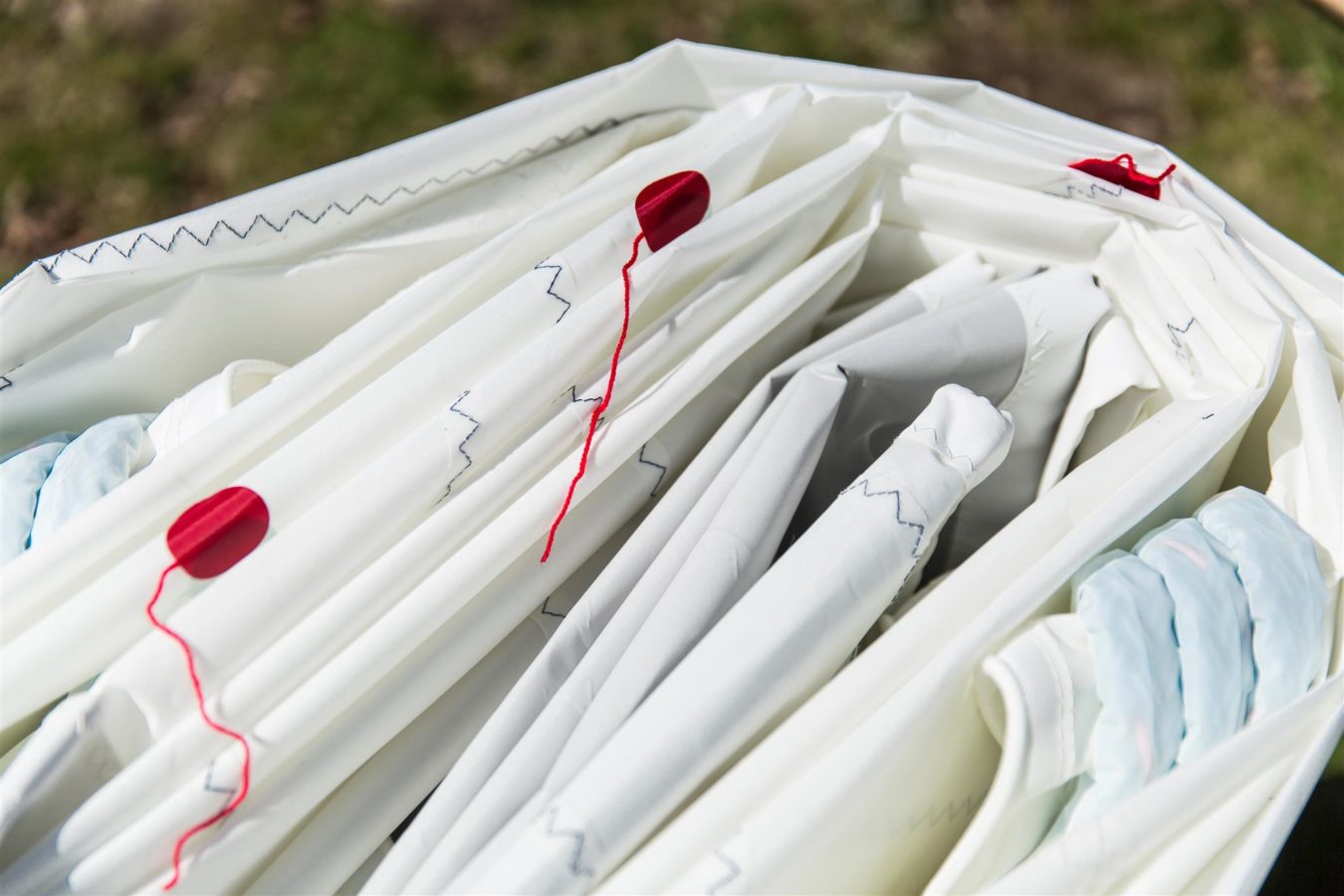
GIVE YOUR OLD SAILS A SECOND LIFE
DO GOOD. DONATE YOUR OLD SAILS.
Putting Your Used Sails To Work
North Sails and Etibicoke Yacht Club have partnered to help promote the recycling and re-purposing of used sails. Bring your old sails to the EYC Open and we will organize the donation of them to Friends Of Ile-a-Vache Haiti, where they will be re-purposed to benefit the lives of the local community.
Questions? Talk to our team and find out more about this program.
READ MORE
READ MORE
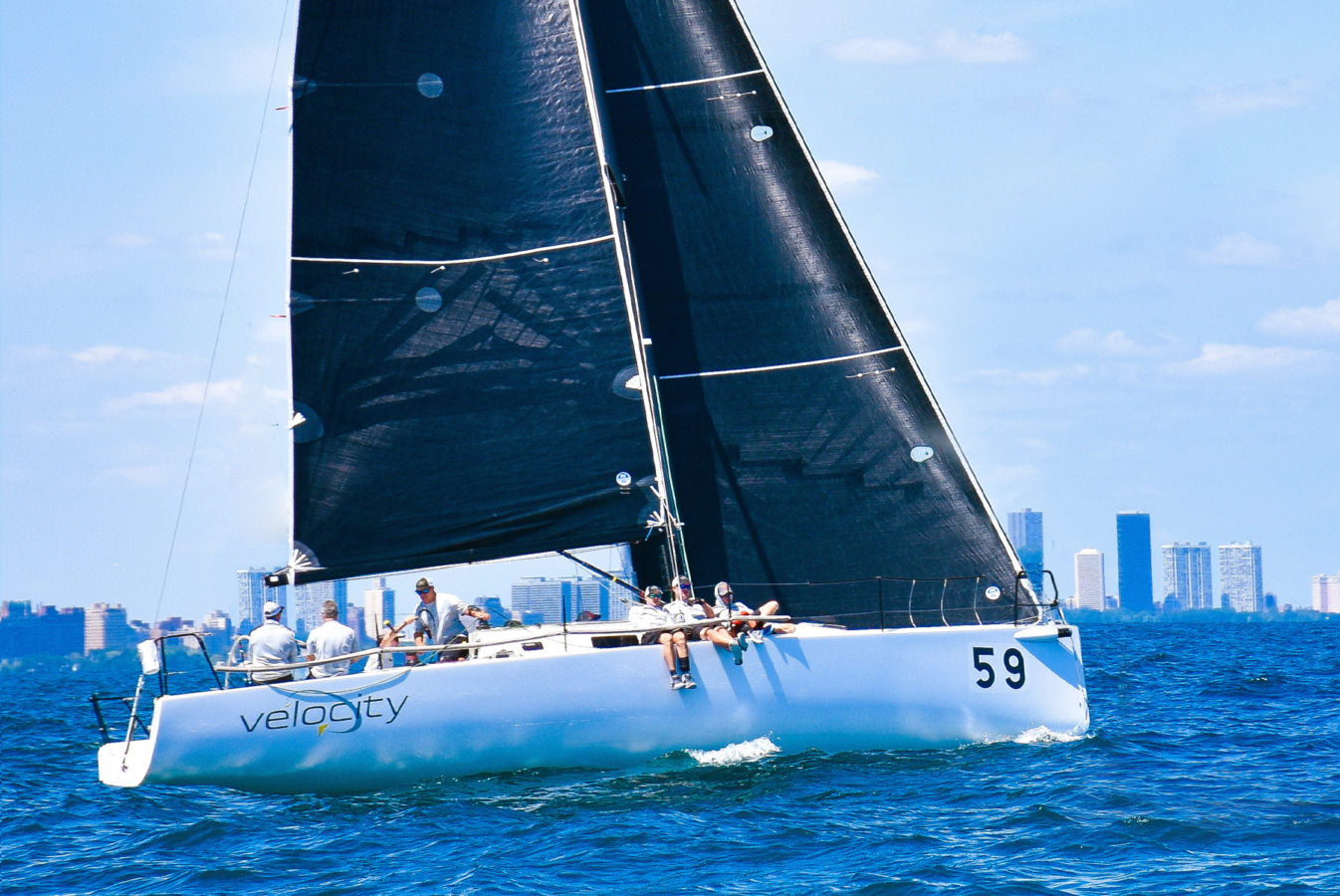
SPEED READING: J/111 PRE-WORLDS
SPEED READING: J/111 PRE-WORLDS
Preparing For The Grand Finale
Tough racing conditions at the Verve Cup / J/111 Pre worlds © Sara Proctor
North Experts Seadon Wijsen on Skeleton Key and Allan Terhune on Velocity sailed the Verve Cup, which was also the J/111 Pre-Worlds. After three days and eight races, both teams had plenty of takeaway lessons. Here’s what they had to share.
“The racing conditions were typical for Chicago,” says Seadon. “Light and lumpy, and extremely challenging at times. Our light air speed and technique was top priority.”
Allan agrees. “There were bands of wind that came down the course, forcing you to connect the dots and stay in the pressure as long as possible. Light air boat speed was definitely a big factor, but it soon became apparent to us that getting clean starts were going to be the key to this event.”
Lessons learned from Pre-Worlds
The fleet got eight races in, a chance for both boats to experiment with settings in the search for better light air speed. Seadon’s team played with jib halyard, jib leads, and in-haulers to help transition through the wind ranges. They also tried a looser rig. “It helped our accelerations, but didn’t make much of a difference in our straight-line speed. Moving the jib lead forward helped, so maybe we were just carrying the lead too far aft in general before.”
Allan says Seadon was able to help his team with an off-the-boat observation. “We learned from Seadon that we had too much inhauler on in the light stuff. I had this inclination that if the crew was on the rail hiking, we’d need to pull the inhauler in all the way. What it actually did was close the slot and create stall, which was easy to do in the light air. Onboard we couldn’t see it, but Seadon noticed from off the boat. Too much inhaul was deadly.”
Both sailors agree that the most important thing for J/111 boat speed is keeping the boat in the right mode. You don’t want to pinch, especially if there is chop.
“You need to keep an open mind on every leg. It’s easy to doubt yourself, so you can’t focus too much on the fleet, rather sail your own race and focus on what you think will have the best outcome.”
In the light air, it was easy to over-trim the sails. “That was slow, and we had to be super sensitive to this,” said Seadon. Allan added that course corrections had to be very subtle as well. “When we felt slow, we’d put the bow down to help build speed, but if we went too far, this caused us to stall.”
Racing in Chicago, Seadon says, it’s hard to find any consistent pattern to the wind. “You need to keep an open mind on every leg. It’s easy to doubt yourself, so you can’t focus too much on the fleet, rather sail your own race and focus on what you think will have the best outcome.” Allan has sailed out of Monroe Harbor in many different classes, and he agrees. “It is very easy to think that it will always do this, or it will be this way—and it most definitely does the opposite.”
© Sara Proctor
What to work on
Seadon has been racing with Skeleton Key for four years and says his team’s consistency is what’s led to their success. “Our rig tune, sail selections, and techniques through the wind ranges are all the same as they usually are. We don’t try to change much last minute, and we usually improve each time we sail.”
In the short gap between the pre-Worlds and Worlds, they have a list of things to work on. “We need to improve our leeward mark roundings. We can do that by discussing the planned maneuver, and weight placement. We are also going to look at different batten combinations for light air and windier conditions.
“The key for us is to try to improve the things we are lacking, but also focus on what works; we don’t need to reinvent the wheel.”
On Velocity, Allan says they will primarily be looking at their acceleration off the starting line, the leeward mark, and speed out of tacks.”
Looking ahead to the Worlds, Seadon admits Chicago is one of the toughest places to race—and they face some great competition. “We will have to be mentally tougher. I think we will be better in the lighter air conditions this time around. We are hoping to have a nice range of different conditions throughout the regatta, and maybe even some breeze.”
Both teams plan to sail as much as they can, and want to line up with as many boats as possible. As Allan puts it, “It’s about getting as much data as you can before the regatta starts.”
Skeleton Key initiating a jibe in tough light air conditions © Sara Proctor / Verve Cup 2019
Have questions about tuning? Check out our J/111 Tuning Guide
Click here to view all of our products J/111 inventory
READ MORE
READ MORE
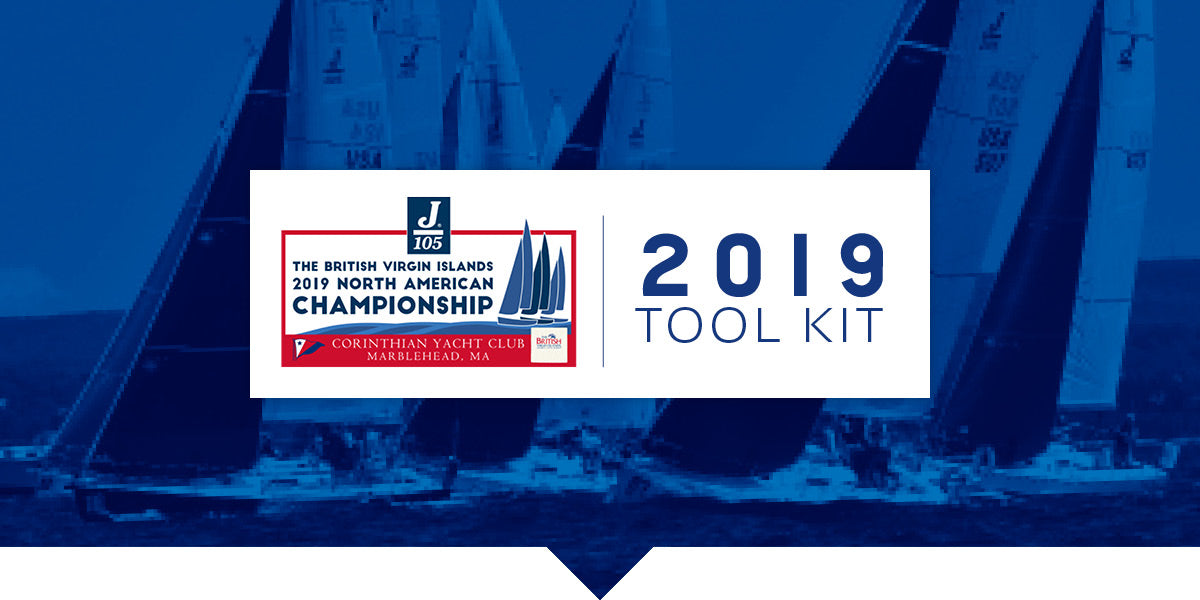
J/105 NORTH AMERICANS TOOL KIT
Get The Most From Your J/105
The 2019 J/105 British Virgin Islands North Americans in Marblehead is just around the corner. Is your team ready? Our J/105 Tool Kit will help. Created just for J/105 sailors, by our expert team.
#NSVictoryList
There is no better performance test of a one design sail than the results it produces. In 2018 alone, North Sails J/105 inventories helped teams win regattas all over the US.
Tips From The Champ
Champion Terry McLaughlin shares some tips that helped team Mandate win the 2018 North Americans.
Downwind Tips & Tricks
How to sail as deep as possible while still keeping your speed up. Before your next regatta, read this downwind manual from expert Will Keyworth.
Define Your Speed
Pulling all the pieces together can be challenging. Our J/105 Speed Guide will help you leverage our expertise to make the most of your sailing.
Fine Tune With North
Find your groove. Get your numbers. Be confident in all wind conditions. After countless hours of sailing, sail testing, and competing in the J/105, our championship winning sails will get you up to speed quickly.
Working With The Best
Our J/105 sails deliver the best results for our clients. Contact your local expert and join us at the front of the pack.
READ MORE
READ MORE
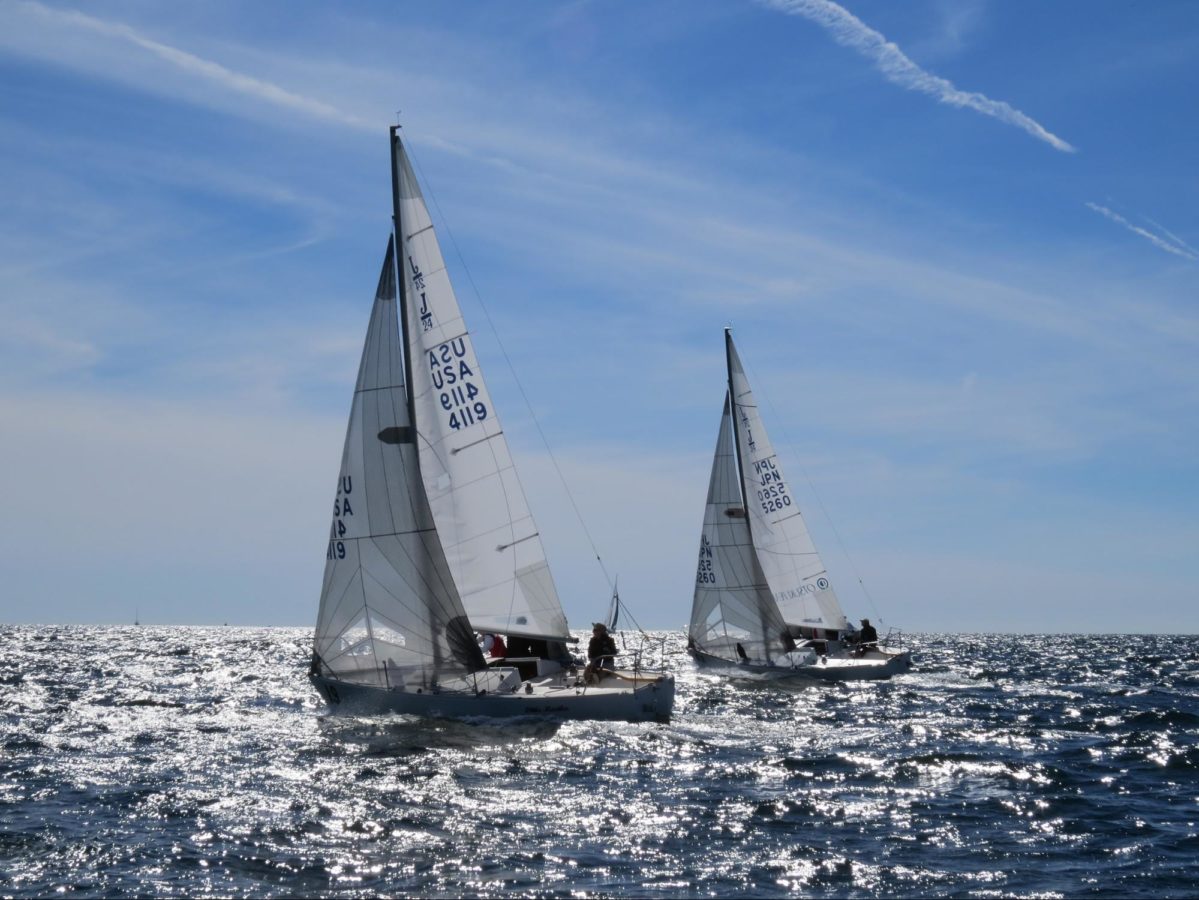
J/24 US NATIONALS: LOCAL KNOWLEDGE
J/24 US NATIONALS LOCAL KNOWLEDGE
North Sails Expert Mike Ingham Explains What To Expect in Rochester
They call Rochester “Leftchester”. But of course it is not always that simple! We asked North Sails expert and Rochester local Mike Ingham what sailors should expect when they leave the docks at the 2019 J/24 US Nationals.
First, some basics:
The predominant winds are in the West quadrant (WSW to NW).
More often than not, systems come from the West quadrant, most often WSW
The thermal is NNE
The Genesee River flows North to the lake passing through Downtown Rochester before dropping considerably in altitude, passing RYC and emptying it’s silt into the lake
The racing area is typically straight North or NE from the river. It’s not quite in a bay, but the land does indent like a very open bay, so there is land from West through South to East. From West through North to East is largely exposed
The Lake is large and deep. It is around 350 miles long and 70 miles wide. The Niagara River flows into the lake on the SW corner and that water empties into the Atlantic by way of the St. Lawrence River in the NE corner
Here are some thoughts for each direction:
South Quadrant:
It’s shifty in all of the South directions.
The city of Rochester is ~8 miles up the Genesee and over 400 feet above the lake. That means the wind coming down that long hit is really unstable as it tries to mix in with the air below
Heads up puffy lake sailing.
Since the wind comes down that long hill, sometimes the puffs don’t hit the water so you don’t see them coming. Need to look and try and connect the puffs, but also need to be ready to react to whatever comes your way.
Top of the course is the most shifty because it is closer to land making the last move to the weather mark and the first move out of it pretty critical
All S directions (system driven)
Flat water
SOUTHEAST
Can happen, but is not common. Almost always associated with some rain and storm coming, but not always
Can get a lift off the right shore, but not consistently
Not a sustainable direction, it is unlikely to lock into the SE for more than half a day before something changes it
Will rarely turn into a thermal because it is associated with bad weather disrupting any land convection.
SOUTH
Relatively common system breeze
Often warm clear weather
Super shifty
Rarely any geographic pattern (like get to a shore) because relatively square to the land
SOUTHWEST
Relatively common system breeze
Can be nice clear warm weather, or can be humid with t-storms rumbling through especially in the afternoon
Can be very windy, but is relatively flat
Very shifty puffy – heads up!
West Quadrant
Common System driven
Often windy, clear
Relatively steady compared to the S winds, but still some shifts
Can have T-storms associated, especially late in the day
Out further in the lake, there can be big waves, but where we race there is a shore to the West, so that cuts down on big wave. Still choppy though.
Often very favored left because of a lift off shore and flatter water
North, Northwest System
N or NW System breeze about once a month lasting a few days (when it is windy)
Cold wind from the North
Often windy
BIG steep waves (up to 10 foot)
In the spring and summer, this is an oscillating breeze, so play the longer shifts, could be 5 min + oscillations
But in the fall, since the lake is warm and the air cold, mixing makes for big holes and puffs
Northeast System
Rare
Unstable often rainy and stormy
Does not last long
Play shifts, but don’t expect a solid pattern
Can be big waves if it does last a while because it has a very long fetch from the East end of the lake. But often does not last long enough to build up the really big waves
Northeast Thermal
Almost always a Thermal Sea breeze
Lite. It rarely gets into double digits
Like any other thermal, need a temperature differential. The lake peaks at around 65deg so it can happen even on a cool day.
The lake can “turn over”. Only the surface is warm and if the lower cool water mixes, it can get cool overnight to the mid 50’s
Flat water
Even though it is coming from the lake, it only goes out a few miles and does not have time/ distance to build up much chop
Once filled in, left seems to work more than not
Current
Surprisingly for a lake, you could see up to 1.5kts of current. Usually W to E parallel to the shore (but occasionally it inexplicably goes the other way –some kind of eddy).
You can’t predict it but can easily tell which way and how strong by watching which way the river silt exits the river on your way out.
It is caused by the bathtub effect, plus the flow of Niagara Falls (W to E). The lake is 300+ miles long and a low pressure system at one end or the other will suck the water that way, then when that pressure system goes away, the water “sloshes” back.
It is relatively even over the race course, there is rarely any local eddy or current relief anywhere because the lake gets deep quickly. You have to go right near shore and we don’t typically race there.
READ MORE
READ MORE

PATRICK MURRAY'S TRANSPAC DOWNLOAD
2019 TRANSPAC TALES
Race Aficionado Patrick Murray Talks About His Favorite Offshore Event
📸Sharon Green / ultimatesailing.com
We caught up with Local North Sails expert and Transpac aficionado Patrick Murray to get his personal download on the race.
What makes this race so special to you and other sailors who keep coming back?
This race has become my favorite race by far, globally, anywhere. 2019 was the fifth time I've sailed it and now on five different boats. So that’s five different styles and different teams every time. Every time I get more respect for what it takes to do the race, and the preparation that goes into being ready for the race.
The Transpac is a small version of what the people in the Volvo talk about where, if you ask some crews on day three when they're heading out, it's cold and you're smashing upwind, and there's probably a few people that are not feeling all that well on the boat, you'd probably think they would never want to do it again. But in total, you get to Hawaii, the experience of finishing at Diamond Head, and the downwind sailing for days on end, of just ripping along, people want to do it again for sure.
I think as far as this race goes, the results are one thing, but it's really just an accomplishment to be prepared and be at sea for nearly two weeks, handle all the conditions, the squalls, everything that gets thrown out at you out there. It's not your everyday race, and to see guys like Paul really excited at the finish, and the culmination of all the work, effort, and training, its extremely rewarding.
How was this years race for you?
The light air start didn’t favor breaking records but the conditions were nearly perfect; nice pressure, perfect reaching, and powered up sailing conditions the whole way. I think if you were to go through the fleet, it was a pretty windy and maybe just the tick above averages, in terms of how much wind. So it was a really proper offshore race and a proper offshore sail, that it put a few boats in tough situations and other boats and in a situation that they could thrive in really nice, heavy air conditions.
I was on a Swan 60, Good Call. We started on Friday and had a perfect sail over to Catalina. Essentially we never had to tack, fetched on starboard tack, and made our way around Catalina, and then it was just beautifully windy the whole way across.
📸Sharon Green / ultimatesailing.com
And on that note, how did you prepare your clients for this race?
One thing I think people don't necessarily really think through or know if they haven't done the race, is that the beginning portion of the race is very hard, and it's more upwind and tight reaching. You have about 400 miles, and maybe up to 500 miles of pretty tight, cold, rough sailing, where you really have to earn that really beautiful downwind trade wind sailing. It's very different than the beautiful pictures we see with boats planing downwind off Diamond Head at the finish.
You start upwind and it's a beat, medium to light air beat to Catalina, and then it's just off the wind, close reaching for some part of a 12 - 24 hour period. And then the breeze slowly goes from some version of west 270 and clocks through northwest. This is when you start seeing the wind up near zero out of the north and you're working through a full reaching inventory. That portion of the race is really critical, and which sail you use, and how you use them to get to different portions of the chart, is hugely important.
What did you do personally and with your team to prepare for this race?
On our boat, one of the things we did was try to eliminate having to carry too many sails. We would use our upwind sail and kind of an all-purpose upwind sail and heavier 3Di that could be used in heavy air. Then we were able to use a higher clew and a second clew, and a second configuration for that sail, so that we could use it as a reaching sail as well, which really helps in terms of gear management. You have to take so much stuff on this race, but if you can eliminate any of it, especially the upwind that goes away pretty quickly and then just turns into weight that you're carrying.
On Good Call, we spent a lot of time working on the boat and getting everything ready, a lot of sailing time to work on those reaching configurations to see where they're the most efficient.
How did you prepare your clients for this race?
I had six clients in the race, in six boats that I worked with very closely in terms of preparation in their sail plans, and then just in sailing and preparation for the race, as well.
That was the approach that we worked on with multiple boats so that we could keep the inventory as neat and clean, and efficient as possible, without having too many sails that you have to carry the whole way. And that's one of the benefits of 3Di, is that we were able to use those sails in a wider wind range, and also dual purpose uses in terms of a bit of a reaching sail, a Blast Reacher or Jib Top in some cases.
With some of the other teams, I spent a lot of time with a few crews that were doing this race for the first time, working on their inventories in terms of what sails they had, and how to utilize them, but then also many hours out on the water coaching them.
📸Sharon Green / ultimatesailing.com
READ MORE
READ MORE
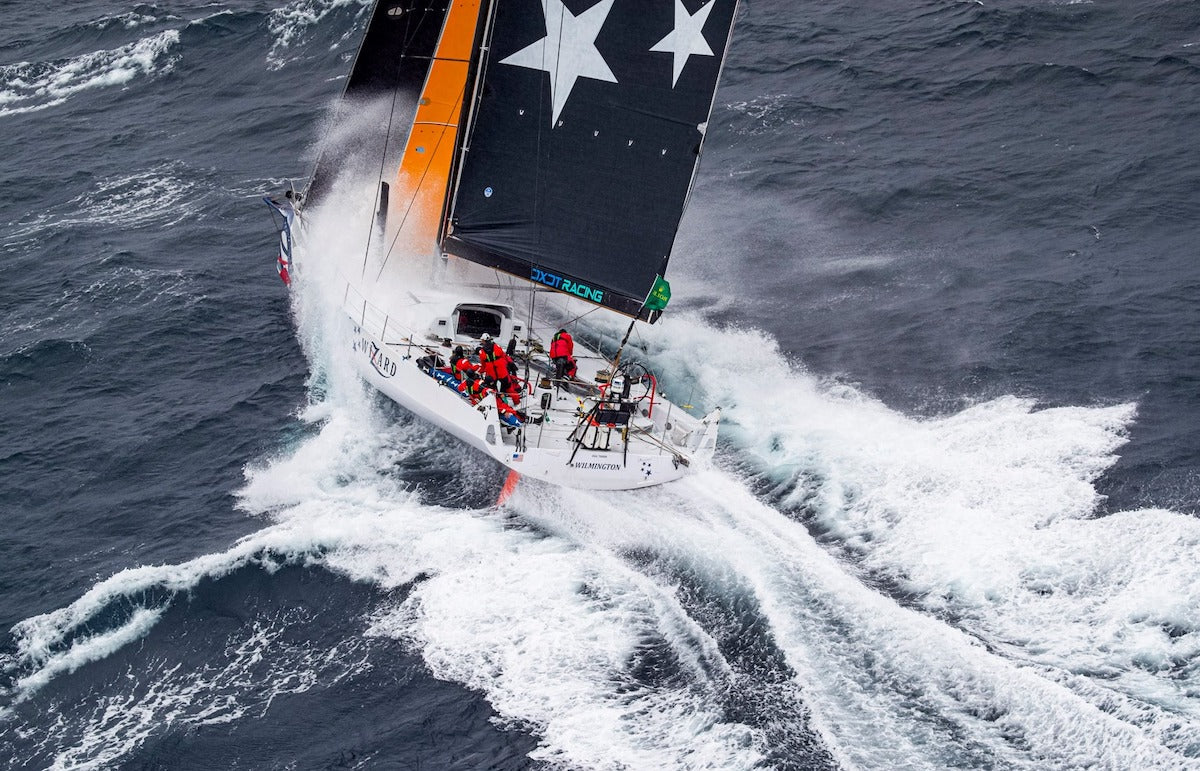
WIZARD'S WINNING RECIPE
WIZARD’S WINNING RECIPE
A Methodical Approach to Setup, Schedule, and Sail Choices
Peter and David Askew are on a hot streak with their VO70 Wizard in this year’s Atlantic Ocean Racing Series. They’ve won three of the five events in the series so far; RORC Caribbean 600, 2019 Transatlantic Race, and Rolex Fastnet Race. Their chance to complete the season with a sweep comes on October 19th, when the Rolex Middle Sea Race starts.
Winning ocean races is why the brothers purchased Wizard (the VO70 that won the 2011-12 Volvo Ocean Race 2011-12, as Groupama) in 2017. As Peter puts it, “Our entire program has been deliberately focused on winning.” That program started with a core team that raced a custom-built Reichel/Pugh 74 on the Great Lakes and won the Transpac Barn Door in 2013. Once the brothers set their sights on the Transatlantic Race, though, they knew they needed a canting keeler. Groupama, then sailing as Giacomo, was for sale in Sydney, Australia after winning overall honors in the 2016 Sydney Hobart Race. “Chris Larson from North Sails helped us put a group together to get the boat to the starting line of the 2017 Sydney Hobart Race, where we won our class,” Peter explains. “We then brought the boat back to the USA, did the 2018 Newport Bermuda Race, and won the Gibbs Hill Lighthouse Division.”
Next, boat captain Chris Maxted took apart and overhauled all the major components and systems, while the sailing team returned to the Great Lakes for another successful season on the R/P 74. Once the Volvo Ocean Race 2017-18 concluded, Charlie Enright and Phil Harmer rejoined the team. “It was at that point,” Peter explains, “that we decided to go after the AORS events, starting with the Caribbean 600 in February 2019. David and I knew full well we had a weapon with Wizard, and the right people in place.”
A combination of ocean-ready boat and crew, plus all their planning and preparation, is why they’ve posted such an impressive string of victories, he adds. “You have to go pretty far back in sailing history to find another boat that has been as successful as this particular Volvo 70. Maybe Dorade, but in the last 30 years, I don’t recall a boat being this dominant in the world’s most challenging ocean races. Over its life this won the Volvo Ocean Race as Groupama, the Sydney Hobart Race as Giacomo, and Newport-Bermuda Race, Caribbean 600, Transatlantic and Fastnet with our Wizard team. It’s an amazing run and the next challenge is the Middle Sea Race.”
“Are we pleasantly surprised by the string of victories?” Peter asks. “Of course, but we never set out to be second or third. Our goal of having a competitive program has been very deliberate. David and I are competitive guys, and we always play to win.”
Charlie Enright has worked closely with the Askews to methodically build a program that could handle a heavy schedule of offshore racing. “Most races are won before they even start,” Charlie reminds us. “Wizard’s off-season and pre-race approach are to leave no stone unturned and to be efficient and rational with our decision-making. Chris Maxted does an exceptional job making sure the boat is ready to race.” The experienced crew includes Will Oxley, Rob Greenhalgh, Phil Harmer, and Mitch White; Phil won the VOR on the boat, and Mitch sailed a lot of miles under the Giacomo name.
“We have good sailors on our team,” Charlie continues, “but so do most of the other boats. The important thing is that we work well together. The boat is 75% American and 25% international, which is cool and somewhat rare.” And Team Wizard is only twelve people, while other similarly sized boats might have 20 crew. “A consistent, tight-knit group is key,” Charlie says. “When that gun does go off, we feel confident that we have as good a chance to win as anybody.”
Winning still takes sailing well and some good luck, he admits, “but the results are pretty consistent over the past year, regardless of what conditions we’ve been sailing in.”
The boat had done a lot of miles by the time the Askews bought her, but Charlie says they also used a methodical approach to replacing the inventory, initially a mix of 3Di Endurance and 3Di RAW. “Some programs take delivery, look at the year in which a particular sail was built, and just start replacing things sight unseen.” Instead, the team has been replacing “about one new sail an event,” which allows for learning and conceptual changes. For example, they’re now using a whisker pole reaching with the J0, a concept they took from the VO65s. The sail’s versatility allows the team to leave some other sails behind, Charlie adds. “It can take the place of the G1 in a pinch upwind. It comes at a rating hit because of its luff length, but we only really use it in events where there’s no real VMG.”
Putting together the best sail package isn’t “voodoo,” Charlie laughs. “We just try to think logically about what we’re doing and the best sail package to get there.”
For the 2019 Fastnet, Wizard added a Helix Code Zero to power them through the light spots. “We used it to VMG downwind off of Start Point,” Charlie says, “and then used the same sail to help us upwind in the light spot east of the Scilly Islands.”
Designer Max Tringale worked on Wizard’s Code Zero. “The size target was similar to the boat’s older style cabled sail, with the goal to not reduce the area or change the sheeting location. By combining Helix with Load-Sharing Technology, we were able to design a lighter, flatter sail that works across a wider wind range.”
Over the past year, Max continues, there’s been “a tremendous amount of collaboration within the North Sails Design Team to develop our latest Helix mold shapes, allowing us to build the flattest and most efficient sail possible. The flying shapes produced, along with Load Sharing between a small luff cord and the sail itself, allows the luff of the sail to project away from the boat, instead of sagging aft and leeward like traditional cabled sails.”
Charlie confirms that the Helix sail can be carried through a wider range of conditions. “It’s lighter, and the luff is not constrained by the cable. We’re learning how to optimize adjustments, not only with the sheet and the tweaker but also with the tack line. The self-supporting sail structure for sure reduces tack load for a given flying shape.”
Charlie predicts that Wizard will see even more benefit from the Helix, once they upgrade the 2015 mast that came with the boat. “That said, we have definitely seen a performance bump by adding the Helix sail.”It’s also easier to put in the bag, and lighter to carry around.
“Peter and David like this kind of sailing because every race is different,” Charlie concludes. They’re really good about picking a goal, picking a tool, and surrounding themselves with the right people. That’s why they’ve been able to achieve such good results in the last couple of years. I’m proud of what we have accomplished—we’ve got a good thing going.”
Peter agrees, and he’s optimistic that their hard work will continue to pay off in the Rolex Middle Sea Race. “ We will approach the final AORS event as we have the others, and see where it shakes out.”
READ MORE
READ MORE
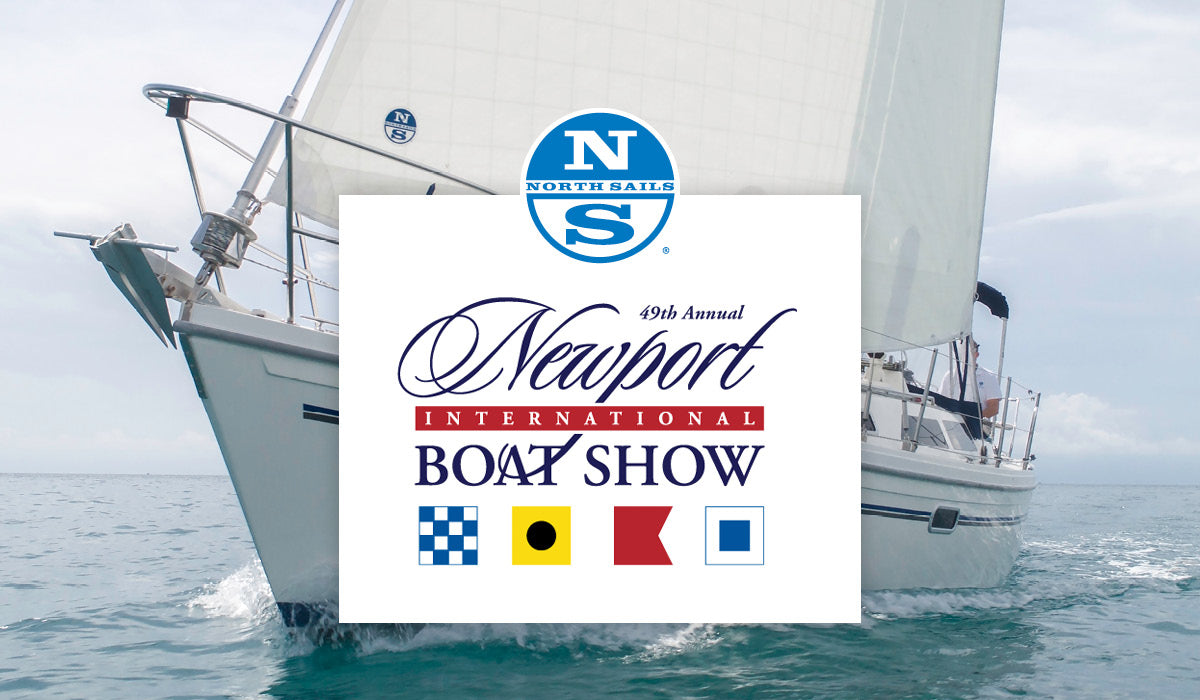
NEWPORT INTERNATIONAL BOAT SHOW TICKETS
NEWPORT INTERNATIONAL BOAT SHOW
RSVP & Get Your Ticket Free
RSVP by September 9th and include your favorite summer sailing 📸. We'll pick our favorite 50 and the winners will receive a North Sails hat and a ticket to the Newport International Boat Show.
READ MORE
READ MORE
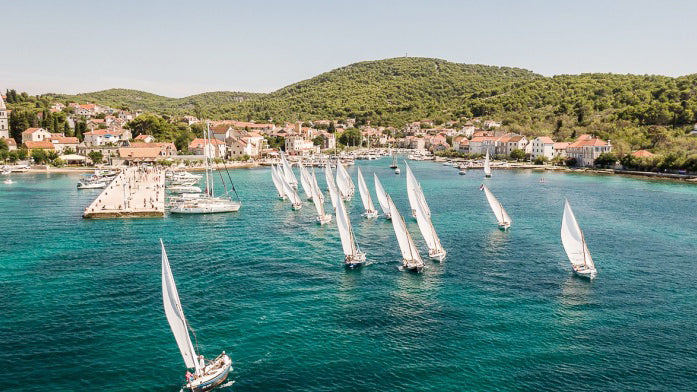
DVIJE TREĆINE SEZONE SU GOTOVE
Dvije trećine sezone su gotove
Srpanj, kolovoz i rujan su tri ljetna mjeseca rezervirana za sve ljubitelje tradicijskih brodica i jedrenja na način koji je vezan uz latinsko jedro. Ove godine prva regata/smotra tradicijskih jedrilica u Dalmaciji je bila 14. srpnja na 8. Ugriniću, okupljanju koje se organizira na otoku Pašmanu pod imenom "Đir po konalu".
Nakon toga je organizirana prva od tri regate na otoku Murteru. Domaćini su bili Jezerani, također po 8. put kao i kolege im s Pašmana. Njihova regata je poznata pod nazivom "Lantina", a ovogodišnji termin održavanja je bio 21. srpnja.
Slijedeća regata je bila najjužnija i održala se na otoku Krapnju pod nazivom Krapanjsko idro, a termin održavanja je bio 2. kolovoza.
Zatim karavana kreće prema sjeveru i prva iduća je regata koja se odjedrila na Zlarinu, "13. Latinskim idrom na kureja". Prvi termin koji je bio predviđen za Zlarinsku smotru je 27. srpnja, ali zbog vrlo lošeg vremena čiji dolazak je najavljen na vrijeme dolazi do izmjene termina na 5. kolovoza.
U principu riječ je bila o jedinom razumnom terminu, a da se regata ne odgodi na bar nekoliko tjedana, samo što je 4. kolovoza već odavno rezerviran za "Žensku veslačku regatu" u Betini. Iz logističkih razloga armavanja brodova koji za Betinsku regatu nisu trebali jarbole i ostatak opute, a i pratećeg efekta prigodne fešte, izostao je dolazak većeg broja sudionika s Murtera.
Dvadesetak posada iz Brodarice, Zlarina, Prvića, Vodica i Murtera ipak je osiguralo kontinuitet održavanja, a ove godine su uspjeli startati "na lancanu" i dosta brzo prejedriti zadanu rutu unatoč laganim uvjetima koji su vladali na regatnom polju.
Nakon starta flota je trebala lijevim bokom ostaviti plič Roženik, kao i hrid Galijola i vratiti se natrag u Zlarin. Puhao je lagani oštrin koji je omogućio spomenutu proceduru starta, a za one neupućene to je princip u kojem se svi sudionici vežu krmom jer su postavljeni niz vjetar i kad se signalizira start otvaraju se jedra i kreće se s regatom. Ovisno o portu iz kojeg se kreće i eventualnim dricevima koji bi mogli izazvati probleme u ovoj početnoj fazi jedrenja, u more se mogu baciti i sidra po kojima se natjecatelji povlače nakon što je dan signal starta.
Osim ovog starta u primjeni je i klasični "leteći" start kao na ostalim regatama, ali to je nešto što nije baš najbolje rješenje za ovaj tip brodova i regata, prvenstveno zbog manevarskih sposobnosti ove vrste plovila. Konkretno tu je najveći problem naglo i često mijenjanje smjera, što iziskuje posebne manevre u kojima nerijetko je nužna upotreba vesla.
Što se same regate na Zlarinu tiče, već nakon starta se izdvojila ekipa gajete Sirotica i svoju lidersku poziciju nisu ispuštali sve do kraja regate. Kako to obično biva na regatama, vodeći imaju malo više sreće s vjetrom, a ostali su upali u malo veće probleme u zoni između Roženika i Galijole gdje su se osim s bezvjetricom morali nadmudrivati i s vrlo neugodnim južnim kurentom. U svakom slučaju predviđene 3.5 NM svi uspijevaju proći za par sati i nastaviti se družiti u srcu Zlarinskog porta.
Već krajem tog tjedna, u nedjelju 11. kolovoza nastavak je putovanja karavane prema sjeveru. Luka okupljanja je u Prvić Šepurini pod imenom "13. Burtiž". Termin regate nije mijenjan zbog vremenskih ili nekih drugih razloga, pa je i odziv sudionika bio dosta velik. Ukupno je jedrilo 35 kaića, gajeta i leuta.
Puhalo je SW-W od oko 13-14 čvorova. Smjer vjetra i konfiguracija porta u kombinaciji s brojem sudionika zahtijevao je zadavanje starta letećom metodom, a nakon prelaska startne linije jedrilo se prema bovi postavljenoj ispred jugoistočnog rta otoka Tijata, rta Gaćice. Slijedeća točka obaveznog obilaska je bila još jedna bova, ovog puta ispred Logorunskih vrata, a nakon toga flota se trebala vratiti u Šepurine.
Sunčan dan i vjetra taman koliko treba, stvorilo je impresivnu sliku tradicionalnih jedrilica u svoj njihovoj raskoši punih jedara i bijelih brazda.
I ovog puta na čelu flote je bila Sirotica i tu svoju poziciju je suvereno držala do druge bove.tada se dešavaju dvije jedriličarske triler situacije. U stopu ju je pratio kaić Marinka koji je uspio održati pravu kombinaciju kuta i brzine i zahvaljujući tome što je Sirotica morala virati ispred bove da bi je mogla obići, Marinka preuzima vodstvo i bez opasnosti odnosi pobjedu na regati.
Ali da bi sve bilo još zanimljivije, s desne strane regatnog polja, za vrijeme ove situacije na bovi, stiže još jedna gajeta, Baba Ivanica. Ona iskorištava to što je Sirotica trebala napraviti dvije vire da bi pravilno obišla bovu i s malom prednošću preuzima drugo mjesto u generalnom poretku. Međutim, iskusna ekipa Sirotice ne odustaje i uspijeva sustići Babu Ivanicu i s jednom dužinom prednosti ući u cilj ipak kao drugoplasirani.
Iduća regata latinskog idra je na rasporedu u nedjelju 18. kolovoza u Betini, a nakon nje u rujnu slijedi veliko finale s najmasovnijom i najstarijom regatom koja se održava u Murteru.
READ MORE
READ MORE
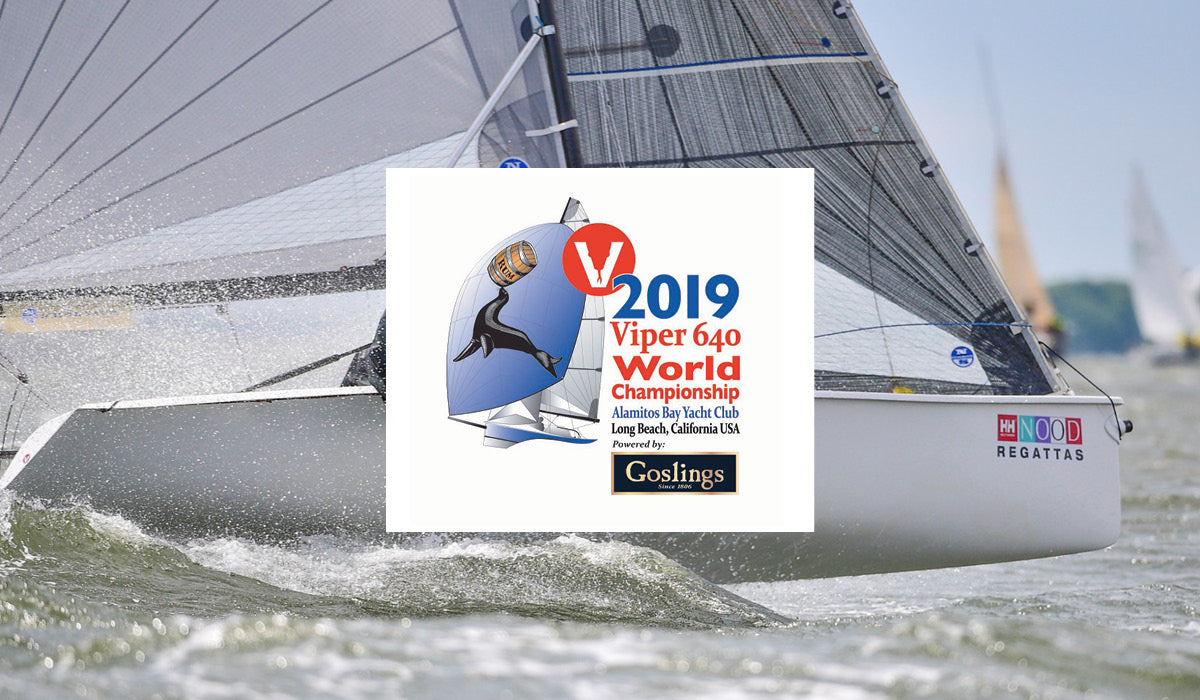
VIPER 640 WORLDS: LOCAL KNOWLEDGE BY ALEX CURTISS
LONG BEACH LOCAL KNOWLEDGE
What To Expect For The 2019 Viper 640 World Championship
Long Beach is hands down the best place to race sailboats in Southern California. With sunny skies, warm temperatures and consistent breeze, the 2019 Viper 640 Worlds should be a spectacular event. We spoke with North Sails expert and local Alex Curtiss to learn what sailors should expect when they leave the dock.
What will the breeze be like?
For the most part Southern California breeze is very predictable, but the morning marine layer will tell you a lot about what to expect on a given day. For example, if you wake up in the morning, and it is very overcast, maybe even a little hint of mist is in the air: expect lighter winds for the afternoon. If you wake up and it is a beautiful sunny day, I would imagine that it will be a typical Long Beach Day.
What is a “Typical” Long Beach day?
Essentially there are three sections to the breeze. Usually just before noon the breeze will be somewhere between 190-210 degrees. This will also mean the breeze is relatively light (5-8 knots). Then the breeze will trend to the right. A lot of times the second race is sailed in a breeze direction between 215-235 degrees, with velocity gradually picking up. Then by about 2:30 pm or 3:00 you could expect the breeze to progress further to the right (240-255 degrees). The velocity will be 15+knots and beautiful.
What are some things to look for to see the trend?
I like to pay attention to the marine layer, the clouds and the haze-line. More often than not, the cloudier it is, the more the breeze will stay to the left. The sunnier it is, the more the breeze wants to move right.
Another thing I pay attention to is the clouds inland over the mountains. If you see big towering clouds in the backdrop of the race course, that means the conveyor belt is going and expect a strong sea breeze in the afternoon. The last thing I pay attention to is the haze line offshore. The angle of the haze-line will tell you how the pressure is filling across the course. Sometimes the haze-line late in the day can run parallel to the port lay line forcing a left twist in the breeze near the top of the course.
What to expect from the different courses?
The NOR calls for three courses:
Course A is the “traditional” ocean course. Everything that was outlined in the previous comments hold true to race track. If there was one thing I would say is when the breeze goes past the 240 mark, the race to the right is real. Getting to the break-wall first with leverage will generally lead to good scores.
Course B is what I call the “Seal Beach” course. A lot of times the water is a little more chopped up due to being so close to shore. Waves will bounce off the beach and then wash together with the incoming swell, so speed is of major importance on this track. There also seems to be a little more left twist in the breeze down there as well, but there are probably more shifts to be played than course A.
Course C is probably my favorite of the three courses. This course is inside the breakwater, so flat water in the mornings and a bit of chop when it gets breezy. It is a bit more college style due to the oil islands, and how they affect pressure and shift. There isn’t a lot of rhyme or reason too much inside, but I would pay attention to the haze line angle if they set a course up near the breakwater.
What about Tide or Current?
Since you are in the ocean, there is really always current going down coast. There is really no relief but keep it in mind approaching marks and laylines.
Favorite Post-Sailing Nosh spots?
You can’t go wrong with the beers and food at Ballast Point Brewing company across from ABYC. Also anywhere on 2nd street is a great place to chill out and debrief with the team.
READ MORE
READ MORE

DOWNWIND TACTICS
DOWNWIND TACTICS
In our previous installment we rounded the windward mark just behind our rival. In this segment North U Director Bill Gladstone explores downwind tactics against a single boat when you round close astern.
Consider this scenario: We’ve turned downwind within a couple of boat lengths of our rival – close enough that she is “under pressure.” No other boats are a concern. Pos 1 – Set the Scene. How can we pass them? Here’s How:
Pos 1 – Set the Scene- to Pos 2 – Soak
Speed First
You won’t pass anybody if you aren’t faster than they are (or at least as fast and more clever). You’ve got to focus on trim and speed first. When you’re fast then you can make tactical plays.
Basic Principles
Chase to the sides; attack when they come back. You can’t cover on both jibes. The basic play downwind is to get into attack position sailing toward the sides of the course and then attack when your rival jibes toward the middle.
Soak to Position
To get into position to attack try to match your rivals speed while ‘soaking’ a little lower. Be careful not to over-do your soak, especially in light air. If you are slow your rival may extend away beyond your wind shadow. Pos 2 – Soak
Pos 2 – Soak to Pos 3 – Attack!
Attack!
As your rival jibes, you jibe. Do not delay. There’s no, “Ready to jibe.” The team is ready! Just turn the boat – that’s the “Jibe Ho” signal (Turn with weight, not helm). This ‘simo’ jibe puts your wind shadow on your rival’s air. Their windex should be pointed at you, and yours at them…
Pos 3 – Attack
Our jibe suffocates them and they never get to full speed out of the jibe. We roll over them into the lead before they can recover. Well done!
Pos 4 – Ahead. Pos 5 – They Strike Back
They Fight Back
Alas, the leg is not over. On our next jibe our rival returns the favor, jibing on our air. Pos. 5 – Attacked. We can’t clear our air and he rolls over us. NOT Fair!
Pos. 6- Rolled!
Come Out Hot
Sometimes you can escape an attack by ‘coming out hot’ – that is, reaching up to push your apparent wind forward coming out of the jibe. Probably a good idea to warn you team before the jibe of your intentions. It won’t work if you steer ‘hot’ but don’t trim ‘hot.’
Don’t Attack
A little while later our rival jibes again. We’re in position, but we don’t jibe. Why not? Recall our basic principle of chasing to the sides and attacking toward the middle: An attack here would violate that rule and leave our rival an avenue of escape to the inside. .
Attack or Cross-Over?
Eventually we jibe Pos 8 and they jibe again. As the boats come converge we are in position to attack. In fact, we’re closer than before – a scant boat length behind now. One option is to jibe on their air. See below Pos 9S.
Option to jibe
A jibe would put our rival in our bad air and allow us to roll them. This can be strong play. One potential downside is that they may be able to block us from jibing and crossing.
Note that if we do jibe, we should jibe when still 2 – 3 lengths away. That’s close enough for our wind shadow to work yet far enough that they cannot fight back with a luff. A jibe within a length leaves us vulnerable to a hard luff where our rival can take us “to the moon” and then drive off to clear air.
Fig: To the Moon!
Cross Over
The alternative to jibing on their air is to Cross Over and Jibe. By Crossing Over and Jibing we gain control. Though we aren’t dishing out bad air we now control the path to the mark. We hold the starboard tack advantage and can jibe when we choose.
Pos 10 – Cross Over and Jibe to Pos 11 – Control
Clear Air
The Cross Over can be tricky in light air or high-performance boats as you must avoid the wind shadow of the windward boat.
Pos 10 – Clear Air
Next Play
There’s always a next play. If our rival jibes we can match their jibe to a position with clear air aft of their shadow and with an avenue of escape to the middle. If we don’t jibe they may try to Cross Over and pin us in a reversal of our current set up.
Conclusion
From here we just need to sail fast to the leeward gate. In our next segment we’ll look at Leeward Gate Tactics.
READ MORE
READ MORE
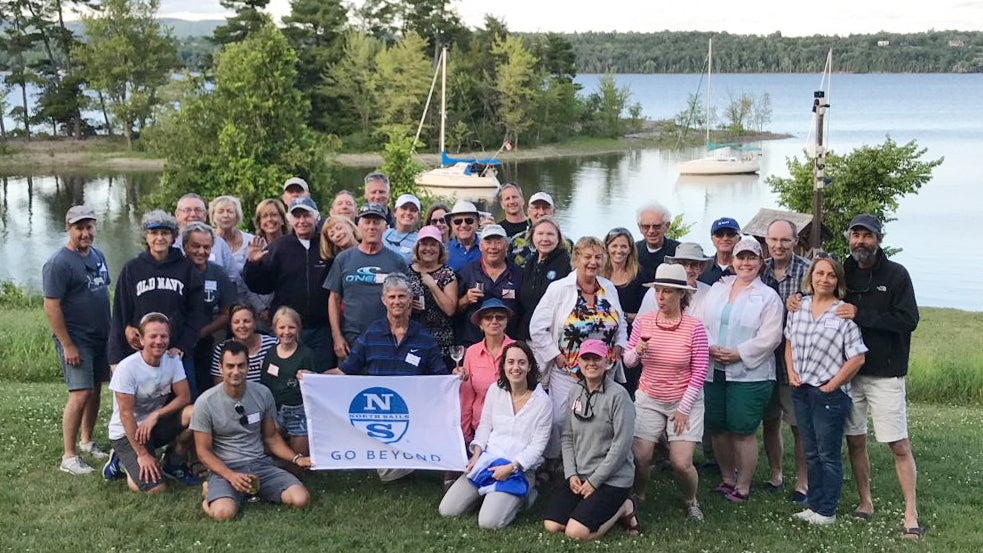
EVENT SPOTLIGHT: BYC CRUISE WEEK
EVENT SPOTLIGHT: BYC CRUISE WEEK
Camaraderie And Memories Along The Ottawa River
Thank you once again for supporting "Cruise Week", a 30+ year-old, family-friendly tradition at Britannia Yacht Club in Ottawa.
This event is a mid-summer, multi-day flotilla on the Ottawa River, which offers us 25 NM of ever- changing wind and a half-dozen rural anchorages. Cruise Week serves these purposes:
Mentor new or inexperienced sailors in navigating the Ottawa River
Meet new friends (new club members/boat owners, or first-time participants)
Catch up with long-time friends
Cruise Week 2019 (July 14-19) was once again a fun week in the sun and great heat - temperatures exceeded 30C every day. We had a record twenty boats join the fleet, and the highest number of “first- timers” in years. Crews were a diverse mix: new and seasoned sailors, aged 18-75; people who cruise and race here and around the world; and world circumnavigators. As is the tradition, Cruise Week started Sunday afternoon with an onshore BBQ at Pinhey’s Point, about 10NM upriver from BYC.
At the BBQ, similar to last year, we distributed North Sails beverage cozies and sunglass keepers. Many people brought theirs from last year ashore! These items were put to good use all week in the incredibly hot weather.
We shared food and laughter, and issued the 3rd edition of the Nautical Skills Challenge: those who complete any 4 of 6 skills such as heaving to, 2 COB drills (under sail), reefing/shake the reef, using the emergency tiller, steering with sails only, and 720 turns are awarded prizes.
Always a busy group, we socialized long into the evening on several boats. On Monday, the fleet had a slow downwind drift upriver to Baskin’s Beach in a 2-5kn east wind. After watering and feeding, we headed ashore for the World Quyon Bocce tournament. The competition was fierce, including one injured player placing winning shots with her non-dominant hand.
Eliminated players picked up additional North Sails drink cozies and frisbees, which were put to immediate use in the sweltering heat. After Happy Hour and dinner, (responsible) socializing resumed throughout the fleet.
On Tuesday, the fleet made the 5 NM jump to Mohr Island. The 12-18kn west wind made for a fun beat. Many boats used this opportunity complete skills for the Nautical Challenge, including reefing (with North Sails ties handed out last year!) and shaking reefs. Beer cozies weren’t put into use until we landed at the island.
We spent the afternoon swimming and relaxing, collecting our energy for a raft-up Happy Hour: a “blind” wine tasting. We sampled a great variety of whites and reds. No need for cooking dinner later; appetizers were abundant.
That's Karen again. She loves her North Sails swag honestly and is the life of the party.
And that is Jay, last year’s North Sails Grand Prize winner!
On Wednesday, wind direction, great weather, and whim (ie a need for a rest) dictated that it was worth staying at Mohr Island. A few boats made the 4 NM jump to Quyon for a few provisions, and exploration of Pontiac Bay and the Chats Falls dam. Happy Hour was another raft-up. By this point in the week, we’re quite a good-looking group with our North Sails hats! Those who went exploring upriver shared tall tales at Happy Hour. That evening was a full moon. We had our own full moon island beach party, complete with a fire on the water. If you can’t go to the British Virgin Islands, you bring the BVI to Mohr Island!
On Thursday, the group headed back downriver to Baskin’s Beach for more swimming and relaxing, and the grand finale – a rum tasting.
Thanks to your support, we had great prizes to hand out for special moments such as these:
Builder award - a North Sails book – to Harmonium, who built their own punt
Cruise Week first-timers and gracious host awards: North Sails hats, T’s, and a book to Days Off and Carina II, who also hosted their first Happy Hour (and did their first raft-up)
Creative sunshade - a North Sails hat awarded to Maelstrom, whose owner, an industrial designer, created a collapsible cockpit sunshade that’s placed over the boom while at anchor
Good Samaritan award – a North Sails hat – to Skedaddle, who ran a line to another boat and helped winch them off a sand bar when wind shifted and increased unexpectedly overnight
Mobile mechanic award – a North Sails hat – to Harmonium, for helping troubleshoot Inception’s engine problems
First Responder award – a North Sails hat – to Inception, who did first aid on a rather deep foot cut
Solo sailors award – North Sails T-shirts – awarded to Zephyr, Wind Rose, Bermuda, and Persistence for solo sailing, in the Spirit of the Golden Globe race which finished in the spring 2019
Nautical Challenge winner - boats who completed the skills were rewarded for their efforts. North Sails swag and T-shirts were distributed to those who completed the challenge
We had a wonderful group this year and did a thorough exploration of the river. New friendships began, long-term friendships strengthened, and we made many memories. The people who attend make this such a great event, and support from North Sails makes it even better. Many thanks again for supporting our club’s tradition.
Sincerely,
Catherine Trinkwon
BYC Cruise Week Coordinator
READ MORE
READ MORE
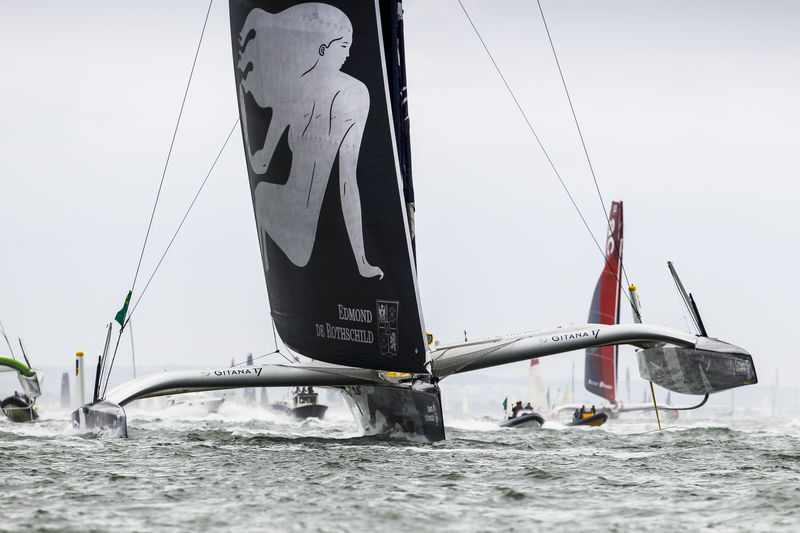
« UN VÉRITABLE MATCH-RACE » ENTRE EDMOND DE ROTHSCHILD ET MACIF
« UN VÉRITABLE MATCH-RACE »
Cammas et Caudrelier racontent leur course... et leur victoire !
📸 Paul Wyeth
Le maxi-trimaran Edmond de Rothschild (Gitana Team), skippé par Franck Cammas et Charles Caudrelier, est le premier bateau de la classe Ultim équipé de voiles North Sails à avoir franchi la ligne d’arrivée de la Rolex Fastnet Race 2019 à Plymouth dimanche 4 août. Il est suivi de très près par Macif, le maxi-trimaran de François Gabart (58 secondes d'écart). Sodebo Ultim 3 (Thomas Coville) et Actual Leader (Yves Le Blevec), également équipés de voiles North Sails, terminent respectivement 3e et 4e. En plus de décrocher la première place du podium, le multicoque Edmond de Rothschild s’offre un record de course de plus de 4 heures au passage du Fastnet rock.
Recruté depuis peu par le Gitana Team, Franck Cammas signe un très beau retour en classe Ultim avec cette victoire. Pour le skipper de 46 ans au palmarès impressionnant, il s'agit de son 3e Fastnet. Quant à Charles Caudrelier, 44 ans, il compte quatre participations à son actif et remporte le trophée pour la 2e fois (VOR sur Dongfeng). Les deux hommes se connaissent de longue date et ont beaucoup navigué ensemble. Ils nous confient leurs impressions sur cette édition 2019.
📸 Paul Wyeth
Vous avez offert aux spectateurs un très beau match-race entre Macif et Edmond de Rothschild. Comment c'était vécu de l’intérieur ? Cela force à pousser ses limites ?
Franck Cammas : Oui, c’était un véritable match-race avec moins de 3,5 miles d’écart pendant toute la course ! Une régate à vue comme on peut le faire sur une Volvo Ocean Race ou en Figaro. C’était très excitant de pouvoir le faire avec ces grands multicoques très rapides. De plus, Macif étant une référence dans la classe Ultim, cela permet de trouver les bons settings et les bonnes configurations d’appendices. Vu de l’intérieur, l’équipage (Morgan Lagravière, Erwan Israël, David Boileau et Yann Riou) était donc très actif et concentré... On a poussé au maximum ! Je n’ai pas beaucoup dormi pour ma part !
Charles Caudrelier : Effectivement, on s’est vite retrouvé seul avec Macif dans notre option Nord, et dès la première soirée, on était au contact en permanence. À partir de là jusqu’à l’entrée dans la baie de Plymouth, c’était une course de vitesse avec quelques choix de voiles. Le duel a tourné rapidement au match-race. Pour nous, c’était très intéressant. On a pu découvrir de nouveaux réglages pour aller plus vite. Ça force à pousser plus fort, mais on n’a pas eu de fortes conditions et de gros risques à prendre. On a vu que Macif était plus manœuvrant et on ne pouvait pas trop jouer à ce jeu-là. On a juste essayé de se rapprocher un maximum de lui en vitesse et d’attendre une opportunité d’attaquer sur le dernier bord. Étant devant, il devait choisir le moment du dernier bord, et il s’est trompé.
📸 Paul Wyeth
Vous battez le record au Fastnet rock (28 heures et 2 minutes). Vous pensiez battre le record à l'arrivée à ce moment?
Franck Cammas : On pensait que le record était jouable au départ au vu des routages. Là, on le bat de 4 heures, bien plus que ce que nous espérions. Une bonne cerise sur le gâteau ! Et un clin d’œil à Loïc Peyron, l’ancien détenteur (32 heures et 48 minutes) qui m’avait pris de son côté le trophée Jules Verne !
Charles Caudrelier : C’est la météo qui décide si on va battre le record ou pas. Mais c’est toujours plaisant de battre un record.
Avec qui travaillez-vous à North et comment cela s'est matérialisé dans l'approche du Fastnet ?
Franck Cammas : On travaille avec Gautier Sergent et Yann Andrillon de North Sails Vannes. Depuis le début du projet, on s’est concentré sur l’optimisation en détail de notre ancienne GV et la définition de nouvelles voiles pour améliorer nos performances dans le vent faible aussi pour recouvrir mieux le range des voiles.
Charles Caudrelier : Nous avons identifié des points faibles du bateau et on travaille tous ensemble sur les voiles avec comme objectif la Brest Atlantiques. Le Fastnet est la seule confrontation en course pour valider nos choix et nous avons eu de la chance de pouvoir valider le travail effectué et de nous conforter dans nos choix.
Franck Cammas et Charles Caudrelier 📸 Paul Wyeth
Est ce qu'il y a une voile en particulier qui ressort de cette régate et pourquoi ? Quelle était la plus utilisée (à part la GV) ?
Franck Cammas : On a beaucoup utilisé les voiles de petit temps finalement. En Ultim, on se cherche encore sur la surface et la triangulation des J0 (génois) et J1. Entre Macif et nous, ça s'est joué entre ces 2 voiles... À explorer encore !
Charles Caudrelier : C’est aussi intéressant de voir les J0 des autres bateaux et leur performance. Macif avait un nouveau J0 et de bonnes performances.
Combien de participations au Fastnet et comment cette édition 2019 se compare-t-elle aux précédentes ?
Franck Cammas : C’est mon 3e Fastnet (en Orma 60, Volvo 70 (Groupama 4) et celui-ci sur Ultim. En Volvo, c’était en préparation de la Volvo Ocean Race, une course qui fut serrée entre Groupama 4 et Abu Dhabi avec une arrivée très proche, mais nous terminions 2e ! Une belle bagarre aussi dans des conditions très variées. C’est souvent le cas lors du Fastnet.
Charles Caudrelier : Il s’agit de ma 4e participation. Mon premier à bord de Groupama 4 (avec Franck) qui était le premier test en course de notre Volvo 70. Un Fastnet dur avec du vent. Un double à bord de Gitana 15. Le 3e, c'était en préparation de la Volvo 65 avec Dongfeng où on finit premier quelques secondes devant les Espagnols de Mapfre. Je crois que l’écart était encore plus faible, un Fastnet avec peu de vent mais un gros combat entre sept VOR 65.
Quel est le programme pour vous en particulier maintenant et pour la classe Ultim ?
Franck Cammas : On va s’atteler à la préparation de la Brest Atlantiques, une course en double (avec Charles et moi-même) qui aura lieu en novembre et qui remplace en fait la Jacques Vabre pour cette classe. Et on continue à développer le bateau !
Charles Caudrelier: La Brest Atlantiques sera un grand test pour les Ultims volants : aucun Ultim volant n’a encore réussi à finir une longue course sans soucis techniques.
READ MORE
READ MORE
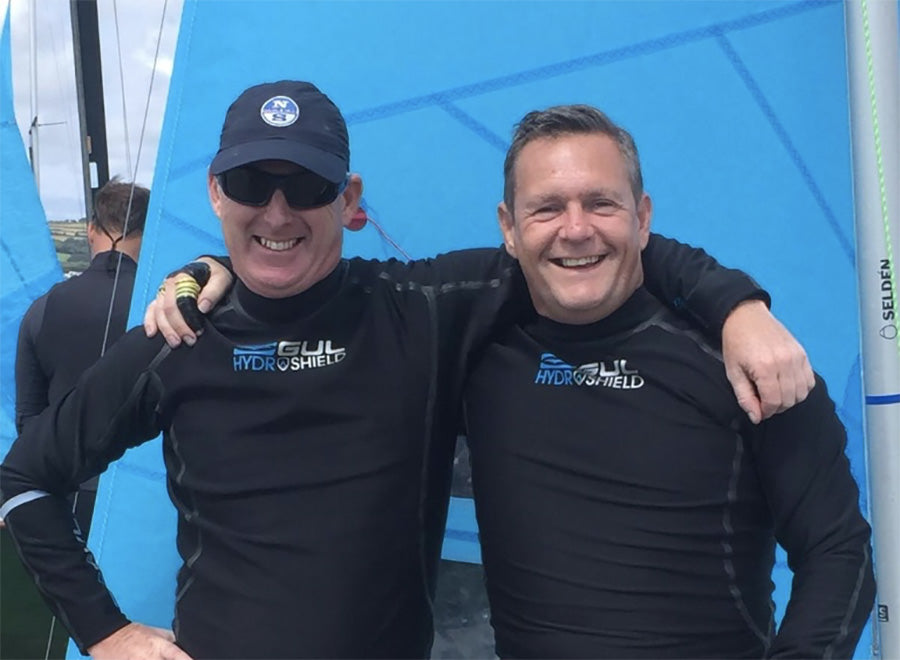
HOBSON & WHEATLEY WIN ENTERPRISE UK NATIONALS
HOBSON & WHEATLEY WIN ENTERPRISE UK NATIONALS
Close Scores Make Every Point Count
46 teams raced at the Allen, North Sails and Selden Enterprise UK Nationals held at Mounts Bay. After four days of heavy air racing the wind dropped on the last day giving the teams a complete new outlook for the last race. Defending champions Dave and Chris Jackman, and North Sails expert Paul Hobson and Craig Wheatly battled every inch of the race course. Heading to the final race both teams had four bullets with Paul and Craig having less points which guaranteed their win after a dramatic final race.
This is the first time Paul Hobson has won the Enterprise Championship on the helm making him the only sailor to win the event both as a crew and as a helmsman.
Class Expert Paul Hobson’s Key Points For Success:
Flat is fast. Always work on keeping the boat flat.
On gate starts, try to keep a nice space to leeward, making the mark rounding close and tight to the gate boat.
Don’t be greedy; minimise your risks and focus on the boats ahead.
Hobson/Wheatley used the North Sails SJ-4+ mainsail and the FG-3 jib.
Next for Paul and Craig are the October Looe SW Regatta followed by Winter Championships at Northampton in November.
READ MORE
READ MORE
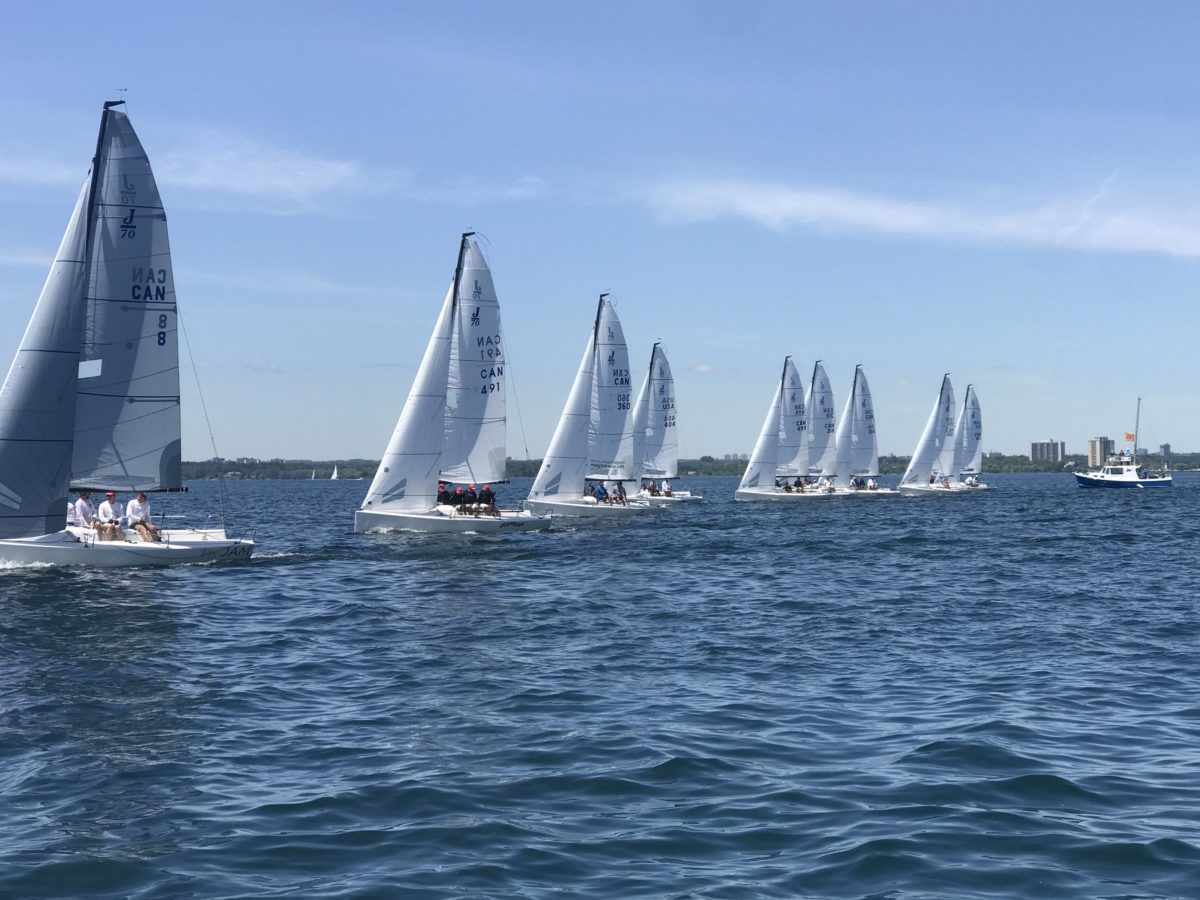
ANOTHER FUNDRAISING SUCCESS AT TAHR
ANOTHER FUNDRAISING SUCCESS AT TAHR
Sailing & Fun For A Good Cause
The 10th annual Toronto Area Hospice Regatta (TAHR) at Port Credit Yacht Club was another smashing success, raising over $47,250 for the Ian Anderson House Hospice (IAH). This brings our three-year total to over $152,000!!
Mother nature played a huge role with beautiful warm sunshine and a moderate, albeit shifty, offshore breeze keeping the chop to a minimum for the forty four boats participating on either the one-design course or in the fun one-day pursuit race.
When PCYC took over the reins of the TAHR in 2017 the goal, besides raising money for this incredibly necessary and worthy cause, was to bring some old fashioned fun back into the sport of sailboat racing. We reached out to everyone, including power boaters and casual family cruisers to try their hand at a less intimidating pursuit start race. Plus we threw in curve ball: the much dreaded/loved Noodle-Toss-Man-Overboard-Drill, making the results less predictable and the post racing war stories a lot more hilarious.
This year we had three volunteer rib teams tossing noodles aft of participating boats thus beginning their MOB recovery. Keep in mind that the noodles are light and easily bounced out of reach by both wind and bow waves so while it may have been quite the reality check for some skippers, this was no ordinary drill! All boats crossing the finish line must wave their noodle to be scored.
Mike Wolfs had his hand in everything from working with the PRO to make the vision of the fun race come to fruition, liaising with club management, getting some fantastic and highly coveted swag from North Sails, finding new sponsors and auction items and maintaining the sanity of the regatta chair and this author.
North Sails Toronto was happy to support TAHR again with a silent auction item and donation of all SI folders for Skippers!
READ MORE
READ MORE
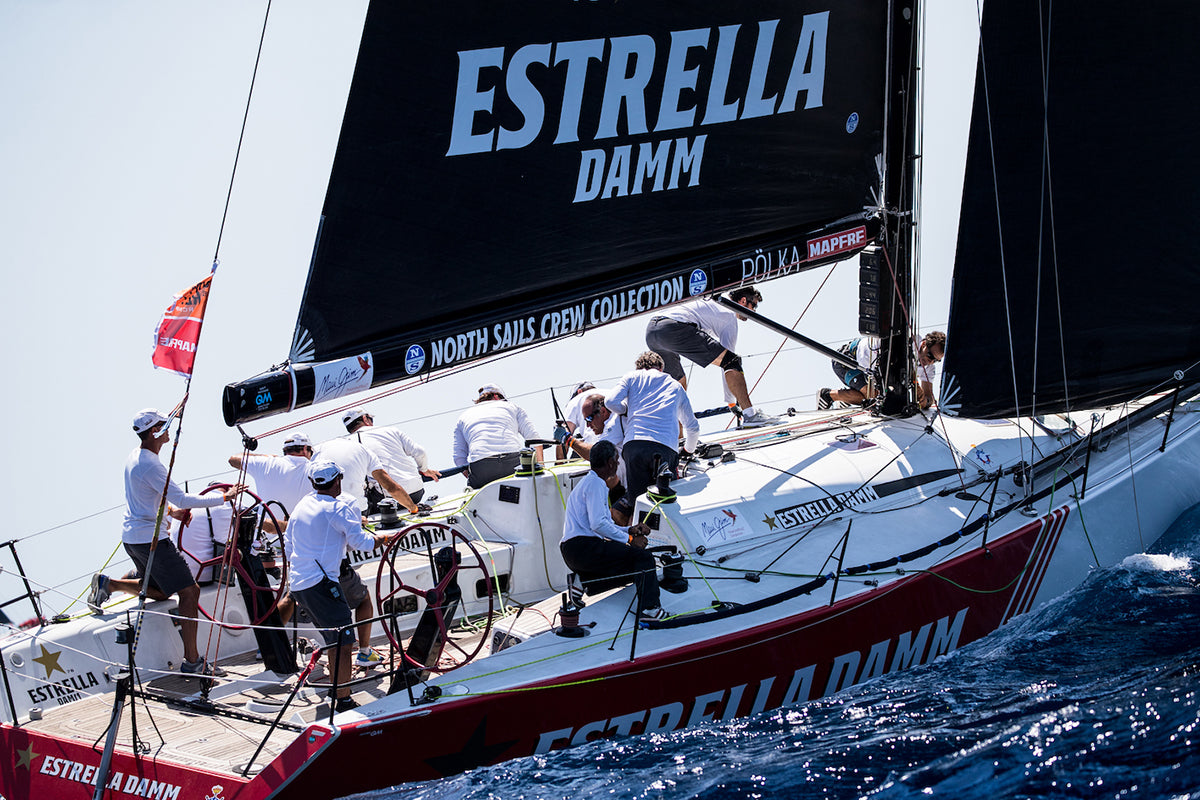
NORTH SAILS GANA LA 38 COPA DEL REY MAPFRE
NORTH SAILS GANA LA 38 COPA DEL REY MAPFRE
North Sails ha copado seis de los 11 podios de la 38 Copa del Rey MAPFRE.
📸 María Muiña
Incluyendo el campeón absoluto: el Estrella Damm patroneado por Luis Martínez Doreste, director comercial de North Sails España. En tierra, el servicio de velería North Sails reparó cerca de 100 velas durante la semana de competición.
Un año más, los clientes North Sails han triunfado en la Copa del Rey MAPFRE. En su 38ª edición, la regata multiclase más importante del Mediterráneo reunió en la bahía de Palma a 132 barcos de 26 nacionalidades, que durante seis intensas jornadas de competición lucharon por el título en 11 clases.
📸 Nico Martínez
La victoria absoluta correspondió al mismo ganador de 2018: el Estrella Damm patroneado por el director comercial de North Sails España, Luis Martínez Doreste. El DK 46 armado por Nacho Montes y Óscar Chaves dominó la clase BMW ORC 1 y además completó el mejor casillero de toda la flota, alzándose con el trofeo especial MAPFRE como mejor equipo en categoría tiempo compensado y el trofeo V Centenario como campeón absoluto. El Estrella Damm equipó inventario integral North Sails: velas de ceñida mayor 3Di 780 RAW, ligero-medio, medio-pesado 3Di 780 Endurance y 3.5; velas de popa A 1.5, S2, S4 y trinqueta de spinnaker. "Un buen inventario es fundamental para ganar la Copa del Rey, sobre todo tener velas nuevas", explica Martínez Doreste. "Una vela con un año o más ya no rinde al cien por cien, y en una Copa del Rey si no vas al cien por cien es difícil ganar. Nosotros pudimos utilizar un buen número de velas nuevas, y eso nos permitió aprovechar todo el potencial del barco. Es cierto que una 3Di dura más, puedes aprovecharla de un año para otro, como es el caso de nuestro foque ligero medio, que era de la temporada pasada. Aún así, creo que uno nuevo hubiese sido mejor vela".
📸 María Muiña
También lograron el título de campeón de la 38 Copa del Rey en sus respectivas divisiones con velas North Sails el ClubSwan 50 Cuordileone (clase ClubSwan 50), el Swan 45 Porrón IX (Swan 45), el ClubSwan 42 Natalia (Mallorca Sotheby’s ClubSwan 42), el GC32 Oman Air (GC32) y el TP52 Team Vision Future (BMW ORC 0). Clientes North Sails coparon las tres primeras posiciones de ClubSwan 50, Swan 45, ClubSwan 42, GC32, ORC 0 y ORC 1, y ocuparon posiciones de podio en ORC 2, ORC 3 y J80.
📸 Sailing Energy
"Para nosotros es una satisfacción que nuestros clientes elijan nuestras velas para competir en la Copa del Rey y en muchas otras regatas", continúa Luis Martínez Doreste. "Sólo hay que ver, por ejemplo, la clase ClubSwan 50, en la que todos los participantes equiparon North Sails; la clase ORC 1, donde los tres primeros utilizaron 3Di y velas de popa North Sails... Los comentarios de los clientes suelen coincidir: si una tripulación quiere ganar, la opción más segura es elegir North Sails. Sobre todo el 3Di, porque es una vela más estable, más duradera, más ligera y ofrece más rendimiento que las de la competencia. Además, navegan con la tranquilidad de contar con nuestro soporte en la propia regata: aportamos especialistas North Sails en cada barco, y ofrecemos el servicio cada día".
📸 Ian Roman
Servicio North Sails
Un año más, North Sails brindó su servicio oficial de recogida, reparación y entrega de velas a toda la flota de la Copa del Rey MAPFRE. Un equipo formado por siete veleros trabajó sin descanso en las jornadas previas y durante la competición para garantizar la satisfacción no sólo de nuestros clientes, sino también de barcos que equiparon velas de otras firmas. La furgoneta North Sails recogía al término de cada jornada de competición las velas que requerían servicio y las transportaba a la velería de Lluchmajor para que nuestro equipo pudiera trabajar durante la noche y dejarlas como nuevas antes de la primera señal de salida del día siguiente. A las nueve de la mañana, los clientes recibían sus velas listas para competir. Los números hablan por sí solos: a lo largo de la 38 Copa del rey MAPFRE, nuestros veleros completaron cerca de 300 horas de trabajo, 37 equipos requirieron los servicios de North Sails y un total de 93 velas pasaron por la velería. ¡Magnífico trabajo de North Sails Lluchmajor!
READ MORE
READ MORE
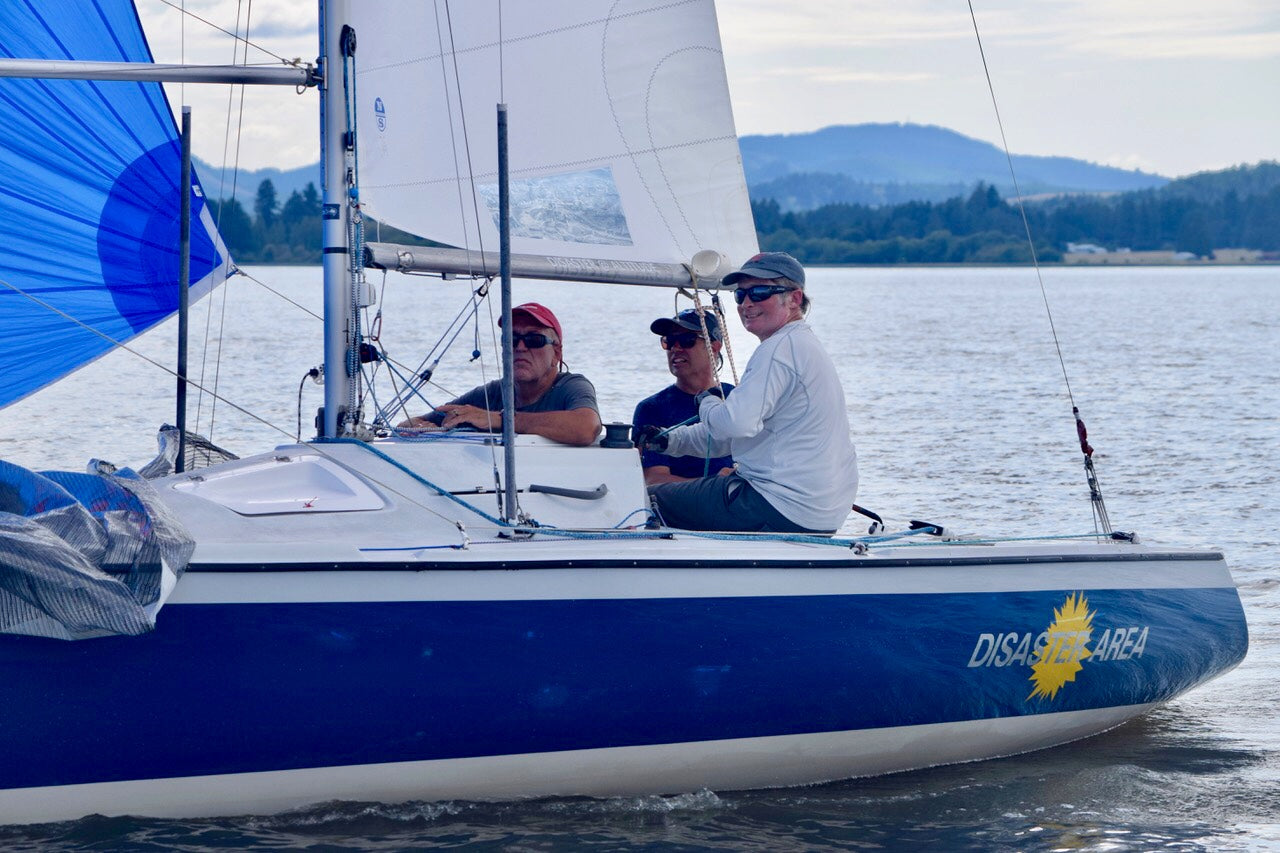
SANTANA 20 NATIONALS: KERR DID IT AGAIN
SANTANA 20 NATIONALS: KERR DID IT AGAIN
North Sails Helps Andrew Kerr Win His 13th National Title
📸 Richard Aaring
The 2019 Santana 20 National Championships were hosted by the Triton YC and Eugene YC’s on Fernridge reservoir in Eugene, Oregon 22 teams from Mexico, Colorado, Washington and Oregon were challenged with a seven race series over the course of three days with winds varying from 5 to 12 knots.
North Sails expert Andrew Kerr coordinated a practice day with on-the-water videos and a post-racing comprehensive debrief with all teams in attendance.
“The practice day with Andrew coaching the teams was very well received and helped them to get ready for the Nationals”, said Kerry Poe, North Sails Oregon
The racing featured a lot of gear shifting, particularly powering up in lulls and then responding to a quick build in the velocity. The goal was to be in phase at all times and connect the velocity upwind and downwind.
Starts were hotly contested. Team Disaster Area sailed with Kerry Poe on the helm, boat owner and tactician Andrew Kerr in the middle and former Class President, Phillip Infelise on the foredeck. “We focused on starting in the front row in the biggest space we could find, rarely did we start at the favored end. We would be toward it but in a lower density area so we could get off the line in phase and sail fast to the velocity and next shift”, said Andrew.
Patience paid as it generally always does on a lake. Very often a detrimental 30 degree shift would come in and the key was to wait it out until the wind came back to the median heading to then tack in the best gust of wind. Like many venues, it was critical to have your head outside the boat at all times to not miss big opportunities.
“The North designs gave us excellent speed in all conditions. The vision window in the genoa enabled our team to see starboard tack boats early and formulate a solid game plan for our boat to boat tactics.
The mainsail gave us all the flexibility of speed and shape that we needed with playing the backstay and the aft lowers. The spinnaker was stable and fast in all conditions. These designs have won the Nationals many times!,” said Andrew.
North Sails customer Evert Slijper and his team What about Bob? showed excellent speed and won race six. In fact, North-powered teams won four out of the total seven races. North Sails customers Jorge Murrietta’s Mexico and James Stinson’s Creamsicle also had excellent speed throughout the regatta. Congratulations to team Disaster Area for winning the Nationals with three bullets and consistent scores. This was Andrew Kerr’s 13th win at the Nationals. Very impressive!
Learn more about North Sails Santana 20 designs.
Team Disaster Area, winners. Kerry Poe (left), Phillip Infelise and Andrew Kerr (right). 📸 Richard Aaring
📸 Richard Aaring
READ MORE
READ MORE
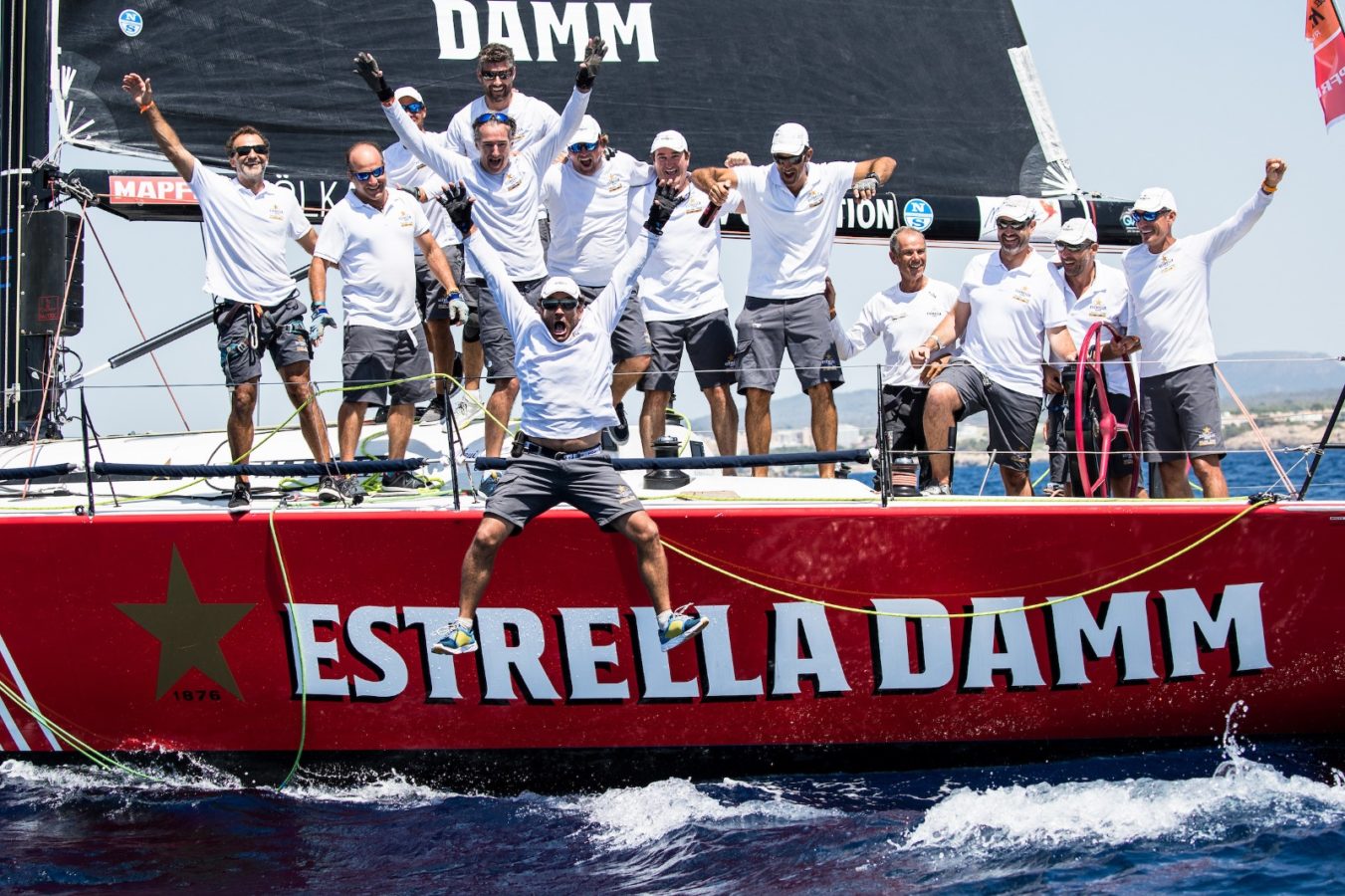
38TH COPA DEL REY
38th COPA DEL REY
North Clients Return To Defend The Title On The Bay Of Palma
© María Muiña / 38 Copa del Rey MAPFRE
The 38th annual Copa del Rey MAPFRE, organized by the Real Club Náutico de Palma and held on the Bay of Palma, once again boasted a record number of entries in the ORC fleet. North clients took home trophies in six divisions as well as both top performer awards (won by Leonardo Ferragamo’s ClubSwan 50 Cuordileone, and Nacho Montes and Oscar Chaves’ DK 46 Estrella Damm).
Copa del Rey is a big deal for North Sails each year, and there is plenty of onshore support required to keep our sailors on the water and up to speed. Our Palma loft provides overnight service most nights, working diligently on sails for yachts anywhere between 30-60 ft. The pre-regatta days are some of the busiest, with 20-30 new sails coming from all over Europe to be inspected before delivery. There are roughly seven sail and service experts working for seven straight days, with five on the evening shift which can sometimes turn into the morning shift. Over the course of the event, North Sails worked with 37 different team inventories, and over 90 sails passed through the hands of our loft. We are proud to not only show our numbers on the race course and on the scoreboard, but also on land to support all regatta participants.
Estrella Damm’s skipper, North Expert Luis Martinez Doreste, says the team came into the event ready to defend their title from last year. “We trust each other to accomplish our assigned jobs and do them well. Combining a talented crew and the right boat for ORC 1 were key factors. Not to mention having the right rig setup, and perfect sails; it is the best combination we could ever achieve.”
© María Muiña / 38 Copa del Rey MAPFRE
Before Copa del Rey, the team had multiple training weekends together. “That gave us the time to improve in so many ways,” explains Luis. “We focused mainly on our boat speed and maneuvers, and it paid off.” This year, there were changes to the ORC fleet, giving it a new distribution system to divide the fleet into four classes, depending on boat length and speed benchmark. If anything, this worked in favor of Estrella. They knew they would be matched well with their arch-nemesis, Rats on Fire, a Swan 45 owned by Rafael Carbonell Pujol.
© María Muiña / 38 Copa del Rey MAPFRE
The breeze was light to medium early on, but by mid-week a mistral provided sporty conditions. Estrella Damm’s new 3Di RAW 780 mainsail and S2 symmetrical kite helped improve their speed over the course of last year. They also used a one-year old A1.5 spinnaker for light air. “Our new sails lived up to their promise,” says Luis, adding, “they made a huge impact on our boat speed and performance. The new main has more twist and downwind speed, and the rig tune gave us a more bendy mast. Also, I highly recommend the A 1.5 for this type of boat, especially dead downwind with a spinnaker pole in under 10 knots TWS.”
This year was Luis’ 7th Copa del Rey. Defending Estrella Damm’s ORC title and taking the overall Copa del Rey Trophy, he says, was the result of combining preparation and a great crew with the right equipment: “For us, it was the perfect mix.”
https://www.northsails.com/sailing/wp-content/uploads/2019/08/copa-del-rey-winners-story.mp4
READ MORE
READ MORE
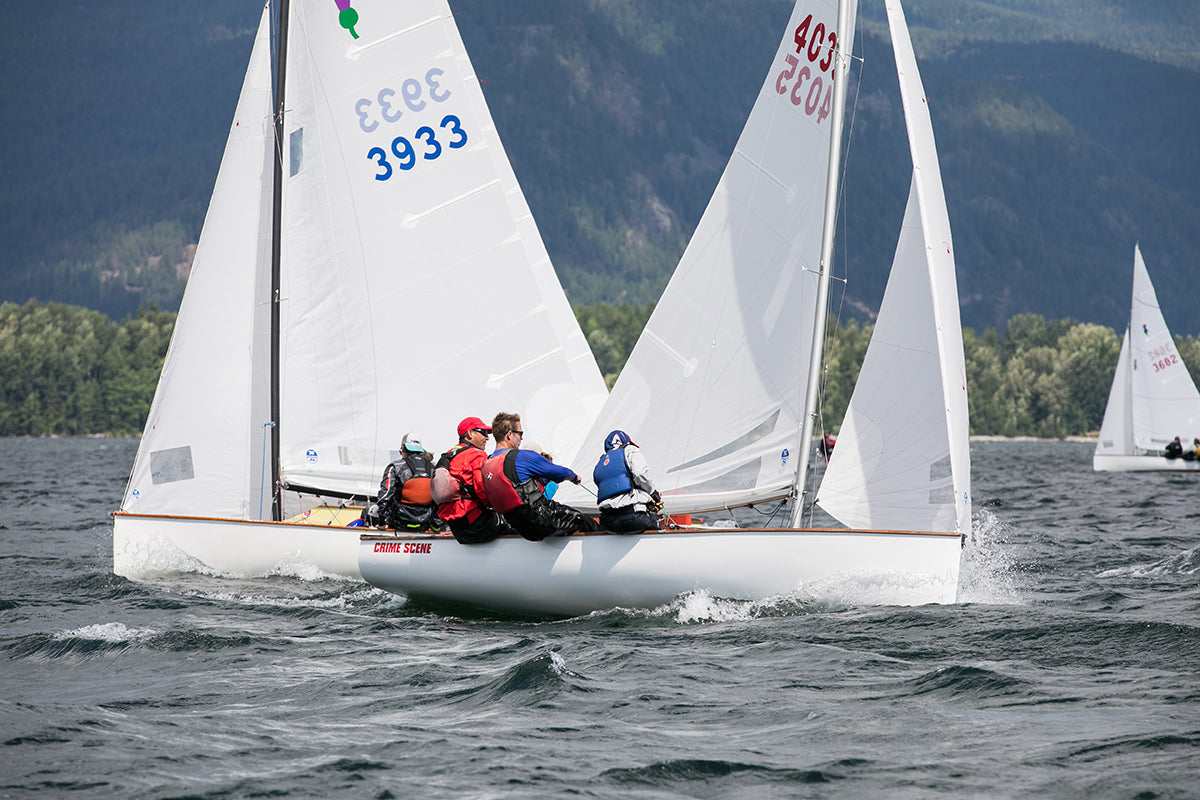
TAKEAWAYS FROM THE THISTLE NATIONALS
TAKEAWAYS FROM THE THISTLE NATIONALS
Breathtaking Venue Delivers Great Racing & Lots Of Fun
North Sails expert Paul Abdullah and team Crime Scene 📸 Paul Bickford
The 2019 Thistle Nationals were held in Sandpoint, Idaho July 20th-26th. Sandpoint is a beautiful resort town located in the Northwest part of Idaho. Wayne Pignolet and his team followed the script: “If you build it, they will come.” They did a fantastic job! The sixty-six teams that attended left with a smile on their face.The Thistle class loves a good destination, and everyone enjoyed the experience Sandpoint had to offer.
On Saturday morning the teams were finding their way through measurement and over to the beach where the boats would be kept for the week. A clinic was postponed until later in the day when the wind was going to be better. North Sails experts Mike Ingham and Paul Abdullah with Greg Griffin provided on the water coaching to the group. Greg and Paul had a little scare when their boat took on some water while trying to rescue a capsized Thistle. They successfully returned the boat to shore. It’s true… You can’t sink a Boston Whaler!
On Sunday the Women’s and Junior Nationals were held. There was a great breeze for four races. Nicole Shedden notched another win to her string of Woman’s Nationals, and Conrad Miller won the Juniors. Congratulations!
📸Mike Jewell | Sandpoint Sailing Association
The Thistle Nationals format is not about winning or leading on the first day, but more about not losing it. The first three qualifying races determine the Championship and Presidents divisions. The Championship fleet has to keep its scores, so points are very important. Doug Kaukeinen was the leader at the cut posting a 1-1-6. As tradition goes, Doug would be passing the Mint Juleps around the awards banquet later in the week.
The Thistle Nationals format is not about winning or leading on the first day, but more about not losing it.
Heading into the last four races, 5-6 teams had a shot of winning the Nationals. Paul Abdullah won race 4 and was leading on the water, but Tom Lawton had a great day and was the leader after race 5 was over. It was all going to come down to the last day, and the field had thinned itself. Tom was leading with Greg Griffin close behind, and then there was 12 and 13 points between 3rd and 4th placed boats. Tom had a bad 6th race and fell a bit, and that left Greg Griffin in a good position going into the last race. Scott Meyer continued to have a solid regatta and was able to fight off Paul Abdullah for 2nd beating him by a point, but it was Greg’s week capping off a lifelong journey to win the Thistle Nationals. Congrats to him and his team, Mark Reddaway and Amy Thompson for accomplishing a dream!
Paul Abdullah’s Takeaways For Success
First And Foremost Is Preparation! I am OCD when it comes to boat prep and making sure that everything works. The last thing I want is gear failure. Make sure the rig is tuned properly after a long cross country trip.
Be Sure The Team Knows Their Roles. In the heat of battle you need to have everyone focus on their job and not get caught up spectating. I know personally that driving fast takes a lot of concentration, and trusting your team allows me to be my best.
Sailing Flat And Fast Was The Key To Our Success. We had great breeze in Sandpoint. Steven (our middle crew) did a great job playing the vang and the jib sheet in the puffs and lulls, and Marie (forward crew) adjusted the jib halyard and main cunningham accordingly. As a team, we kept to boat balanced so we sailed fast instead of fighting it.
North Notes
Fifty-seven out of the sixty-six boats were powered by North fast Thistle sails.
Championship Division: 2,3,4,5,6,7,8 used North Sails
President’s Division: 1,3,4,5,6,7,8,9,10 used North Sails
We are looking forward to the 75th Thistle Nationals in Cleveland in 2020!
Learn more about our fast Thistle designs.
📸Mike Jewell | Sandpoint Sailing Association
📸Mike Jewell | Sandpoint Sailing Association
📸Mike Jewell | Sandpoint Sailing Association
📸Mike Jewell | Sandpoint Sailing Association
READ MORE
READ MORE
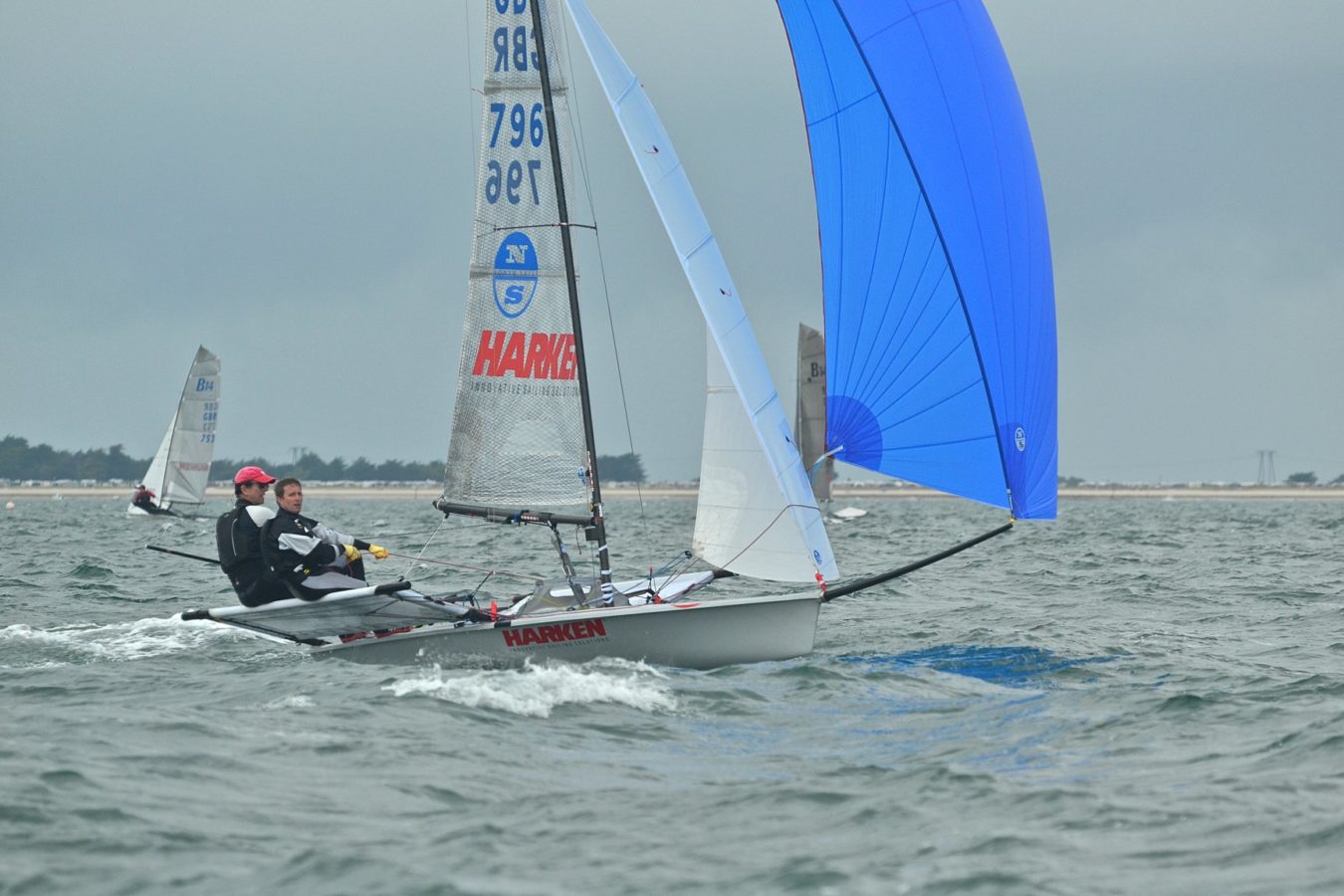
B14 SKIFF WORLD CHAMPIONSHIPS
B14 SKIFF WORLD CHAMPIONSHIPS
North Sails Powers The Podium
B14 World Champions, Nick Craig/Toby Lewis (GBR 796) 📸 Alex Hayes
30 boats met at the Yacht Club de Carnac for the annual B14 World Championships. With close competition all round, particularly for the top ten boats in the fleet, it came down to the last day of racing to determine who would would be fit for a podium finish.
The final day was tense and particularly exciting for the top two boats; current UK National Champions, Nick Craig/Toby Lewis (GBR 796) and Craig Garmston/Louis Chapman (AUS 375). The fleet were held ashore waiting for the wind to arrive and when it did they headed straight out, eager to get two races in before the shortened last day.
In a variable 3-5 knots, race one was straight underway with AUS 375 out in front and Mark Barnes/Charlotte Horlock (GBR 795) chasing closely behind. French team, Alaine Cadre/Francois Cadre (FRA 773) charged up the middle with impressive speed, but they lost out after hitting the windward mark. GBR 795 also had a stroke of bad luck, picking up seaweed on their foils resulting in a tough, slow upwind beat.
Going into the last race, the top two boats were dangerously close in points so the title was all to play for. GBR 796 had a fantastic start coming up the beat in top position with AUS 375 sailing fast, but buried in the fleet. As the race unraveled, the front three remained ahead of the fleet, finishing with GBR 796 taking their sixth bullet of the regatta to win the World Championship title.
Winning team Nick Craig and Toby Lewis raced with a full North Sails inventory, including the LGM-8 Mainsail, LJ-4D Jib and SS-04 Asymmetric Spinnaker.
‘’With eight of the top ten boats racing with North Sails, our B14 sail designs continue to contribute towards winning boat speed and top end results, no matter what the conditions.‘’ Rich Bell, B14 Class Expert.
Browse the B14 Shop Inventory or talk to a Class Expert.
📸 Alex Hayes
Paul Roberts/Rob Taylor (GBR 321) 📸 Alex Hayes
📸 Alex Hayes
📸 Alex Hayes
READ MORE
READ MORE
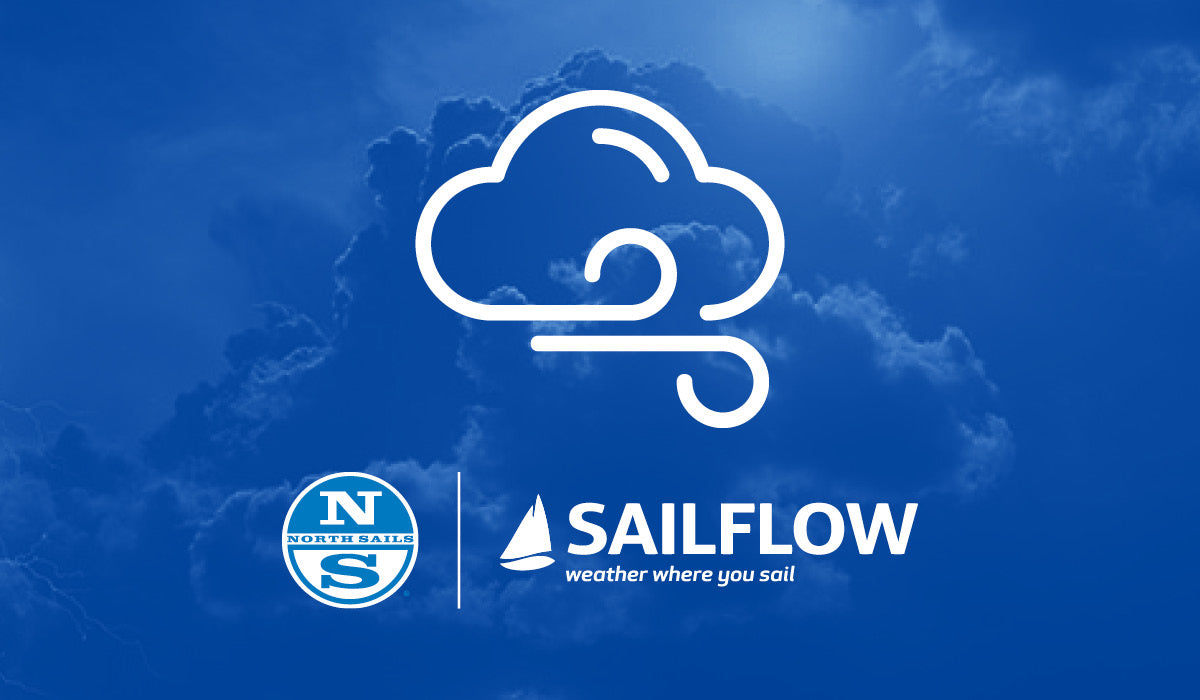
LORC NYC OPEN
LORC NYC OPEN
Sign Up For Your Complimentary Weather Forecast
North Sails is proud to support the 2019 LORC NYC Open. We have teamed up with our expert friends at SailFlow to provide professional weather forecasting for the event. Sign up below and have your forecast delivered right to your inbox.
READ MORE
READ MORE

FASTNET FIRST TO FINISH
#NSVICTORYLIST: FASTNET FIRST TO FINISH
North Powers Early Success Into Plymouth
Records have fallen fast at this year’s Rolex Fastnet Race and North Sails is proud to be a part of our client’s success in the 2019 edition of the historic event. First-to-finish were North powered boats, Maxi Edmond de Rothschild and Rambler 88 who now hold three new race records between them.
Co-skippers Franck Cammas and Charles Caudrelier sailed their North 3Di powered Ultim Maxi Edmond de Rothschild to record-smashing success, claiming both the overall race record and the multihull record to Fastnet Rock. The French duo completed the 605-mile race in 1 day, 4 hours 2 minutes and 26 seconds, breaking the previous multihull record by 4 hours, 45 minutes and 34 seconds.
Cammas and Caudrelier had their work cut out for them in a marathon match race with MACIF, also powered by North 3Di and co-skippered by François Gabart and Jimmy Spithill. “It was a true match race with MACIF, explained Cammas. “We were within 3.5 miles of them, and in sight of each other the whole race. It was so exciting to be able to race this style in very fast giant multihulls. It was intense and the whole crew had to be totally focused. We pushed to the max, and we didn’t get much sleep.”
Rambler 88 was first to finish amongst the monohulls. Owner George David and crew beat a fleet stacked with heavy competition in the 48th edition of this race. Rambler 88 arrived into Plymouth with an elapsed time of 1d 19h 55m 2s- just 1 hour, 16 minutes shy of the monohull race record set by Abu Dhabi Ocean Racing in 2011.
Although they came short of the overall race record, Rambler 88 did set a new monohull record to Fastnet Rock. This is the second time one of David’s race boats has broken that record, rounding the Rock in 2011 at record pace just prior to losing the keel and miraculously having the entire 21-person crew rescued. With the Rock safely behind them, the team was hopeful of an overall race record, but the weather was not in their favor. “Our route plan at the Rock was we would finish at six or seven this morning, which would have been ahead of the record,” explained David. “The problem was we turned the corner at the Scillies and came down the Channel and it was VMG the whole way. So we sailed probably an extra 40 or 50 miles. And that extra distance sailed added maybe another two or three hours on to our time.”
Seeing our clients squeeze every ounce of performance from their equipment motivates all of us at North Sails to build sails that are fast and stand up to whatever Mother Nature serves up. You can track the remaining Fastnet finishers on the Official Race Tracker.
READ MORE
READ MORE
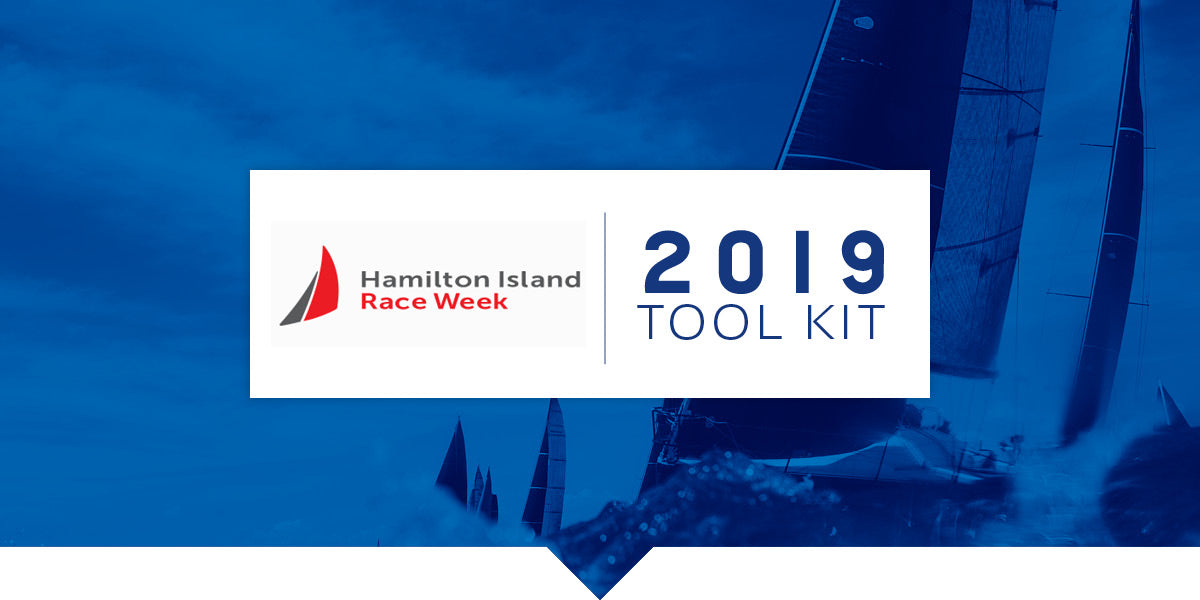
HIRW TOOL KIT
Everything You Need For The Big Event
HIRW is shaping up to be the main event with a total of 225 yachts registered! Divided into six classes, it looks to be a fun and competitive regatta for sailors of all kinds. Get your team race-ready with our tips and tricks to guide you around the race course and prepare your team and your boat for the ultimate racing experience here at Hamilton Island.
Make Sure Your Boat Is Race Ready
With many variables in sailing outside of our control, it is important to make sure your yacht is cleaned, light, and ready to be used with ease once your sails and crew are added.
For The Sake Of Strategy
Familiarize yourself with the anticipated flow patterns around the islands during each race and can be done well in advance of even arriving at Hamilton Island.
Get The Full Scoop On The Starting Area
While it may be scenic, don’t get fooled into thinking it is an easy race track – the islands create localized wind shifts and pressure changes that differ from the big picture prevailing wind, as well as creating some interesting tide challenges.
Know Your Job. Do Your Job.
On board communication for racing yachts is a key factor for performance, no matter what type of sailing. However, when the number of crew increases, it becomes more and more important.
READ MORE
READ MORE

ROLEX FASTNET : HOW TO WATCH
ROLEX FASTNET: HOW TO WATCH
A Record Number of Entries To Set Off In This Historic Race
© Rolex
A record number of entries are making their final preparations in Cowes for the August 3rd start of the Rolex Fastnet Race. This is the 48th edition of Europe’s oldest offshore race, which attracts a range of boats, from local teams competing with their family and friends, to the highest performance multi and mono hull racing machines.
The start line for the 2019 race features numerous high-profile racing programs, many of whom work closely with North Sails to build sail inventories that deliver results. The three largest boats in the 2019 fleet are the 100’ Scallywag, Thomas Coville’s new 105’ Sodebo Ultim 3 and George David’s Rambler 88, all of whom have chosen North Sails 3Di to power their performance. Our design and engineering team will also be tracking the performance of a handful of North Helix sails across a range of boats throughout the fleet. The most recent #NSVictoryList for Helix comes from 2019 Fastnet entry VO70 Wizard, who used the specialized sail structure in their recent Transatlantic Race win.
The first start sequence begins at 12:30 local time and will see boats and crew representing 26 countries head westward down the Solent before exiting the English Channel and sailing towards the turning point at the famous Fastnet Rock. The history of this race is quite extraordinary, and crossing the finish line in Plymouth is an accomplishment in itself. This 605 nautical mile, non-stop offshore challenge is known to be one of the hardest sailboat races in our sport, with westerlies that can trigger gale force winds and meteorological disturbances that all competitors should expect to endure. The keys to winning are perseverance and getting ahead of the weather, and in some cases, using it to your advantage.
Here are some ways you can follow the race, no matter where you are in the world.
Live Stream The Start: Saturday 3 August
The entire start sequence will be streamed online from the official website and on Facebook Live.
Fastnet Website and Race Tracker:
Latest press releases, race news, images, video, tracking, Live Blog and the Virtual Regatta can all be found on the dedicated race minisite: www.rolexfastnetrace.com
All boats will be fitted with a fleet tracker: http://www.rolexfastnetrace.com/competitors/race-documents/fleet-tracking
Social Media:
Follow all the action on RORC social media: Don’t forget to tag your photos and videos with the official race hashtag, #RolexFastnetRace
The starts sequence will be streamed live on RORC Facebook and follow via the Royal Ocean Racing Club Social Media Channels.
You can also follow us on social, @North_Sails on Instagram and @NorthSails on Facebook.
Watch on BT Sport:
You can watch the start of the Rolex Fastnet Race from the comfort of your home with three hours of live coverage broadcast on BT Sport, the home of the 2019 SailGP series and 2019 Rolex Fastnet Race. Beginning at midday local time, BT Sport’s specialist sailing team will bring all the build-up, the race start and the first phase down to The Needles with live helicopter and chase boat coverage and commentary from experts and guests. This will be broadcast simultaneously on the RORC’s website, YouTube channel and Facebook, as well as The World Sailing Show YouTube channel.
Fastnet Radio:
Follow the Rolex Fastnet Race with full coverage on Fastnet Radio. Previews of the race from 29th July on the extended Cowes Radio 87.9fm, with full live commentary and coverage of the starts on Saturday 3rd August, as well as during the race and right up until the Prizegiving on Thursday evening, 8th August. Fastnet Radio 87.9fm will broadcast 24 hours a day in Plymouth, live from the docks with all the breaking race news, features and link-ups with race teams out on the course and online: http://www.879fm.uk/
READ MORE
READ MORE
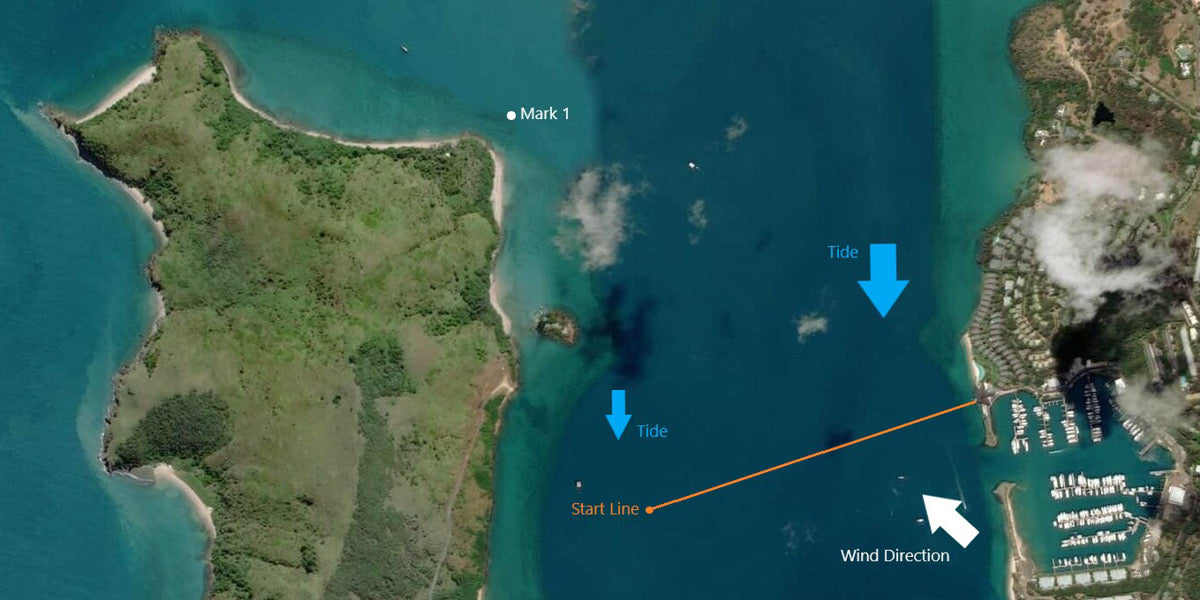
HIRW: STARTING STRATEGY
HAMILTON ISLAND RACE WEEK: STARTING STRATEGY
Pre-Race Homework Is Key
Dent Passage is one of the world’s most picturesque start lines. Surrounded by the Hamilton Island Yacht Club, the Golf Club on Dent Island and the beautiful water the Whitsundays are famous for, it’s easy to understand why Hamilton Island Race Week has such a strong following. While it may be scenic, don’t get fooled into thinking it is an easy race track – the islands create localized wind shifts and pressure changes that differ from the big picture prevailing wind, as well as creating some interesting tide challenges. Let’s have a look at the Dent Passage starting line and think about some of the factors that will go into choosing the best starting strategy.
Find out as much as you can before you get there. A quick look at the historical wind data for Hamilton Island in August shows 72% of the time the wind is in the South-Easterly quadrant. We can also find out what the tide times are for the week of the race, which you can see below.
Putting together these two pieces of information, we can start to map out what the starting situation will look like well before we are even at the venue. Assuming that the start times are around the usual – 11am – there’ll be an incoming tide at the start every day except the last day, which will be slack tide. Around this area, the tide floods to the south, and ebbs towards the north.
Let's map out the information we have so far.
As we can see on the chart, with the wind coming from the South-East and us racing towards the North, the TWA will be anywhere from 170 – 100 on Starboard tack. This means we will be using either a spinnaker or Code Zero to get us to the top corner of Dent Island – our first turning mark. We also know that the tide will be pushing us backwards, so getting out of it will be important - especially in light winds. Here's a checklist of the things you can to do on race day to make sure you are as prepared as you can be:
Wind Check
For a Dent Passage start, it is always a good idea to motor over to the NW corner of Dent Island before the start to check how the start line wind compares to the big picture wind in Dent Passage. This is important because it will tell you which sail combo you’ll be using as you around the island and during the next leg.
Tide & Depth Check
On your way back to the starting area, take note of how fast the tide is moving. You’ll be able to tell this by comparing your speed through water to your speed over ground. If your speed over ground is faster than your speed through water, the tide is going with you and vice versa. You’ll often find that there is less tide pushing you backwards on the edges of the course, but it’s a very good idea to check the depth along the Dent Island shoreline if you think you might go that way, there are some shallow spot along the shore that you might not see on a chart – very important to know if your particular boat can go there or not!
Start Line check
Once we are back at the start line, check the TWA and distance to the first mark – either using a navigation program like expedition or manually by sailing to each end of the line and checking the
wind. Comparing this information to the big picture wind will help choose which sails you’ll use at the start and into the next leg. It’s important here to take into account your crew’s ability, there’s not much point planning to peel from the Code Zero to A2 if you and your crew have never practiced it before.
Getting a transit
Well before your start, get a 4 boat length transit – that is – a transit that your bowman can use to tell you that you are 4 boat lengths below the line. Do this by slowly motoring up towards the pin end, when you think you are 4 boat lengths away get your bowman (standing on the bow) to look through the Hamilton Island Yacht club mast to the land behind. Remember the object, it could be a particular tree, or maybe a house. Once you’ve got this transit, keep motoring towards the eastern end of the line and get another transit when the bow of the boat is at the pin, this is your start line transit, so you’ll know exactly when the bow of the boat is on the line.
Pre-start
Get your strategy sorted nice and early, and make sure everyone on the boat knows the plan. There’ll be lots of boats around so stay out of the chaos of the people starting before you. Assign someone on the boat to keep an eye on how far from the line you are from at least 10 minutes until your start. With the tide pushing you away from the line, the last situation you want to find yourself in is 5 minutes away from the line with 4 minutes to go!
The best strategy is usually a simple one...
Don’t over complicate it! It is simply a matter of prioritizing the information you have to make the correct decision. Don’t forget, strategy is the fastest way to the next mark in the absence of other boats. Tactics are how you manage all the other boats in your way. There’s no point starting at the pin end with 30 other boats all going nowhere!
READ MORE
READ MORE
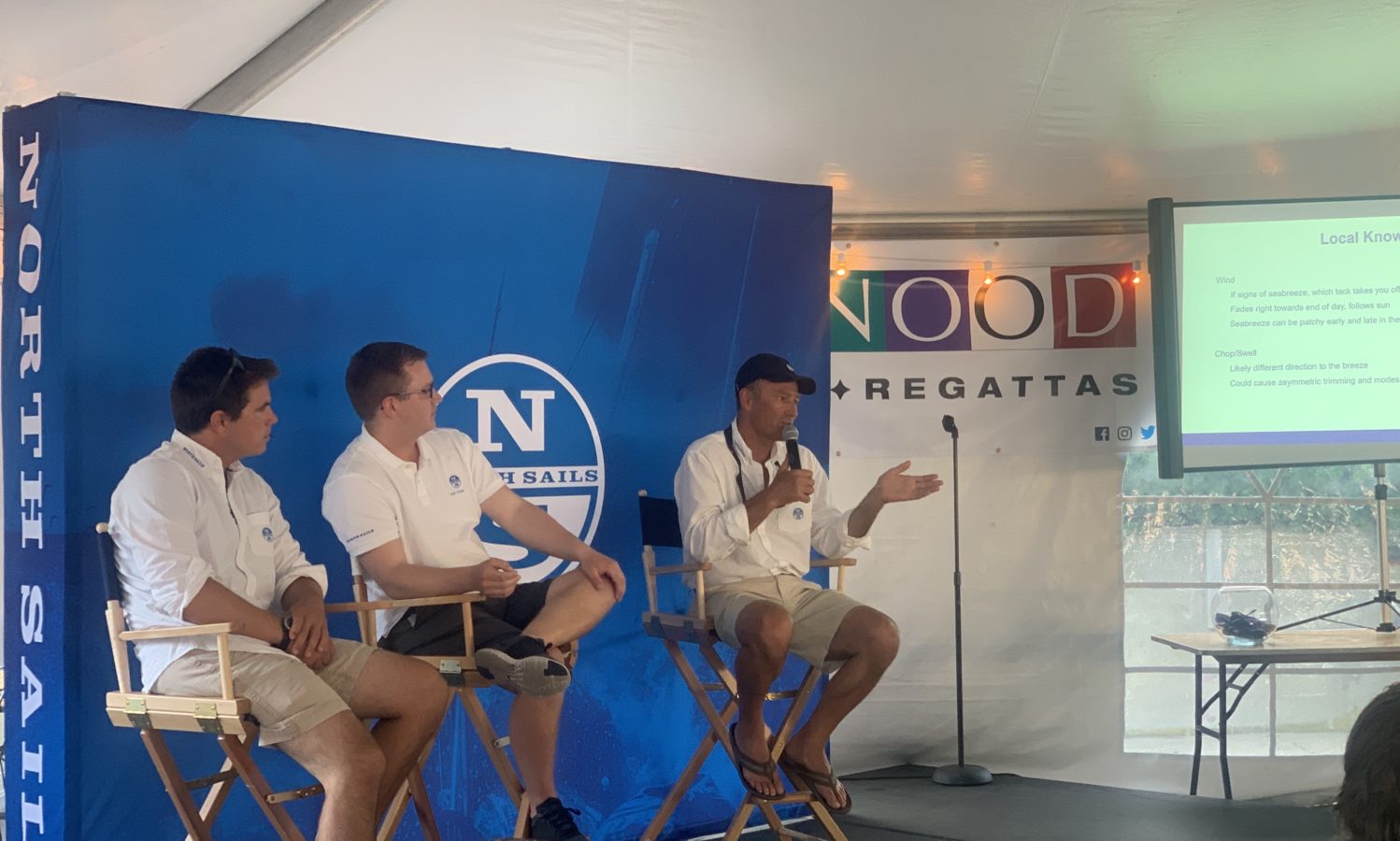
HARD WORK PAYS OFF AT THE HELLY HANSEN NOOD REGATTA IN MARBLEHEAD
FINISHING THE CIRCUIT ON A HIGH NOTE
Crews Battle It Out In Competitive One Design Heats & Tricky Currents
The Helly Hansen NOOD Regatta at Marblehead Race Week was the final event on the 2019 NOOD race circuit before the Caribbean Championship in the fall, and it did not disappoint. Light air at times and challenging currents had over 170 teams fighting it out in the blistering heat at one of New England’s most idyllic summer destinations.
Kicking off the event, North Sails experts hosted a Local Knowledge panel on Thursday evening at Boston Yacht Club. Led by JB Braun, North's Director of Design & Engineering and one of the world’s leading sail designers, the North team set out to provide useful tips and insight for the weekend of sailing. Combining weather forecasts, tidal trends and their experience of racing in the area, Norths experts laid out their goals for the regatta, what to look out for on the water, and how they would be navigating the set courses. Joining JB Braun on the panel was local expert Alex Cook and One Design World Champion Mike Marshall. Alex, based in the North loft in Salem joined the North Sails team in May 2019 and brings a wealth of local knowledge to the Northeast team.
North's Local Knowledge Panel (From left to right: Mike Marshall, Alex Cook, JB Braun)
Temperatures topping 85 degrees added an extra layer of pressure to crews over the 10 One Design fleets. Wind conditions varied throughout three days--8-12 knots Friday from the East, 12-15 knots on Saturday from the ESE, 5-10 knots on Sunday from the SSE--a 1.5-knot current ripped across the course every single race, varying in strength and direction.
Taking advice from the North Sails Local Knowledge briefing, held on Thursday at BYC, many crews watched the lobster buoys to learn as much as they could to use the current to their advantage. Many fleets had trouble crossing the line, and on Sunday, three fleets in a row had the left-most boat hit the pin, and most struggled to cross the line on starboard. At the beginning of the day, the current ran right to left, making layline calls relevant. Many teams found the key to a successful beat was short-tacking the port layline. Those boats that tacked on the layline from far out ended up overstanding the windward mark. For the boats tacking short of it, they ended up right on the layline by the time they reached the top-end of the course. As the current flooded, this made speed and time off the line crucial.
"It was an atypical Marblehead NOOD in the sense that there was good breeze all three days, no drifters or Nor'Easters. However, it was typical Marblehead conditions, on the Halfway Rock Line, with the left side of the course being favored early in the sea breeze direction, along with the current running and affecting lay-lines. We also saw the usual chop/swell off axis from the breeze, making it much more challenging for skippers on one tack versus the other."
Alex Cook, North Sails Salem
Day one and three of the regatta where the wind was lighter, being in pressure paid off more than being on the lifted tack, so teams did not tack too much. At some points, it paid off, and gains were made by managing the fleet, and sailing on a header to match the other boats because there was more pressure. Trying to stay on the tack pointed directly at the mark (or jibe) also benefited certain teams.
Speaking on managing the courses, North Sails Hillary Noble, tactician onboard the J/24 Sea Bags, had the following observations: “Downwind laylines were just as crucial as upwind. Tacking short of the layline upwind allowed us to get ahead of those who waited, as they were overstanding by the time they reached the top. Not jibing too early at the offset helped us by being one lane further downwind. The boats that jibed right away ended up fighting eachother to stay high, sailing more distance, an we were able to stay away from that. The current was strong, coming in for the better part of each day and was constantly pushing us away from the gates as the course was skewed. Jibing later for the gate, coming in with speed, and rounding the mark that had most pressure kept us clear ahead and allowed us to keep our speed for the mark rounding."
"The entire time all I could think about was our boat speed. Our North Sails FR-2 spinnaker was a main contributor to our speed off the wind and allowed us to stay ahead of the fleet."
The crew of the J/24 Seabags embarking on their fifth season together.
North Sails client Bruce Stone & Nicole Breault on J/105 Good Trade took the win in their class, never leaving the top three positions in all nine races over the weekend. The 2.4m class saw North clients claim 1st and 2nd on the podium, with Charles Rosenfield on 2.4mr (Para) taking the win followed closely by Theodore Green on Magic Bus.
North Sails JB Braun seemed to take heed of his own advice as he claimed six bullets out of nine races, winning the Laser class. In the J/70 Corinthian class, Brian Keane and his crew onboard Savasana finished on top of the leaderboard, adding to Brians many regatta victories over the years, including the J/70 U.S Winter Series and a second place at the 2017 J/70 World Championships.
Full results from the Helly Hansen NOOD Regatta at Marblehead Race Week can be found here.
READ MORE
READ MORE
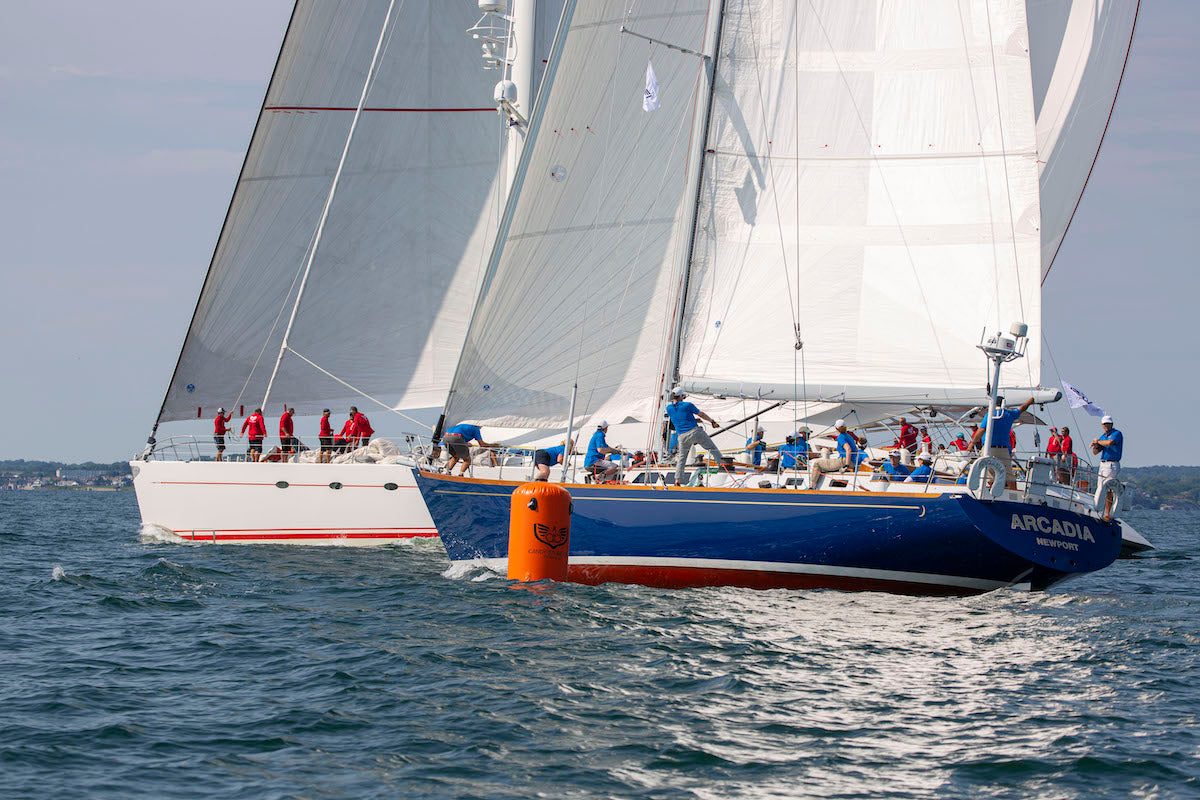
NORTH OUTFITS WINNER OF 2019 CANDY STORE CUP
SIRONA’S SWEET SUCCESS
North Sails Outfits Overall Winner Of The Candy Store Cup
📸 Billy Black
Congratulations to Sirona who went home with all the candy and champagne at the Candy Store Cup Regatta. The 22m Sloop was named the overall winner of the Newport, Rhode Island-based event, co-hosted by Bannister’s Wharf and the Newport Shipyard. North Sails contributed to the success of six podium positions across three classes and in all powered nine of the twelve yachts racing in Newport.
North superyacht expert Mike Toppa sailed on the 56m Perini Zenji, a multi-year Candy Store Cup entry for the two days of racing on Rhode Island Sound. “The race committee did a great job of arranging the course with a far turning mark at First Beach with the leg back to the finish touring the famous Ocean Drive coastline. Wind conditions were on the light side but Newport delivered and the sailing was fantastic. I saw a lot of smiles on the dock at the end of both days of racing.”
📸 Billy Black
North Sails has been a partner to the Candy Store Cup since 2016. The event carries on the tradition of the Newport Bucket and is a ‘must-do’ regatta for superyachts spending their summer on the East Coast USA. The two-day regatta kicked off with an owner’s party at the popular Clarke Cooke House, followed by two days of competitive racing.
“Partners like North Sails make the Candy Store Cup possible,” remarked Veronica Brown, head of marketing for Newport Shipyard and event coordinator for the Candy Store Cup. “Our goal has always been to carry on the tradition of the original Nantucket Bucket style of racing by keeping it fun, casual and light-hearted. The owner and crew-friendly environment, based out of a working shipyard, creates a sailing event that is unique to superyacht racing. We look forward to growing this event with North Sails’ support for years to come.”
📸 Billy Black
📸 Billy Black
READ MORE
READ MORE
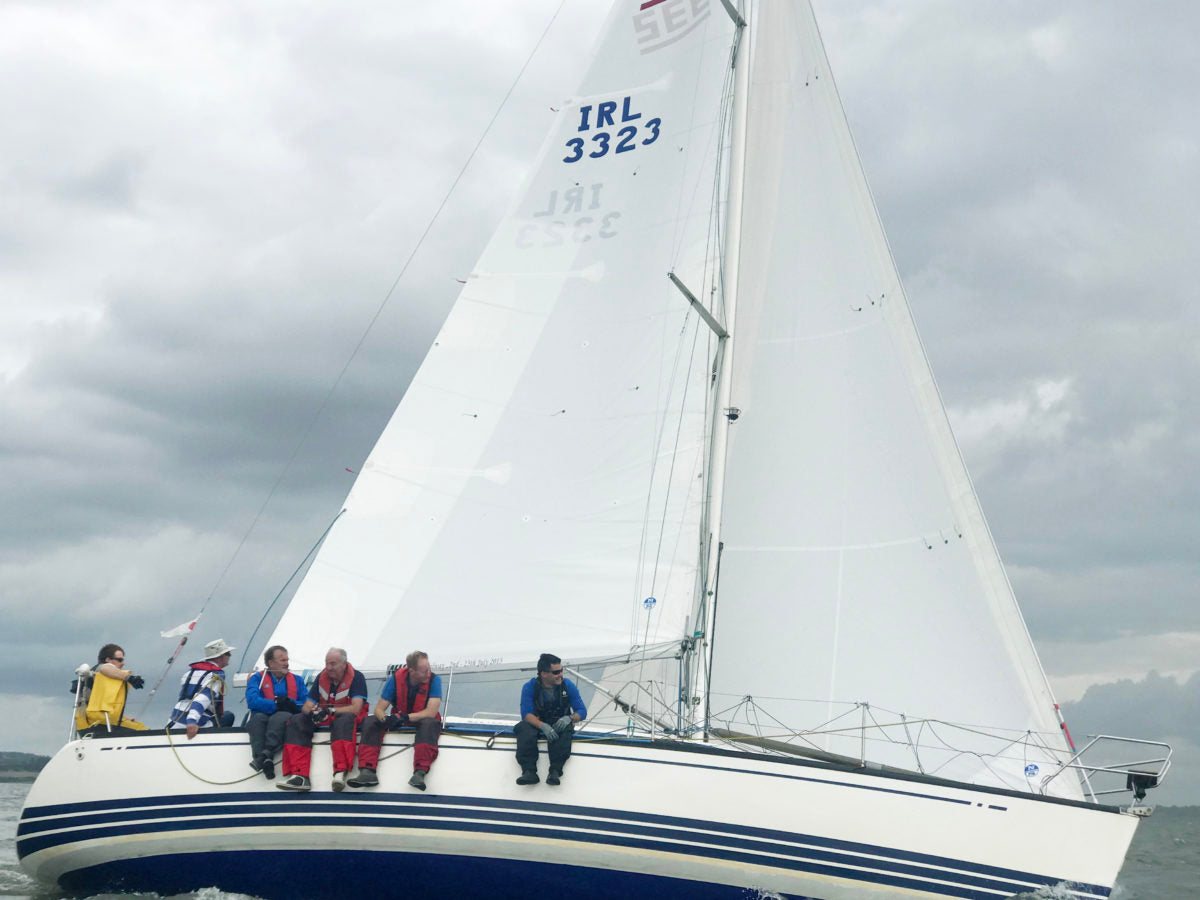
WIORA WEST COAST CHAMPIONSHIPS 2019
WIORA WEST COAST CHAMPIONSHIPS 2019
North Sails Ireland Proud Supporters
Class 1 IRC Overall Winners, Dexterity 📸 James Young/Young Productions
North Sails Ireland were proud to support the WIORA West Coast Championships 2019 hosted by Foynes Yacht Club (FYC).
Having sailed in several WIORA regatta's in the past, One Design Expert and founder of North Sails Ireland, Nigel Young looked forward to getting back into the fleet this year in Foynes at such a welcoming club. With the great opportunity to sail onboard the X-332 Dexterity, Nigel talks about their victory in the long race:
“I had the pleasure of sailing the long race with Liam Madden and the crew on X-332 Dexterity. We had a cracking start and challenged for the lead around the course. Racing in the Shannon requires a good understanding of the tides and knowing when to change sides in the river to take full advantage of the currents. This is always tricky to get 100% right on the day, but the speed generated from the new North Sails fitted a few days prior to the regatta carried us through to the win. I was delighted to play a small part in the overall Class win for Dexterity.”
“The speed generated from the new North Sails fitted a few days prior to the regatta carried us through to the win. I was delighted to play a small part in the overall Class win for Dexterity.”
When not competing, Nigel and son James were on the water videoing the racing, using this footage to run a post-racing debrief session for competitors. James shot some fantastic drone footage of the fleet coming through the narrow channel between the club and Foynes Island.
Congratulations to all involved for making the regatta a great success; we are already looking forward to a repeat session next year.
See the full list of results or visit the North Sails Ireland loft page.
📸 James Young/Young Productions
📸 James Young/Young Productions
READ MORE
READ MORE
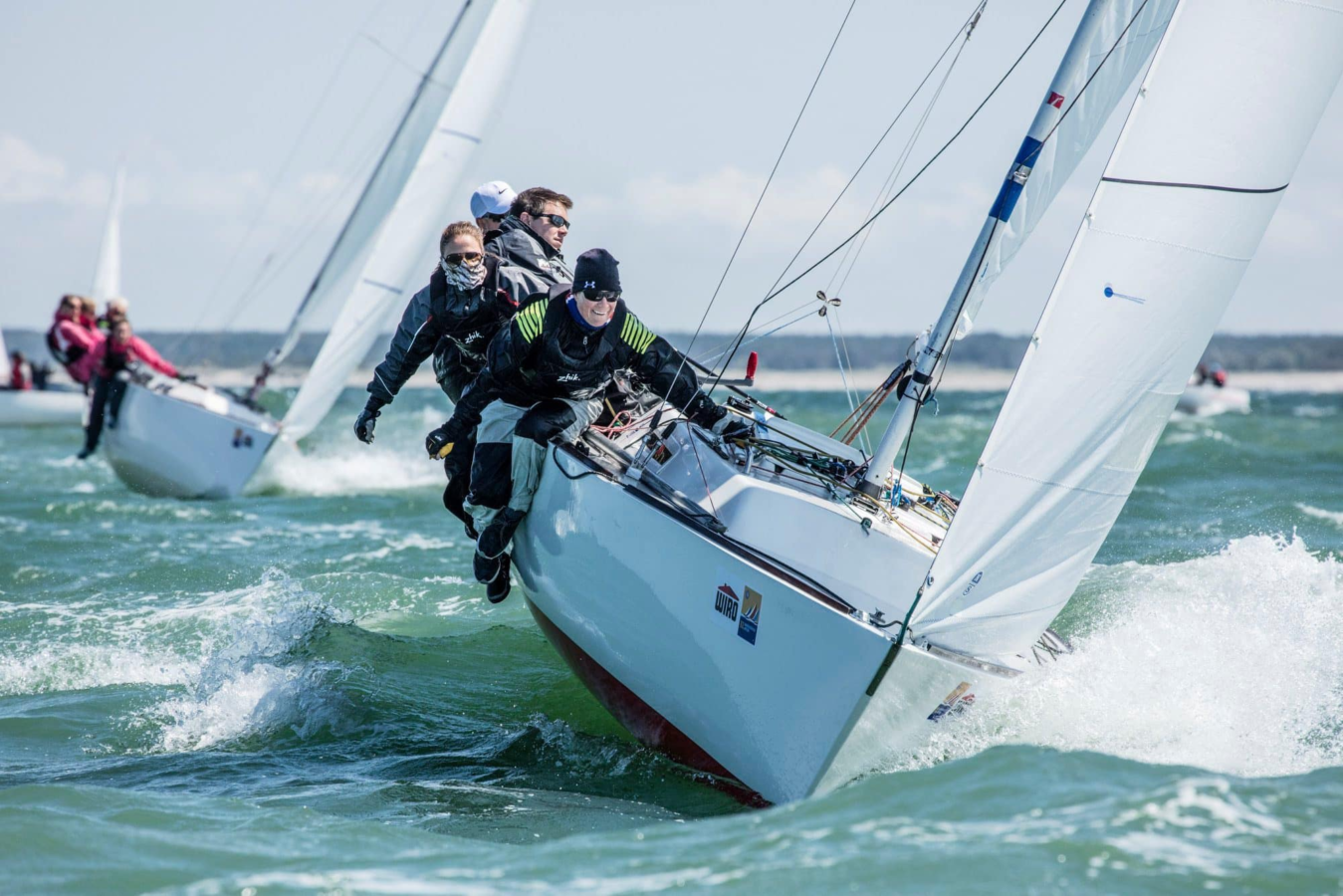
LESSONS LEARNED FROM ROUNDING FIRST
LESSONS LEARNED FROM ROUNDING FIRST
Mike Marshall Explains Two Mental Traits That Will Help You Stay Ahead Of The Fleet
2019 J/22 Worlds 📸 Pepe Hartman
Three years after winning the 2016 J/22 Worlds, I signed on as a trimmer for the 2019 World Championship. I knew crewing would be a fresh challenge, and I was excited to help further raise the game on Raised J, owned by John Koppernaes, a team I’d sailed with in 2017.
This year’s Worlds were in Warnemunde, Germany, and our preparation strayed far from the original plan; all our practice days were blown out, so the practice race was basically our first outing—on an unproven, bottom-painted, charter boat.
What a surprise, then, to find ourselves rounding the first mark in… first.
That evening, I talked through our best approach to the regatta. “We’ve got great boat speed,” I said. “Now we just have to believe in ourselves, and know that we deserve to win.”
Sure enough, the next day we rounded the top mark in first once again—but were soon passed by the eventual regatta winners. Without being on the wrong side of a shift, what happened? Looking back in time a bit, Raised J had a tough event in the light and shifty conditions at the 2018 Worlds, and we all tend to set our future expectations by our most recent results. So this year, as soon as we rounded that first mark ahead of 30 other J/22s, the energy and excitement onboard climbed way too high. “Wow! We’re winning a race! At the World Championship!”
What we should’ve been telling ourselves instead was to keep calm, sail well, and stay in the lead—that we deserved to be there.
📸 Pepe Hartman
If turning a great start into a mediocre result sounds all too familiar, here are two traits to work on before your next big regatta.
Trait #1: Confidence
Confidence is the biggest mental asset a team can bring to the race course. Confidence in your starting ability gives you an edge over the boats around you. Confidence in your boat handling makes it possible to react more quickly to other boats’ mistakes. If you lack confidence, you may not even recognize another boat’s mistake and capitalize on it, because you’ll be too busy questioning your own abilities to recognize the errors of others—especially if it’s a top rival.
Confidence also leads to more rational decisions. If you are sure of your boat speed, you’ll be able to look past the bad shift you’re in or the bad waves you’ve just encountered. You’ll think to yourself, we’re fast, and everyone else also hits unfavorable shifts and waves. We just have to deal with these factors better than they do. Without this basic belief in your own abilities, a single wave can cause you to dramatically change the way you’re sailing the boat, making you even slower. Sure of your own skills, you’ll have fewer doubts and more definitive decision-making, which will actually make it easier to race well.
Trait #2: Learn From Mistakes
Another essential mental asset is identifying and admitting your mistakes. As cliché as it sounds, admitting that you’ve made a mistake is the first step toward moving past it. Analyze what you’ve done wrong, and have a plan to make sure you don’t make that same error again. Everyone makes mistakes, but your top competitors work hard to only make each mistake once.
Putting It All Together
Rounding first at the first mark in a World Championship proved we had equal skills and speed with the top contenders. The only thing we lacked was confidence in our own abilities. Instead of wondering how we got there, we should’ve focused on perfecting the rest of the race. Instead of getting excited, as if this great rounding was largely due to luck, we should’ve concentrated on minimizing mistakes—and learning from the ones we did make.
Sailboat racing is unique in many ways, but its mental side is the same as other sports. If you listen to top athletes around the world, you can hear in their voices the knowledge that they deserve to be at the top—as well as the humility that comes from working extremely hard to get there. We all need to keep learning, but we also need to develop the mental skills to stay on top after a great first beat.
📸 Thomas Hanf
READ MORE
READ MORE
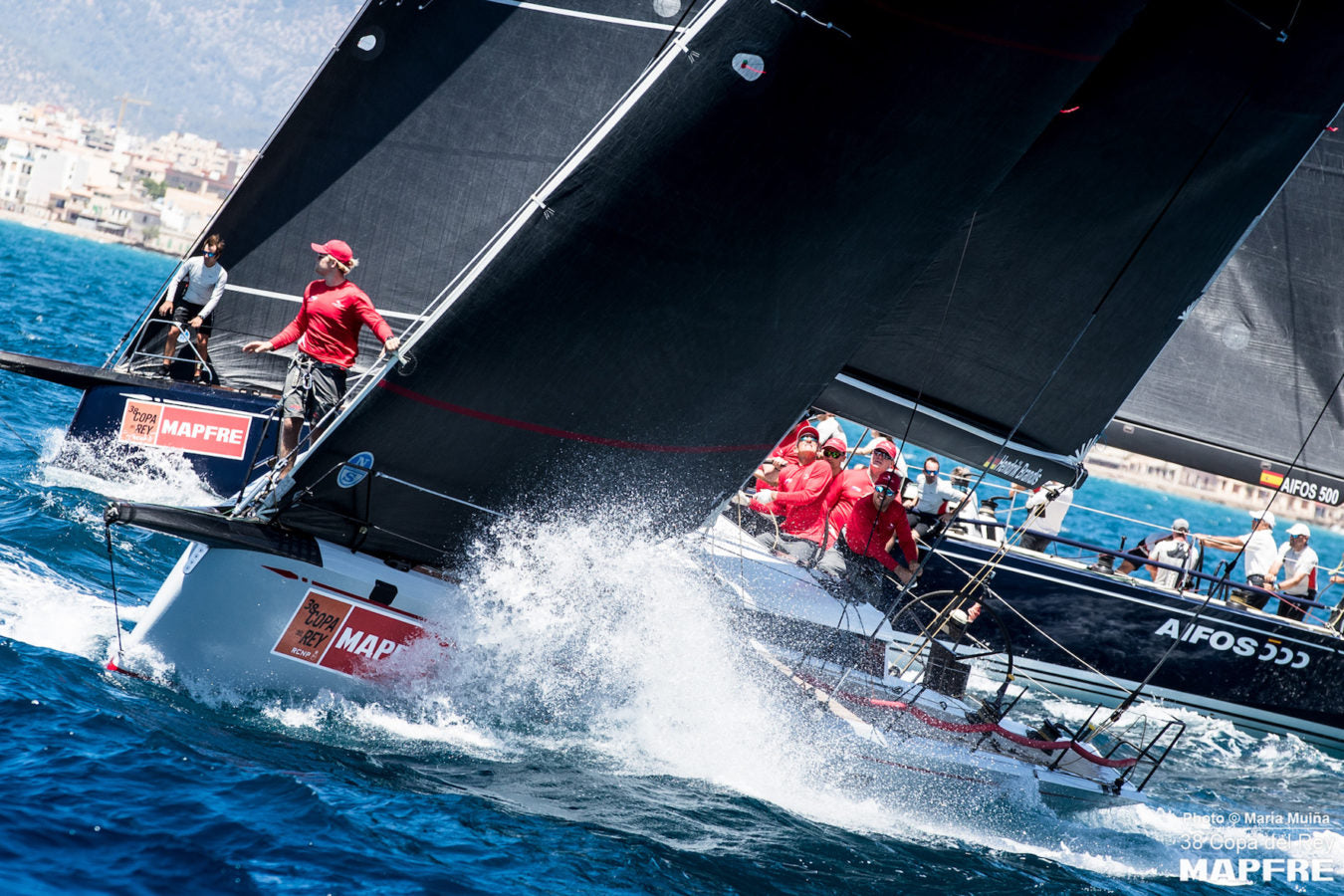
LA VELA DE LA COPA DEL REY MAPFRE
North Sails regresa a la Copa del Rey MAPFRE con intención de incrementar el espectacular palmarés de sus clientes, que en 2018 ganaron 11 de los 13 títulos en juego.
READ MORE
READ MORE
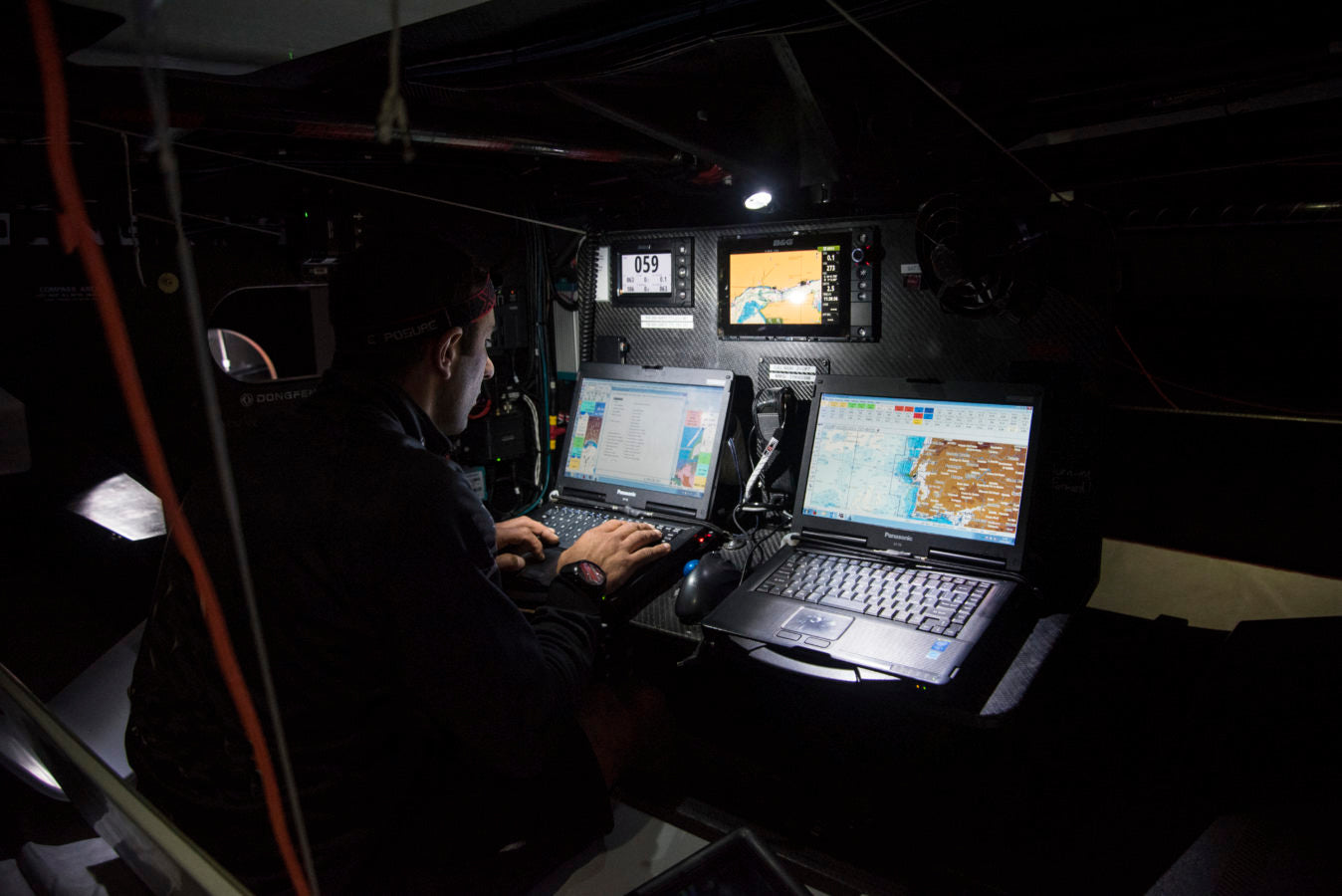
Consejo North Sails
CONSEJO NORTH SAILS
Hoy Hablamos de Electrónica a Bordo
Tanto en un barco de competición como en un barco de crucero, es importante realizar un correcto mantenimiento de la todo el sistema eléctrico. Para evitar sorpresas desagradables, conviene revisarlo con regularidad y asegurarse de que la electrónica está correctamente calibrada. El mantenimiento debe incluir desde la batería y los conectores, hasta el cable de conexión de la percha con el hardware del sistema, ya que cualquier defecto puede provocar una caída del sistema. Y recordad que el salitre es enemigo de la electrónica: evitar que se acumule es a veces tan sencillo como pasar un paño húmedo con agua dulce.
Para más información, contacta con tu agente North Sails, visita www.northsails.com o escríbenos a info@es.northsails.com
READ MORE
READ MORE
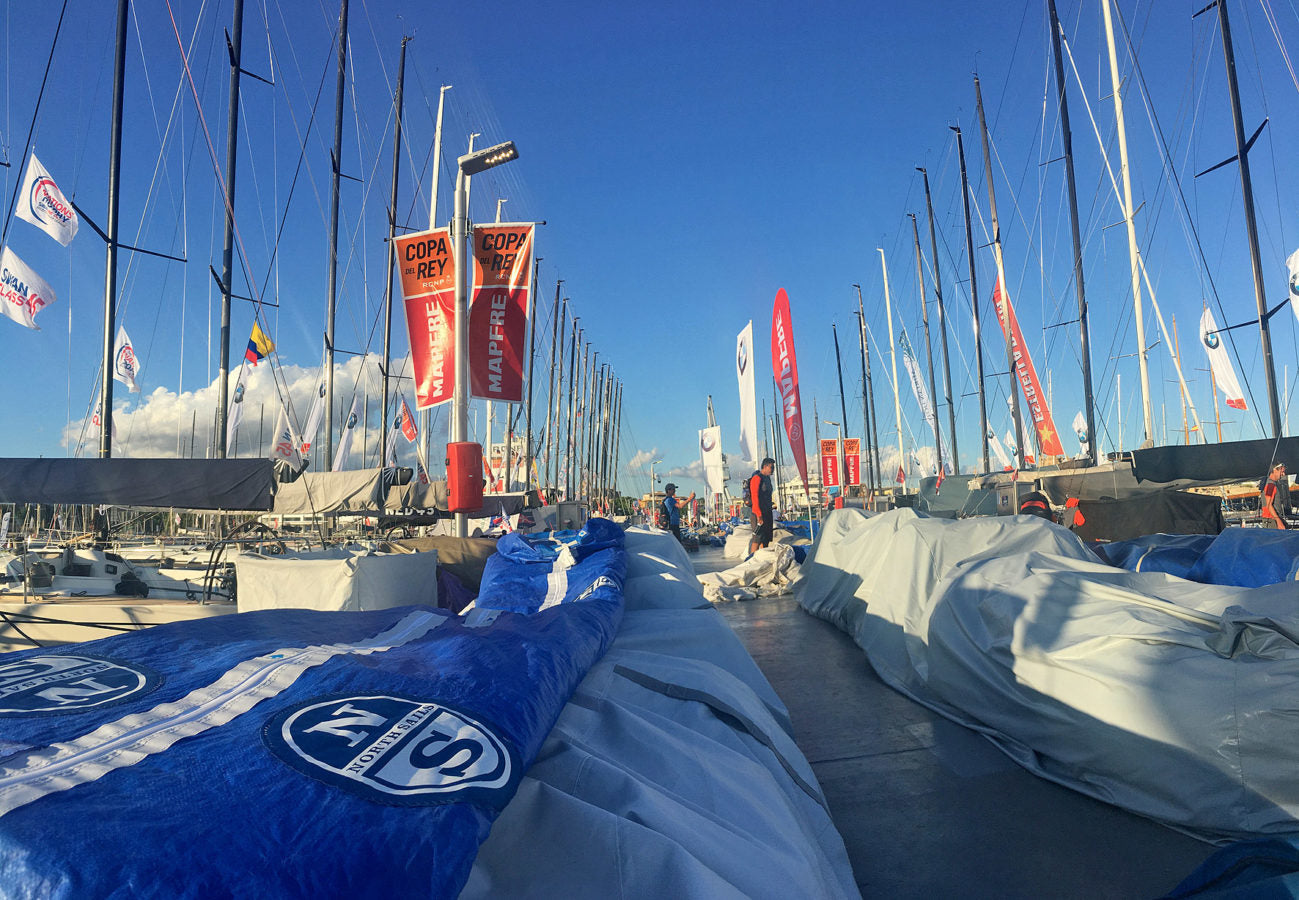
CALENDARIO AGOSTO
CALENDARIO AGOSTO
El mes de agosto comienza para el equipo North Sails participando en la 38 Copa del Rey MAPFRE (27 de julio a 3 de agosto). Del 11 al 14 de agosto, expertos de la velería estarán en Melilla con la Semana Náutica de Melilla; del 14 al 17 de agosto, en Mallorca para la XXV Regata Illes Balears Clàssics; del 14 al 18 de agosto, en el Puerto de Santa María para la 48ª Semana Náutica; y del 27 al 31 de agosto en la Copa del Rey Clásicos. No dudes en contactar con ellos para resolver cualquier duda relacionada con las velas de tu barco.
READ MORE
READ MORE


